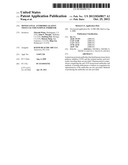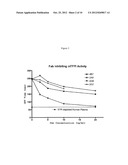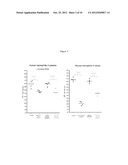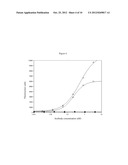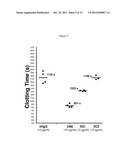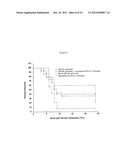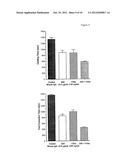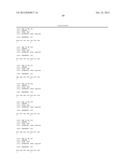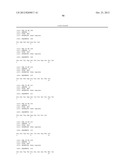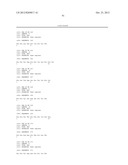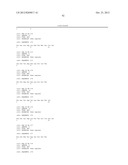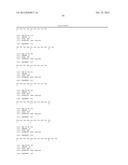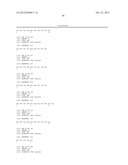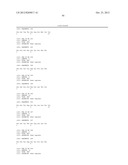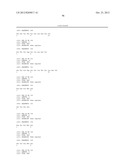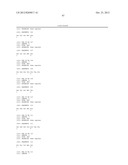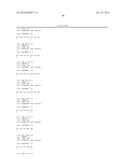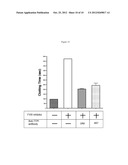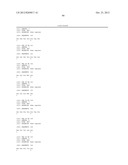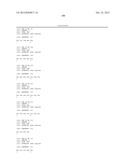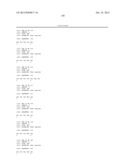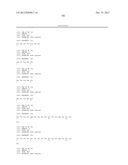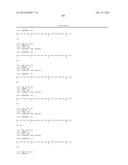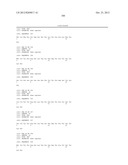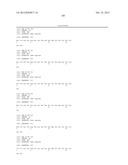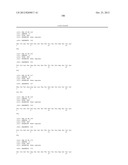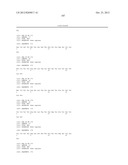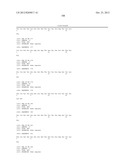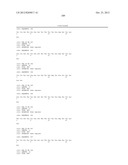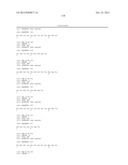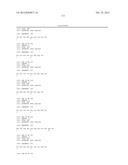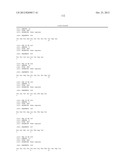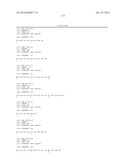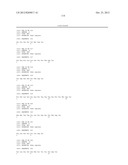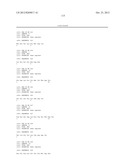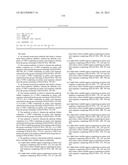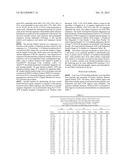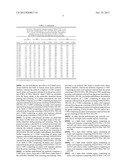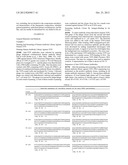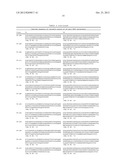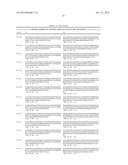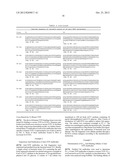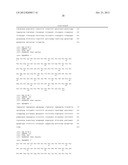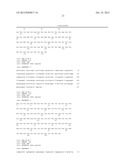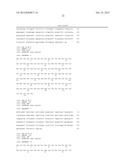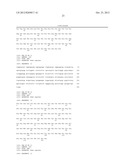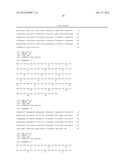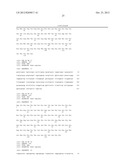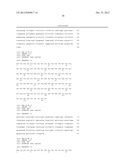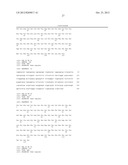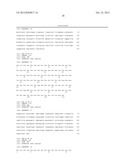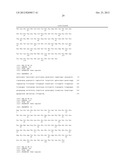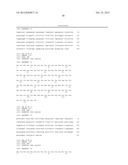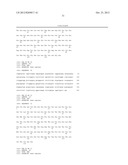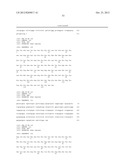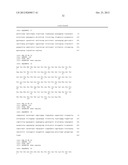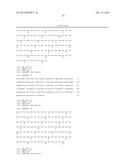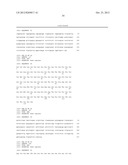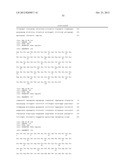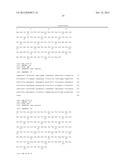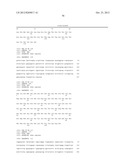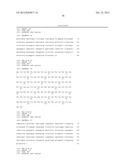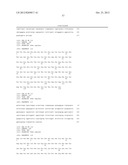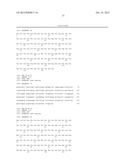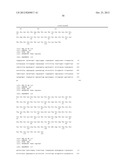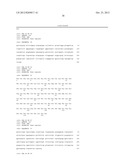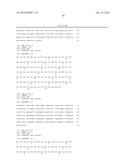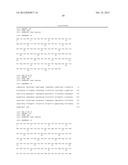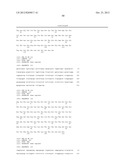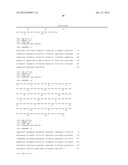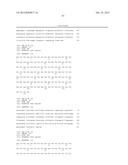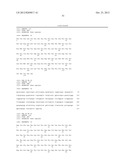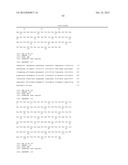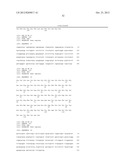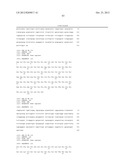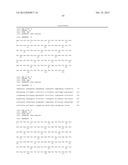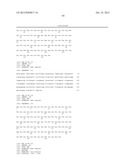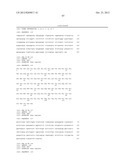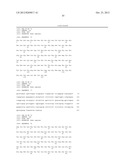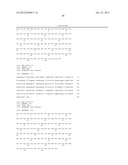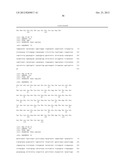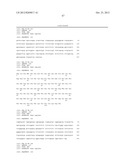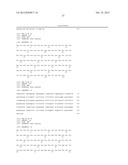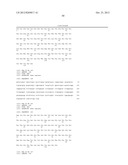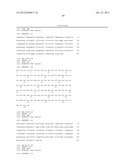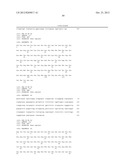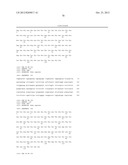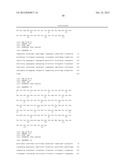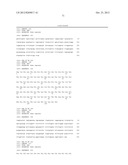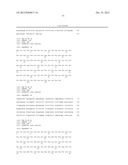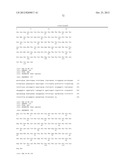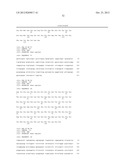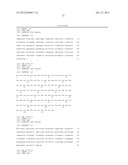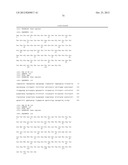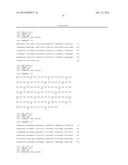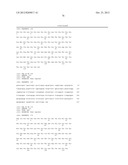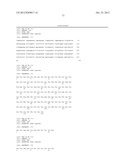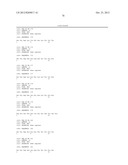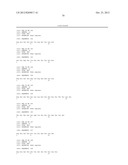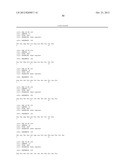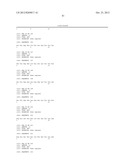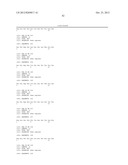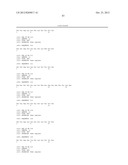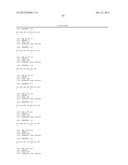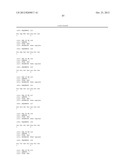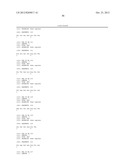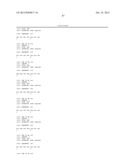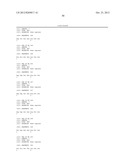Patent application title: Monoclonal Antibodies Against Tissue Factor Pathway Inhibitor
Inventors:
Zhuozhi Wang (Burlingame, CA, US)
John E. Murphy (Berkeley, CA, US)
John E. Murphy (Berkeley, CA, US)
Junliang Pan (Moraga, CA, US)
Haiyan Jiang (San Francisco, CA, US)
Bing Liu (Richmond, CA, US)
Assignees:
BAYER HEALTHCARE LLC
IPC8 Class: AA61K39395FI
USPC Class:
4241421
Class name: Immunoglobulin, antiserum, antibody, or antibody fragment, except conjugate or complex of the same with nonimmunoglobulin material monoclonal antibody or fragment thereof (i.e., produced by any cloning technology) human
Publication date: 2012-10-25
Patent application number: 20120269817
Abstract:
Isolated monoclonal antibodies that bind human tissue factor pathway
inhibitor (TFPI) and the isolated nucleic acid molecules encoding them
are provided. Pharmaceutical compositions comprising the anti-TFPI
monoclonal antibodies and methods of treating deficiencies or defects in
coagulation by administration of the antibodies are also provided.
Methods of producing the antibodies are also provided.Claims:
1. An isolated monoclonal antibody that binds to human tissue factor
pathway inhibitor, wherein the antibody comprises a CDR3 comprising an
amino acid sequence selected from the group consisting of SEQ ID NOs:
388-430.
2. The isolated antibody of claim 1, wherein the antibody further comprises (a) a CDR1 comprising an amino acid sequence selected from the group consisting of SEQ ID NOs: 302-344, (b) a CDR2 comprising an amino acid sequence selected from the group consisting of SEQ ID NOs: 345-387, or (c) both a CDR1 comprising an amino acid sequence selected from the group consisting of SEQ ID NOs: 302-344 and a CDR2 comprising an amino acid sequence selected from the group consisting of SEQ ID NOs: 345-387.
3. An isolated monoclonal antibody that binds to human tissue factor pathway inhibitor, wherein the antibody comprises a CDR3 comprising an amino acid sequence selected from the group consisting of SEQ ID NOs: 259-301.
4. The isolated antibody of claim 3, wherein the antibody further comprises (a) a CDR1 comprising an amino acid sequence selected from the group consisting of SEQ ID NOs: 173-215, (b) a CDR2 comprising an amino acid sequence selected from the group consisting of SEQ ID NOs: 216-258, or (c) both a CDR1 comprising an amino acid sequence selected from the group consisting of SEQ ID NOs: 173-215 and a CDR2 comprising an amino acid sequence selected from the group consisting of SEQ ID NOs: 216-258.
5. The antibody of claim 1, wherein the antibody further comprises a CDR3 comprising an amino acid sequence selected from the group consisting of SEQ ID NOs: 259-301.
6. The antibody of claim 5, wherein the antibody further comprises (a) a CDR1 comprising an amino acid sequence selected from the group consisting of SEQ ID NOs: 302-344, (b) a CDR2 comprising an amino acid sequence selected from the group consisting of SEQ ID NOs: 345-387, (c) a CDR1 comprising an amino acid sequence selected from the group consisting of SEQ ID NOs: 173-215, and (d) a CDR2 comprising an amino acid sequence selected from the group consisting of SEQ ID NOs: 216-258.
7. The antibody of claim 1, wherein the antibody comprises heavy and light chain variable regions comprising: (a) a light chain variable region comprising an amino acid sequence comprising SEQ ID NOs: 173, 216 and 259 and a heavy chain variable region comprising an amino acid sequence comprising SEQ ID NOs: 302, 345 and 388; (b) a light chain variable region comprising an amino acid sequence comprising SEQ ID NOs: 174, 217 and 260 and a heavy chain variable region comprising an amino acid sequence comprising SEQ ID NOs: 303, 346 and 389; (c) a light chain variable region comprising an amino acid sequence comprising SEQ ID NOs: 175, 218 and 261 and a heavy chain variable region comprising an amino acid sequence comprising SEQ ID NOs: 304, 347 and 390; (d) a light chain variable region comprising an amino acid sequence comprising SEQ ID NOs: 176, 219 and 262 and a heavy chain variable region comprising an amino acid sequence comprising SEQ ID NOs: 305, 348 and 391; (e) a light chain variable region comprising an amino acid sequence comprising SEQ ID NOs: 177, 220 and 263 and a heavy chain variable region comprising an amino acid sequence comprising SEQ ID NOs: 306, 349 and 392; (f) a light chain variable region comprising an amino acid sequence comprising SEQ ID NOs: 178, 221 and 264 and a heavy chain variable region comprising an amino acid sequence comprising SEQ ID NOs: 307, 350 and 393; (g) a light chain variable region comprising an amino acid sequence comprising SEQ ID NOs: 179, 222 and 265 and a heavy chain variable region comprising an amino acid sequence comprising SEQ ID NOs: 308, 351 and 394; (h) a light chain variable region comprising an amino acid sequence comprising SEQ ID NOs: 180, 223 and 266 and a heavy chain variable region comprising an amino acid sequence comprising SEQ ID NOs: 309, 352 and 395; (i) a light chain variable region comprising an amino acid sequence comprising SEQ ID NOs: 181, 224 and 267 and a heavy chain variable region comprising an amino acid sequence comprising SEQ ID NOs: 310, 353 and 396; (j) a light chain variable region comprising an amino acid sequence comprising SEQ ID NOs: 182, 225 and 268 and a heavy chain variable region comprising an amino acid sequence comprising SEQ ID NOs: 311, 354 and 397; (k) a light chain variable region comprising an amino acid sequence comprising SEQ ID NOs: 183, 226 and 269 and a heavy chain variable region comprising an amino acid sequence comprising SEQ ID NOs: 312, 355 and 398; (l) a light chain variable region comprising an amino acid sequence comprising SEQ ID NOs: 184, 227 and 270 and a heavy chain variable region comprising an amino acid sequence comprising SEQ ID NOs: 313, 356 and 399; (m) a light chain variable region comprising an amino acid sequence comprising SEQ ID NOs: 185, 228 and 271 and a heavy chain variable region comprising an amino acid sequence comprising SEQ ID NOs: 314, 357 and 400; (n) a light chain variable region comprising an amino acid sequence comprising SEQ ID NOs: 186, 229 and 272 and a heavy chain variable region comprising an amino acid sequence comprising SEQ ID NOs: 315, 358 and 401; (o) a light chain variable region comprising an amino acid sequence comprising SEQ ID NOs: 187, 230 and 273 and a heavy chain variable region comprising an amino acid sequence comprising SEQ ID NOs: 316, 359 and 402; (p) a light chain variable region comprising an amino acid sequence comprising SEQ ID NOs: 188, 231 and 274 and a heavy chain variable region comprising an amino acid sequence comprising SEQ ID NOs: 317, 360 and 403; (q) a light chain variable region comprising an amino acid sequence comprising SEQ ID NOs: 189, 232 and 275 and a heavy chain variable region comprising an amino acid sequence comprising SEQ ID NOs: 318, 361 and 404; (r) a light chain variable region comprising an amino acid sequence comprising SEQ ID NOs: 190, 233 and 276 and a heavy chain variable region comprising an amino acid sequence comprising SEQ ID NOs: 319, 362 and 405; (s) a light chain variable region comprising an amino acid sequence comprising SEQ ID NOs: 191, 234 and 277 and a heavy chain variable region comprising an amino acid sequence comprising SEQ ID NOs: 320, 363 and 406; (t) a light chain variable region comprising an amino acid sequence comprising SEQ ID NOs: 192, 235 and 278 and a heavy chain variable region comprising an amino acid sequence comprising SEQ ID NOs: 321, 364 and 407; (u) a light chain variable region comprising an amino acid sequence comprising SEQ ID NOs: 193, 236 and 279 and a heavy chain variable region comprising an amino acid sequence comprising SEQ ID NOs: 322, 365 and 408; (v) a light chain variable region comprising an amino acid sequence comprising SEQ ID NOs: 194, 237 and 280 and a heavy chain variable region comprising an amino acid sequence comprising SEQ ID NOs: 323, 366 and 409; (w) a light chain variable region comprising an amino acid sequence comprising SEQ ID NOs: 195, 238 and 281 and a heavy chain variable region comprising an amino acid sequence comprising SEQ ID NOs: 324, 367 and 410; (x) a light chain variable region comprising an amino acid sequence comprising SEQ ID NOs: 196, 239 and 282 and a heavy chain variable region comprising an amino acid sequence comprising SEQ ID NOs: 325, 368 and 411; (y) a light chain variable region comprising an amino acid sequence comprising SEQ ID NOs: 197, 240 and 283 and a heavy chain variable region comprising an amino acid sequence comprising SEQ ID NOs: 326, 369 and 412; (z) a light chain variable region comprising an amino acid sequence comprising SEQ ID NOs: 198, 241 and 284 and a heavy chain variable region comprising an amino acid sequence comprising SEQ ID NOs: 327, 370 and 413; (aa) a light chain variable region comprising an amino acid sequence comprising SEQ ID NOs: 199, 242 and 285 and a heavy chain variable region comprising an amino acid sequence comprising SEQ ID NOs: 328, 371 and 414; (bb) a light chain variable region comprising an amino acid sequence comprising SEQ ID NOs: 200, 243 and 286 and a heavy chain variable region comprising an amino acid sequence comprising SEQ ID NOs: 329, 372 and 415; (cc) a light chain variable region comprising an amino acid sequence comprising SEQ ID NOs: 201, 244 and 287 and a heavy chain variable region comprising an amino acid sequence comprising SEQ ID NOs: 330, 373 and; (dd) a light chain variable region comprising an amino acid sequence comprising SEQ ID NOs: 202, 245 and 288 and a heavy chain variable region comprising an amino acid sequence comprising SEQ ID NOs: 331, 374 and 417; (ee) a light chain variable region comprising an amino acid sequence comprising SEQ ID NOs: 203, 246 and 289 and a heavy chain variable region comprising an amino acid sequence comprising SEQ ID NOs: 332, 375 and 418; (ff) a light chain variable region comprising an amino acid sequence comprising SEQ ID NOs: 204, 247 and 290 and a heavy chain variable region comprising an amino acid sequence comprising SEQ ID NOs: 333, 376 and 419; (gg) a light chain variable region comprising an amino acid sequence comprising SEQ ID NOs: 205, 248 and 291 and a heavy chain variable region comprising an amino acid sequence comprising SEQ ID NOs: 334, 377 and 420; (hh) a light chain variable region comprising an amino acid sequence comprising SEQ ID NOs: 206, 249 and 292 and a heavy chain variable region comprising an amino acid sequence comprising SEQ ID NOs: 335, 378 and 421; (ii) a light chain variable region comprising an amino acid sequence comprising SEQ ID NOs: 207, 250 and 293 and a heavy chain variable region comprising an amino acid sequence comprising SEQ ID NOs: 336, 379 and 422; (jj) a light chain variable region comprising an amino acid sequence comprising SEQ ID NOs: 208, 251 and 294 and a heavy chain variable region comprising an amino acid sequence comprising SEQ ID NOs: 337, 380 and 423; (kk) a light chain variable region comprising an amino acid sequence comprising SEQ ID NOs: 209, 252 and 295 and a heavy chain variable region comprising an amino acid sequence comprising SEQ ID NOs: 338, 381 and 424; (ll) a light chain variable region comprising an amino acid sequence comprising SEQ ID NOs: 210, 253 and 296 and a heavy chain variable region comprising an amino acid sequence comprising SEQ ID NOs: 339, 382 and 425; (mm) a light chain variable region comprising an amino acid sequence comprising SEQ ID NOs: 211, 254 and 297 and a heavy chain variable region comprising an amino acid sequence comprising SEQ ID NOs: 340, 383 and 426; (nn) a light chain variable region comprising an amino acid sequence comprising SEQ ID NOs: 212, 255 and 298 and a heavy chain variable region comprising an amino acid sequence comprising SEQ ID NOs: 341, 384 and 427; (oo) a light chain variable region comprising an amino acid sequence comprising SEQ ID NOs: 213, 256 and 299 and a heavy chain variable region comprising an amino acid sequence comprising SEQ ID NOs: 342, 385 and 428; (pp) a light chain variable region comprising an amino acid sequence comprising SEQ ID NOs: 214, 257 and 300 and a heavy chain variable region comprising an amino acid sequence comprising SEQ ID NOs: 343, 386 and 429; (qq) a light chain variable region comprising an amino acid sequence comprising SEQ ID NOs: 215, 258 and 301 and a heavy chain variable region comprising an amino acid sequence comprising SEQ ID NOs: 344, 387 and 430; or (rr) a light chain variable region comprising an amino acid sequence comprising SEQ ID NOs: 194, 237 and 280 and a heavy chain variable region comprising an amino acid sequence comprising SEQ ID NOs: 335, 378 and 421.
8. The monoclonal antibody of claim 1, comprising: (a) a light chain variable region having the polypeptide sequence of SEQ ID NO: 2 and a heavy chain variable region having the polypeptide sequence of SEQ ID NO: 4; (b) a light chain variable region having the polypeptide sequence of SEQ ID NO: 6 and a heavy chain variable region having the polypeptide sequence of SEQ ID NO: 8; (c) a light chain variable region having the polypeptide sequence of SEQ ID NO: 10 and a heavy chain variable region having the polypeptide sequence of SEQ ID NO: 12; (d) a light chain variable region having the polypeptide sequence of SEQ ID NO: 14 and a heavy chain variable region having the polypeptide sequence of SEQ ID NO: 16; (e) a light chain variable region having the polypeptide sequence of SEQ ID NO: 18 and a heavy chain variable region having the polypeptide sequence of SEQ ID NO: 20; (f) a light chain variable region having the polypeptide sequence of SEQ ID NO: 22 and a heavy chain variable region having the polypeptide sequence of SEQ ID NO: 24; (g) a light chain variable region having the polypeptide sequence of SEQ ID NO: 26 and a heavy chain variable region having the polypeptide sequence of SEQ ID NO: 28; (h) a light chain variable region having the polypeptide sequence of SEQ ID NO: 30 and a heavy chain variable region having the polypeptide sequence of SEQ ID NO: 32; (i) a light chain variable region having the polypeptide sequence of SEQ ID NO: 34 and a heavy chain variable region having the polypeptide sequence of SEQ ID NO: 36; (j) a light chain variable region having the polypeptide sequence of SEQ ID NO: 38 and a heavy chain variable region having the polypeptide sequence of SEQ ID NO: 40; (k) a light chain variable region having the polypeptide sequence of SEQ ID NO: 42 and a heavy chain variable region having the polypeptide sequence of SEQ ID NO: 44; (l) a light chain variable region having the polypeptide sequence of SEQ ID NO: 46 and a heavy chain variable region having the polypeptide sequence of SEQ ID NO: 48; (m) a light chain variable region having the polypeptide sequence of SEQ ID NO: 50 and a heavy chain variable region having the polypeptide sequence of SEQ ID NO: 52; (n) a light chain variable region having the polypeptide sequence of SEQ ID NO: 54 and a heavy chain variable region having the polypeptide sequence of SEQ ID NO: 56; (o) a light chain variable region having the polypeptide sequence of SEQ ID NO: 58 and a heavy chain variable region having the polypeptide sequence of SEQ ID NO: 60; (p) a light chain variable region having the polypeptide sequence of SEQ ID NO: 62 and a heavy chain variable region having the polypeptide sequence of SEQ ID NO: 64; (q) a light chain variable region having the polypeptide sequence of SEQ ID NO: 66 and a heavy chain variable region having the polypeptide sequence of SEQ ID NO: 68; (r) a light chain variable region having the polypeptide sequence of SEQ ID NO: 70 and a heavy chain variable region having the polypeptide sequence of SEQ ID NO: 72; (s) a light chain variable region having the polypeptide sequence of SEQ ID NO: 74 and a heavy chain variable region having the polypeptide sequence of SEQ ID NO: 76; (t) a light chain variable region having the polypeptide sequence of SEQ ID NO: 78 and a heavy chain variable region having the polypeptide sequence of SEQ ID NO: 80; (u) a light chain variable region having the polypeptide sequence of SEQ ID NO: 82 and a heavy chain variable region having the polypeptide sequence of SEQ ID NO: 84; (v) a light chain variable region having the polypeptide sequence of SEQ ID NO: 86 and a heavy chain variable region having the polypeptide sequence of SEQ ID NO: 88; (w) a light chain variable region having the polypeptide sequence of SEQ ID NO: 90 and a heavy chain variable region having the polypeptide sequence of SEQ ID NO: 92; (x) a light chain variable region having the polypeptide sequence of SEQ ID NO: 94 and a heavy chain variable region having the polypeptide sequence of SEQ ID NO: 96; (y) a light chain variable region having the polypeptide sequence of SEQ ID NO: 98 and a heavy chain variable region having the polypeptide sequence of SEQ ID NO: 100; (z) a light chain variable region having the polypeptide sequence of SEQ ID NO: 102 and a heavy chain variable region having the polypeptide sequence of SEQ ID NO: 104; (aa) a light chain variable region having the polypeptide sequence of SEQ ID NO: 106 and a heavy chain variable region having the polypeptide sequence of SEQ ID NO: 108; (bb) a light chain variable region having the polypeptide sequence of SEQ ID NO: 110 and a heavy chain variable region having the polypeptide sequence of SEQ ID NO: 112; (cc) a light chain variable region having the polypeptide sequence of SEQ ID NO: 114 and a heavy chain variable region having the polypeptide sequence of SEQ ID NO: 116; (dd) a light chain variable region having the polypeptide sequence of SEQ ID NO: 118 and a heavy chain variable region having the polypeptide sequence of SEQ ID NO: 120; (ee) a light chain variable region having the polypeptide sequence of SEQ ID NO: 122 and a heavy chain variable region having the polypeptide sequence of SEQ ID NO: 124; (ff) a light chain variable region having the polypeptide sequence of SEQ ID NO: 126 and a heavy chain variable region having the polypeptide sequence of SEQ ID NO: 128; (gg) a light chain variable region having the polypeptide sequence of SEQ ID NO: 130 and a heavy chain variable region having the polypeptide sequence of SEQ ID NO: 132; (hh) a light chain variable region having the polypeptide sequence of SEQ ID NO: 134 and a heavy chain variable region having the polypeptide sequence of SEQ ID NO: 136; (ii) a light chain variable region having the polypeptide sequence of SEQ ID NO: 138 and a heavy chain variable region having the polypeptide sequence of SEQ ID NO: 140; (jj) a light chain variable region having the polypeptide sequence of SEQ ID NO: 142 and a heavy chain variable region having the polypeptide sequence of SEQ ID NO: 144; (kk) a light chain variable region having the polypeptide sequence of SEQ ID NO: 146 and a heavy chain variable region having the polypeptide sequence of SEQ ID NO: 148; (ll) a light chain variable region having the polypeptide sequence of SEQ ID NO: 150 and a heavy chain variable region having the polypeptide sequence of SEQ ID NO: 152; (mm) a light chain variable region having the polypeptide sequence of SEQ ID NO: 154 and a heavy chain variable region having the polypeptide sequence of SEQ ID NO: 156; (nn) a light chain variable region having the polypeptide sequence of SEQ ID NO: 158 and a heavy chain variable region having the polypeptide sequence of SEQ ID NO: 160; (oo) a light chain variable region having the polypeptide sequence of SEQ ID NO: 162 and a heavy chain variable region having the polypeptide sequence of SEQ ID NO: 164; (pp) a light chain variable region having the polypeptide sequence of SEQ ID NO: 166 and a heavy chain variable region having the polypeptide sequence of SEQ ID NO: 168; (qq) a light chain variable region having the polypeptide sequence of SEQ ID NO: 170 and a heavy chain variable region having the polypeptide sequence of SEQ ID NO: 172; or (rr) a light chain variable region having the polypeptide sequence of SEQ ID NO: 86 and a heavy chain variable region having the polypeptide sequence of SEQ ID NO: 136.
9. An isolated monoclonal antibody that binds to human tissue factor pathway inhibitor, wherein the antibody comprises a human heavy chain variable region comprising an amino acid sequence having at least 96% identity to an amino acid sequence selected from the group consisting of the amino acid sequences set forth in SEQ ID NO:4, SEQ ID NO:8, SEQ ID NO:12, SEQ ID NO:16, SEQ ID NO:20, SEQ ID NO:24, SEQ ID NO:28, SEQ ID NO:32, SEQ ID NO:36, SEQ ID NO:40, SEQ ID NO:44, SEQ ID NO:48, SEQ ID NO:52, SEQ ID NO:56, SEQ ID NO:60, SEQ ID NO:64, SEQ ID NO:68, SEQ ID NO:72, SEQ ID NO:76, SEQ ID NO:80, SEQ ID NO:84, SEQ ID NO:88, SEQ ID NO:92, SEQ ID NO:96, SEQ ID NO:100, SEQ ID NO:104, SEQ ID NO:108, SEQ ID NO:112, SEQ ID NO:116, SEQ ID NO:120, SEQ ID NO:124, SEQ ID NO:128, SEQ ID NO:132, SEQ ID NO:136, SEQ ID NO:140, SEQ ID NO:144, SEQ ID NO:148, SEQ ID NO:152, SEQ ID NO:156, SEQ ID NO:160, SEQ ID NO:164, SEQ ID NO:168, and SEQ ID NO:172.
10. An isolated monoclonal antibody that binds to human tissue factor pathway inhibitor, wherein the antibody comprises a human light chain variable region comprising an amino acid sequence having at least 97% identity to an amino acid sequence selected from the group consisting of the amino acid sequences set forth in SEQ ID NO:2, SEQ ID NO:6, SEQ ID NO:10, SEQ ID NO:14, SEQ ID NO:18, SEQ ID NO:22, SEQ ID NO:26, SEQ ID NO:30, SEQ ID NO:34, SEQ ID NO:38, SEQ ID NO:42, SEQ ID NO:46, SEQ ID NO:50, SEQ ID NO:54, SEQ ID NO:58, SEQ ID NO:62, SEQ ID NO:66, SEQ ID NO:70, SEQ ID NO:74, SEQ ID NO:78, SEQ ID NO:82, SEQ ID NO:86, SEQ ID NO:90, SEQ ID NO:94, SEQ ID NO:98, SEQ ID NO:102, SEQ ID NO:106, SEQ ID NO:110, SEQ ID NO:114, SEQ ID NO:118, SEQ ID NO:122, SEQ ID NO:126, SEQ ID NO:130, SEQ ID NO:134, SEQ ID NO:138, SEQ ID NO:142, SEQ ID NO:146, SEQ ID NO:150, SEQ ID NO:154, SEQ ID NO:158, SEQ ID NO:162, SEQ ID NO:166, and SEQ ID NO:170.
11. The antibody of claim 1, 2, 3, 4, 5, 6, 7, 8, 9, or 10, wherein the antibody is selected from the group consisting of an IgG1, an IgG2, an IgG3, an IgG4, an IgM, an IgA1, an IgA2, a secretory IgA, an IgD, and an IgE antibody.
12. The antibody of claim 1, 2, 3, 4, 5, 6, 7, 8, 9, 10 or 11, wherein blood clotting time in the presence of the antibody is shortened as measured by diluted prothrombin time.
13. The antibody of claim 1, 2, 3, 4, 5, 6, 7, 8, 9, 10 or 11 that is an antibody fragment or a single chain antibody.
14. A pharmaceutical composition comprising a therapeutically effective amount of the monoclonal antibody of claim 1, 2, 3, 4, 5, 6, 7, 8, 9, 10, 11, 12 or 13 and a pharmaceutically acceptable carrier.
15. A method for treating genetic and acquired deficiencies or defects in coagulation comprising administering a therapeutically effective amount of the pharmaceutical composition of claim 14 to a patient.
16. The method of claim 15, wherein the method treats hemophilia A or B.
17. A method for shortening bleeding time comprising administering a therapeutically effective amount of the pharmaceutical composition of claim 14 to a patient.
18. A method for treating genetic and acquired deficiencies in coagulation comprising administering (a) a first amount of a monoclonal antibody that binds to human tissue factor pathway inhibitor and (b) a second amount of factor VIII or factor IX, wherein said first and second amounts together are effective for treating said deficiencies or defects, and further wherein factor VII is not coadministered.
19. A pharmaceutical composition comprising a therapeutically effective amount of the combination of (a) a monoclonal antibody of claim 1, 2, 3, 4, 5, 6, 7, 8, 9, 10, 11, 12 or 13 and (b) factor VIII or factor IX; wherein the composition does not contain factor VII.
20. A method for treating genetic and acquired deficiencies or defects in coagulation comprising administering a therapeutically effective amount of the pharmaceutical composition of claim 19 to a patient in need thereof.
21. A method for shortening bleeding time comprising administering a therapeutically effective amount of the pharmaceutical composition of claim 19 to a patient.
22. An isolated fully human monoclonal antibody to human tissue factor pathway inhibitor.
23. A pharmaceutical composition comprising a therapeutically effective amount of the monoclonal antibody of claim 22 and a pharmaceutically acceptable carrier.
24. A method for treating genetic and acquired deficiencies or defects in coagulation comprising administering a therapeutically effective amount of the pharmaceutical composition of claim 23 to a patient.
25. The method of claim 24, further comprising administering with factor VIII or factor IX.
26. An isolated nucleic acid molecule encoding an antibody that binds to human tissue factor pathway inhibitor, wherein the antibody comprises a CDR3 comprising an amino acid sequence selected from the group consisting of SEQ ID NOs: 388-430.
27. An isolated nucleic acid molecule encoding an antibody that binds to human tissue factor pathway inhibitor, wherein the antibody comprises a CDR3 comprising an amino acid sequence selected from the group consisting of SEQ ID NOs: 259-301.
28. A method for producing a fully human monoclonal antibody that binds human tissue factor pathway inhibitor comprising: (i) transfecting a nucleotide sequence encoding the fully human monoclonal antibody into a host cell, and (ii) culturing the host cell so to express the monoclonal antibody.
29. The method of claim 28, wherein the monoclonal antibody comprises a CDR3 comprising an amino acid sequence selected from the group of sequences consisting of SEQ ID NOs: 388-430.
30. A method for producing a monoclonal antibody that binds human tissue factor pathway inhibitor comprising: (i) transfecting a nucleotide sequence encoding the monoclonal antibody into a host cell, and (ii) culturing the host cell so to express the monoclonal antibody, wherein the monoclonal antibody comprises a CDR3 comprising an amino acid sequence selected from the group of sequences consisting of SEQ ID NOs: 259-301.
31. The method of claim 29, wherein the monoclonal antibody comprises a heavy chain CDR3 comprising an amino acid sequence selected from the group consisting of SEQ ID NOs: 388-430 and a light chain CDR3 comprising an amino amino acid sequence selected from the group of sequences consisting of SEQ ID NOs: 259-301.
32. An isolated fully human monoclonal antibody to Kunitz domain 2 of human tissue factor pathway inhibitor.
33. A pharmaceutical composition comprising a therapeutically effective amount of the monoclonal antibody of claim 32 and a pharmaceutically acceptable carrier.
34. A method for treating genetic and acquired deficiencies or defects in coagulation comprising administering a therapeutically effective amount of the pharmaceutical composition of claim 33 to a patient.
35. The method of claim 34, further comprising administering with factor VII, factor VIII or factor IX.
Description:
SEQUENCE LISTING SUBMISSION
[0001] The Sequence Listing associated with this application is filed in electronic format via EFS-Web and hereby incorporated by reference into the specification in its entirety. The name of the text file containing the Sequence Listing is MSB7329PCT_Sequence_Listing_ST25.
FIELD OF THE EMBODIMENTS
[0002] Provided are isolated monoclonal antibodies and fragments thereof that bind human tissue factor pathway inhibitor (TFPI) and related inventions.
BACKGROUND
[0003] Blood coagulation is a process by which blood forms stable clots to stop bleeding. The process involves a number of proenzymes and procofactors (or "coagulation factors") that are circulating in the blood. Those proenzymes and procofactors interact through several pathways through which they are converted, either sequentially or simultaneously, to the activated form. Ultimately, the process results in the activation of prothrombin to thrombin by activated Factor X (FXa) in the presence of Factor Va, ionic calcium, and platelets. The activated thrombin in turn induces platelet aggregation and converts fibrinogen into fibrin, which is then cross linked by activated Factor XIII (FXIIIa) to form a clot.
[0004] The process leading to the activation of Factor X can be carried out by two distinct pathways: the contact activation pathway (formerly known as the intrinsic pathway) and the tissue factor pathway (formerly known as the extrinsic pathway). It was previously thought that the coagulation cascade consisted of two pathways of equal importance joined to a common pathway. It is now known that the primary pathway for the initiation of blood coagulation is the tissue factor pathway.
[0005] Factor X can be activated by tissue factor (TF) in combination with activated Factor VII (FVIIa). The complex of Factor VIIa and its essential cofactor, TF, is a potent initiator of the clotting cascade.
[0006] The tissue factor pathway of coagulation is negatively controlled by tissue factor pathway inhibitor ("TFPI"). TFPI is a natural, FXa-dependent feedback inhibitor of the FVIIa/TF complex. It is a member of the multivalent Kunitz-type serine protease inhibitors. Physiologically, TFPI binds to activated Factor X (FXa) to form a heterodimeric complex, which subsequently interacts with the FVIIa/TF complex to inhibit its activity, thus shutting down the tissue factor pathway of coagulation. In principle, blocking TFPI activity can restore FXa and FVIIa/TF activity, thus prolonging the duration of action of the tissue factor pathway and amplifying the generation of FXa, which is the common defect in hemophilia A and B.
[0007] Indeed, some preliminary experimental evidence has indicated that blocking the TFPI activity by antibodies against TFPI normalizes the prolonged coagulation time or shortens the bleeding time. For instance, Nordfang et al. showed that the prolonged dilute prothrombin time of hemophilia plasma was normalized after treating the plasma with antibodies to TFPI (Thromb. Haemost., 1991, 66 (4): 464-467). Similarly, Erhardtsen et al. showed that the bleeding time in hemophilia A rabbit model was significantly shortened by anti-TFPI antibodies (Blood Coagulation and Fibrinolysis, 1995, 6: 388-394). These studies suggest that inhibition of TFPI by anti-TFPI antibodies may be useful for the treatment of hemophilia A or B. Only polyclonal anti-TFPI antibody was used in these studies.
[0008] Using hybridoma techniques, monoclonal antibodies against recombinant human TFPI (rhTFPI) were prepared and identified. See Yang et al., Chin. Med. J., 1998, 111 (8): 718-721. The effect of the monoclonal antibody on dilute prothrombin time (PT) and activated partial thromboplastin time (APTT) was tested. Experiments showed that anti-TFPI monoclonal antibody shortened dilute thromboplastin coagulation time of Factor IX deficient plasma. It is suggested that the tissue factor pathway plays an important role not only in physiological coagulation but also in hemorrhage of hemophilia (Yang et al., Hunan Yi Ke Da Xue Xue Bao, 1997, 22 (4): 297-300).
[0009] U.S. Pat. No. 7,015,194 to Kjalke et al. discloses compositions comprising FVIIa and a TFPI inhibitor, including polyclonal or monoclonal antibodies, or a fragment thereof, for treatment or prophylaxis of bleeding episodes or coagulative treatment. The use of such composition to reduce clotting time in normal mammalian plasma is also disclosed. It is further suggested that a Factor VIII or a variant thereof may be included in the disclosed composition of FVIIa and TFPI inhibitor. A combination of FVIII or Factor IX with TFPI monoclonal antibody is not suggested.
[0010] In addition to the treatment for hemophilia, it has also been suggested that TFPI inhibitors, including polyclonal or monoclonal antibodies, can be used for cancer treatment (see U.S. Pat. No. 5,902,582 to Hung).
[0011] Accordingly, antibodies specific for TFPI are needed for treating hematological diseases and cancer.
[0012] Generally, therapeutic antibodies for human diseases have been generated using genetic engineering to create murine, chimeric, humanized or fully human antibodies. Murine monoclonal antibodies were shown to have limited use as therapeutic agents because of a short serum half-life, an inability to trigger human effector functions, and the production of human antimouse-antibodies. Brekke and Sandlie, "Therapeutic Antibodies for Human Diseases at the Dawn of the Twenty-first Century," Nature 2, 53, 52-62 (January 2003). Chimeric antibodies have been shown to give rise to human anti-chimeric antibody responses. Humanized antibodies further minimize the mouse component of antibodies. However, a fully human antibody avoids the immunogenicity associated with murine elements completely. Thus, there is a need to develop fully human antibodies to avoid the immunogenicity associated with other forms of genetically engineered monoclonal antibodies. In particular, chronic prophylactic treatment such as would be required for hemophilia treatment with an anti-TFPI monoclonal antibody has a high risk of development of an immune response to the therapy if an antibody with a murine component or murine origin is used due to the frequent dosing required and the long duration of therapy. For example, antibody therapy for hemophilia A may require weekly dosing for the lifetime of a patient. This would be a continual challenge to the immune system. Thus, the need exists for a fully human antibody for antibody therapy for hemophilia and related genetic and acquired deficiencies or defects in coagulation.
[0013] Therapeutic antibodies have been made through hybridoma technology described by Koehler and Milstein in "Continuous Cultures of Fused Cells Secreting Antibody of Predefined Specificity," Nature 256, 495-497 (1975). Fully human antibodies may also be made recombinantly in prokaryotes and eukaryotes. Recombinant production of an antibody in a host cell rather than hybridoma production is preferred for a therapeutic antibody. Recombinant production has the advantages of greater product consistency, likely higher production level, and a controlled manufacture that minimizes or eliminates the presence of animal-derived proteins. For these reasons, it is desirable to have a recombinantly produced monoclonal anti-TFPI antibody.
SUMMARY
[0014] Monoclonal antibodies to human tissue factor pathway inhibitor (TFPI) are provided. Further provided are the isolated nucleic acid molecules encoding the same. Pharmaceutical compositions comprising the anti-TFPI monoclonal antibodies and methods of treatment of genetic and acquired deficiencies or defects in coagulation such as hemophilia A and B are also provided. Also provided are methods for shortening the bleeding time by administering an anti-TFPI monoclonal antibody to a patient in need thereof. Methods for producing a monoclonal antibody that binds human TFPI according to the present invention are also provided.
BRIEF DESCRIPTION OF THE DRAWINGS
[0015] FIG. 1: The binding activity of representative examples of Fabs, selected from the panning and screening, to human TFPI ("h-TFPI") and mouse TFPI ("m-TFPI"). A control Fab against Estradiol-BSA ("EsB") and 12 Fabs (1-4 and 6-13) selected from panning TFPI were tested. Y-axis denotes fluorescence units of ELISA results.
[0016] FIG. 2: The dose-dependent in vitro functional activity of four representative anti-TFPI antibodies (4B7: TP-4B7, 2A8: TP-2A8, 2G6: TP-2G6, 2G7: TP-2G7) obtained from the panning and screening of a human antibody library as shown by their shortening dPT. The experiment involved 0.5 ug/mL of mTFPI spiked into TFPI depleted plasma.
[0017] FIG. 3: The in vitro functional activity of anti-TFPI Fab, Fab-2A8 (from TP-2A8), as tested in ROTEM assay.
[0018] FIG. 4: The binding activity to human TFPI and mouse TFPI of clones TP-2G6 ("2G6") after the conversion to IgG. A: IgG-2G6 binding to mouse TFPI; quadrature: IgG-2G6 binding to human TFPI; .tangle-solidup.: control IgG binding to mouse TFPI; .box-solid.: control IgG binding to human IgG.
[0019] FIG. 5: The anti-TFPI antibodies TP-2A8 ("2A8"), TP-3G1 ("3G1"), and TP-3C2 ("3C2") shortened the whole blood clotting time in hemophilia A mice as tested in ROTEM assay. Each dot represents one individual hemophilia A mouse.
[0020] FIG. 6: The amino acid sequence alignment between the variable light chains of anti-TFPI monoclonal antibodies TP-2A10 (SEQ ID NO: 18), TP-2B1 (SEQ ID NO: 22), TP-2A2 (SEQ ID NO: 2), TP-2G2 (SEQ ID NO: 66), TP-2A5.1 (SEQ ID NO: 6), TP-3A3 (SEQ ID NO: 98), TP-2A8 (SEQ ID NO: 14), TP-2B8 (SEQ ID NO: 34), TP-2G7 (SEQ ID NO: 82), TP-4H8 (SEQ ID NO: 170), TP-2G4 (SEQ ID NO: 70), TP-3F2 (SEQ ID NO: 134), TP-2A6 (SEQ ID NO: 10), TP-3A2 (SEQ ID NO: 94), TP-2C1 (SEQ ID NO: 42), TP-3E1 (SEQ ID NO: 126), TP-3F1 (SEQ ID NO: 130), TP-3D3 (SEQ ID NO: 122), TP-4A7 (SEQ ID NO: 150), TP-4G8 (SEQ ID NO: 166), TP-2B3 (SEQ ID NO: 26), TP-2F9 (SEQ ID NO: 62), TP-2G5 (SEQ ID NO: 74), TP-2G6 (SEQ ID NO: 78), TP-2H10 (SEQ ID NO: 90), TP-2B9 (SEQ ID NO: 38), TP-2C7 (SEQ ID NO: 46), TP-3G3 (SEQ ID NO: 142), TP-3C2 (SEQ ID NO: 114), TP-3B4 (SEQ ID NO: 110), TP-2E5 (SEQ ID NO: 58), TP-3C3 (SEQ ID NO: 118), TP-3G1 (SEQ ID NO: 138), TP-2D7 (SEQ ID NO: 50), TP-4B7 (SEQ ID NO: 158), TP-2E3 (SEQ ID NO: 54), TP-2G9 (SEQ ID NO: 86), TP-3C1 (SEQ ID NO: 86), TP-3A4 (SEQ ID NO: 102), TP-2B4 (SEQ ID NO: 30), TP-3H2 (SEQ ID NO: 146), TP-4A9 (SEQ ID NO: 154), TP-4E8 (SEQ ID NO: 162), and TP-3B3 (SEQ ID NO: 106).
[0021] FIG. 7: The amino acid sequence alignment between the variable heavy chains of anti-TFPI monoclonal antibodies TP-2A10 (SEQ ID NO: 20), TP-3B3 (SEQ ID NO: 108), TP-2G4 (SEQ ID NO: 72), TP-2A5.1 (SEQ ID NO: 8), TP-4A9 (SEQ ID NO: 156), TP-2A8 (SEQ ID NO: 16), TP-2B3 (SEQ ID NO: 28), TP-2B9 (SEQ ID NO: 40), TP-2H10 (SEQ ID NO: 92), TP-3B4 (SEQ ID NO: 112), TP-2C7 (SEQ ID NO: 48), TP-2E3 (SEQ ID NO: 56), TP-3C3 (SEQ ID NO: 120), TP-2G5 (SEQ ID NO: 76), TP-4B7 (SEQ ID NO: 160), TP-2G6 (SEQ ID NO: 80), TP-3C2 (SEQ ID NO: 116), TP-2D7 (SEQ ID NO: 52), TP-3G1 (SEQ ID NO: 140), TP-2E5 (SEQ ID NO: 60), TP-2B8 (SEQ ID NO: 36), TP-3F1 (SEQ ID NO: 132), TP-3A3 (SEQ ID NO: 100), TP-4E8 (SEQ ID NO: 164), TP-4A7 (SEQ ID NO: 152), TP-4H8 (SEQ ID NO: 172), TP-2A6 (SEQ ID NO: 12), TP-2C1 (SEQ ID NO: 44), TP-3G3 (SEQ ID NO: 144), TP-2B1 (SEQ ID NO: 24), TP-2G7 (SEQ ID NO: 84), TP-3H2 (SEQ ID NO: 148), TP-2A2 (SEQ ID NO: 4), TP-3E1 (SEQ ID NO: 128), TP-2G2 (SEQ ID NO: 68), TP-3D3 (SEQ ID NO: 124), TP-2G9 (SEQ ID NO: 88), TP-2B4 (SEQ ID NO: 32), TP-3A2 (SEQ ID NO: 96), TP-2F9 (SEQ ID NO: 64), TP-3A4 (SEQ ID NO: 104), TP-3C1 (SEQ ID NO: 136), TP-3F2 (SEQ ID NO: 136), and TP-4G8 (SEQ ID NO: 168).
[0022] FIG. 8: Graph showing the survival rate over 24 hours post-tail vein transection for mice treated with (1) the anti-TFPI antibody TP-2A8 ("2A8"), (2) 2A8 and recombinant factor VIII, (3) mouse IgG, and (4) recombinant factor VIII.
[0023] FIG. 9: Graphs showing clotting time and clot formation time assays for mice treated with the anti-TFPI antibody TP-2A8 ("2A8"), factor VIIa, and the combination of 2A8 and factor VIIa.
[0024] FIG. 10: Graph showing clotting time for normal human blood treated with a FVIII inhibitor with the anti-TFPI antibody TP-2A8 ("2A8")and anti-TFPI antibody TP-4B7 ("4B7") as compared to FVIII inhibitor alone.
DETAILED DESCRIPTION
Definitions
[0025] The term "tissue factor pathway inhibitor" or "TFPI" as used herein refers to any variant, isoform and species homolog of human TFPI that is naturally expressed by cells. In a preferred embodiment of the invention, the binding of an antibody of the invention to TFPI reduces the blood clotting time.
[0026] As used herein, an "antibody" refers to a whole antibody and any antigen binding fragment (i.e., "antigen-binding portion") or single chain thereof. The term includes a full-length immunoglobulin molecule (e.g., an IgG antibody) that is naturally occurring or formed by normal immunoglobulin gene fragment recombinatorial processes, or an immunologically active portion of an immunoglobulin molecule, such as an antibody fragment, that retains the specific binding activity. Regardless of structure, an antibody fragment binds with the same antigen that is recognized by the full-length antibody. For example, an anti-TFPI monoclonal antibody fragment binds to an epitope of TFPI. The antigen-binding function of an antibody can be performed by fragments of a full-length antibody. Examples of binding fragments encompassed within the term "antigen-binding portion" of an antibody include (i) a Fab fragment, a monovalent fragment consisting of the VL, VH, CL and CH1 domains; (ii) a F(ab')2 fragment, a bivalent fragment comprising two Fab fragments linked by a disulfide bridge at the hinge region; (iii) a Fd fragment consisting of the VH and CH1 domains; (iv) a Fv fragment consisting of the VL and VH domains of a single arm of an antibody, (v) a dAb fragment (Ward et al., (1989) Nature 341:544-546), which consists of a VH domain; and (vi) an isolated complementarity determining region (CDR). Furthermore, although the two domains of the Fv fragment, VL and VH, are coded for by separate genes, they can be joined, using recombinant methods, by a synthetic linker that enables them to be made as a single protein chain in which the VL and VH regions pair to form monovalent molecules (known as single chain Fv (scFv); see e.g., Bird et al. (1988) Science 242:423-426; and Huston et al (1988) Proc. Natl. Acad. Sci. USA 85:5879-5883). Such single chain antibodies are also intended to be encompassed within the term "antigen-binding portion" of an antibody. These antibody fragments are obtained using conventional techniques known to those with skill in the art, and the fragments are screened for utility in the same manner as are intact antibodies.
[0027] As used herein, the terms "inhibits binding" and "blocks binding" (e.g., referring to inhibition/blocking of binding of TFPI ligand to TFPI) are used interchangeably and encompass both partial and complete inhibition or blocking. Inhibition and blocking are also intended to include any measurable decrease in the binding affinity of TFPI to a physiological substrate when in contact with an anti-TFPI antibody as compared to TFPI not in contact with an anti-TFPI antibody, e.g., the blocking of the interaction of TFPI with factor Xa or blocking the interaction of a TFPI-factor Xa complex with tissue factor, factor VIIa or the complex of tissue factor/factor VIIa by at least about 10%, 20%, 30%, 40%, 50%, 60%, 70%, 80%, 90%, 95%, 96%, 97%, 98%, 99%, or 100%.
[0028] The terms "monoclonal antibody" or "monoclonal antibody composition" as used herein refer to a preparation of antibody molecules of single molecular composition. A monoclonal antibody composition displays a single binding specificity and affinity for a particular epitope. Accordingly, the term "human monoclonal antibody" refers to antibodies displaying a single binding specificity which have variable and constant regions derived from human germline immunoglobulin sequences. The human antibodies of the invention may include amino acid residues not encoded by human germline immunoglobulin sequences (e.g., mutations introduced by random or site-specific mutagenesis in vitro or by somatic mutation in vivo).
[0029] An "isolated antibody," as used herein, is intended to refer to an antibody which is substantially free of other antibodies having different antigenic specificities (e.g., an isolated antibody that binds to TFPI is substantially free of antibodies that bind antigens other than TFPI). An isolated antibody that binds to an epitope, isoform or variant of human TFPI may, however, have cross-reactivity to other related antigens, e.g., from other species (e.g., TFPI species homologs). Moreover, an isolated antibody may be substantially free of other cellular material and/or chemicals.
[0030] As used herein, "specific binding" refers to antibody binding to a predetermined antigen. Typically, the antibody binds with an affinity of at least about 105 M-1 and binds to the predetermined antigen with an affinity that is higher, for example at least two-fold greater, than its affinity for binding to an irrelevant antigen (e.g., BSA, casein) other than the predetermined antigen or a closely-related antigen. The phrases "an antibody recognizing an antigen" and "an antibody specific for an antigen" are used interchangeably herein with the term "an antibody which binds specifically to an antigen."
[0031] As used herein, the term "high affinity" for an IgG antibody refers to a binding affinity of at least about 107M-1, in some embodiments at least about 108M-1, in some embodiments at least about 109M-1, 1010M-1, 1011M-1 or greater, e.g., up to 1013M-1 or greater.
[0032] However, "high affinity" binding can vary for other antibody isotypes. For example, "high affinity" binding for an IgM isotype refers to a binding affinity of at least about 1.0×107M-1. As used herein, "isotype" refers to the antibody class (e.g., IgM or IgG1) that is encoded by heavy chain constant region genes.
[0033] "Complementarity-determining region" or "CDR" refers to one of three hypervariable regions within the variable region of the heavy chain or the variable region of the light chain of an antibody molecule that form the N-terminal antigen-binding surface that is complementary to the three-dimensional structure of the bound antigen. Proceeding from the N-terminus of a heavy or light chain, these complementarity-determining regions are denoted as "CDR1," "CDR2," and "CDR3," respectively. CDRs are involved in antigen-antibody binding, and the CDR3 comprises a unique region specific for antigen-antibody binding. An antigen-binding site, therefore, may include six CDRs, comprising the CDR regions from each of a heavy and a light chain V region.
[0034] As used herein, "conservative substitutions" refers to modifications of a polypeptide that involve the substitution of one or more amino acids for amino acids having similar biochemical properties that do not result in loss of a biological or biochemical function of the polypeptide. A "conservative amino acid substitution" is one in which the amino acid residue is replaced with an amino acid residue having a similar side chain. Families of amino acid residues having similar side chains have been defined in the art. These families include amino acids with basic side chains (e.g., lysine, arginine, histidine), acidic side chains (e.g., aspartic acid, glutamic acid), uncharged polar side chains (e.g., glycine, asparagine, glutamine, serine, threonine, tyrosine, cysteine), nonpolar side chains (e.g., alanine, valine, leucine, isoleucine, proline, phenylalanine, methionine, tryptophan), beta-branched side chains (e.g., threonine, valine, isoleucine), and aromatic side chains (e.g., tyrosine, phenylalanine, tryptophan, histidine). It is envisioned that the antibodies of the present invention may have conservative amino acid substitutions and still retain activity.
[0035] For nucleic acids and polypeptides, the term "substantial homology" indicates that two nucleic acids or two polypeptides, or designated sequences thereof, when optimally aligned and compared, are identical, with appropriate nucleotide or amino acid insertions or deletions, in at least about 80% of the nucleotides or amino acids, usually at least about 85%, preferably about 90%, 91%, 92%, 93%, 94%, or 95%, more preferably at least about 96%, 97%, 98%, 99%, 99.1%, 99.2%, 99.3%, 99.4%, or 99.5% of the nucleotides or amino acids. Alternatively, substantial homology for nucleic acids exists when the segments will hybridize under selective hybridization conditions to the complement of the strand. The invention includes nucleic acid sequences and polypeptide sequences having substantial homology to the specific nucleic acid sequences and amino acid sequences recited herein.
[0036] The percent identity between two sequences is a function of the number of identical positions shared by the sequences (i.e., % homology=# of identical positions/total # of positions×100), taking into account the number of gaps, and the length of each gap, which need to be introduced for optimal alignment of the two sequences. The comparison of sequences and determination of percent identity between two sequences can be accomplished using a mathematical algorithm, such as without limitation the AlignX® module of VectorNTI® (Invitrogen Corp., Carlsbad, Calif.). For AlignX®, the default parameters of multiple alignment are: gap opening penalty: 10; gap extension penalty: 0.05; gap separation penalty range: 8; % identity for alignment delay: 40. (further details found at http://www.invitrogen.com/site/us/en/home/LINNEA-Online-Guides/LINNEA-Com- munities/Vector-NTI-Community/Sequence-analysis-and-data-management-softwa- re-for-PCs/AlignX-Module-for-Vector-NTI-Advance.reg.us.html).
[0037] Another method for determining the best overall match between a query sequence (a sequence of the present invention) and a subject sequence, also referred to as a global sequence alignment, can be determined using the CLUSTALW computer program (Thompson et al., Nucleic Acids Research, 1994, 2 (22): 4673-4680), which is based on the algorithm of Higgins et al., (Computer Applications in the Biosciences (CABIOS), 1992, 8 (2): 189-191). In a sequence alignment the query and subject sequences are both DNA sequences. The result of said global sequence alignment is in percent identity. Preferred parameters used in a CLUSTALW alignment of DNA sequences to calculate percent identity via pairwise alignments are: Matrix=IUB, k-tuple=1, Number of Top Diagonals=5, Gap Penalty=3, Gap Open Penalty=10, Gap Extension Penalty=0.1. For multiple alignments, the following CLUSTALW parameters are preferred: Gap Opening Penalty=10, Gap Extension Parameter=0.05; Gap Separation Penalty Range=8; % Identity for Alignment Delay=40.
[0038] The nucleic acids may be present in whole cells, in a cell lysate, or in a partially purified or substantially pure form. A nucleic acid is "isolated" or "rendered substantially pure" when purified away from other cellular components with which it is normally associated in the natural environment. To isolate a nucleic acid, standard techniques such as the following may be used: alkaline/SDS treatment, CsC1 banding, column chromatography, agarose gel electrophoresis and others well known in the art.
Monoclonal Antibodies
[0039] Forty-four TFPI-binding antibodies were identified from panning and screening of human antibody libraries against human TFPI. The heavy chain variable region and light chain variable region of each monoclonal antibody were sequenced and their CDR regions were identified. The sequence identifier numbers ("SEQ ID NO") correspond to these regions of each monoclonal antibody are summarized in Table 1.
TABLE-US-00001 TABLE 1 Summary of the sequence identifier numbers ("SEQ ID NO") of the heavy chain variable region ("VH") and light chain variable region ("VL") of each TFPI-binding monoclonal antibodies. The sequence identifier numbers for the CDR regions ("CDR1," "CDR2," and "CDR3") of each heavy and light chain are also provided. VL VH VL VH Clone N.A. A.A. N.A. A.A. CDR1 CDR2 CDR3 CDR1 CDR2 CDR3 TP-2A2 1 2 3 4 173 216 259 302 345 388 TP-2A5.1 5 6 7 8 174 217 260 303 346 389 TP-2A6 9 10 11 12 175 218 261 304 347 390 TP-2A8 13 14 15 16 176 219 262 305 348 391 TP-2A10 17 18 19 20 177 220 263 306 349 392 TP-2B1 21 22 23 24 178 221 264 307 350 393 TP-2B3 25 26 27 28 179 222 265 308 351 394 TP-2B4 29 30 31 32 180 223 266 309 352 395 TP-2B8 33 34 35 36 181 224 267 310 353 396 TP-2B9 37 38 39 40 182 225 268 311 354 397 TP-2C1 41 42 43 44 183 226 269 312 355 398 TP-2C7 45 46 47 48 184 227 270 313 356 399 TP-2D7 49 50 51 52 185 228 271 314 357 400 TP-2E3 53 54 55 56 186 229 272 315 358 401 TP-2E5 57 58 59 60 187 230 273 316 359 402 TP-2F9 61 62 63 64 188 231 274 317 360 403 TP-2G2 65 66 67 68 189 232 275 318 361 404 TP-2G4 69 70 71 72 190 233 276 319 362 405 TP-2G5 73 74 75 76 191 234 277 320 363 406 TP-2G6 77 78 79 80 192 235 278 321 364 407 TP-2G7 81 82 83 84 193 236 279 322 365 408 TP-2G9 85 86 87 88 194 237 280 323 366 409 TP-2H10 89 90 91 92 195 238 281 324 367 410 TP-3A2 93 94 95 96 196 239 282 325 368 411 TP-3A3 97 98 99 100 197 240 283 326 369 412 TP-3A4 101 102 103 104 198 241 284 327 370 413 TP-3B3 105 106 107 108 199 242 285 328 371 414 TP-3B4 109 110 111 112 200 243 286 329 372 415 TP-3C2 113 114 115 116 201 244 287 330 373 416 TP-3C3 117 118 119 120 202 245 288 331 374 417 TP-3D3 121 122 123 124 203 246 289 332 375 418 TP-3E1 125 126 127 128 204 247 290 333 376 419 TP-3F1 129 130 131 132 205 248 291 334 377 420 TP-3F2 133 134 135 136 206 249 292 335 378 421 TP-3G1 137 138 139 140 207 250 293 336 379 422 TP-3G3 141 142 143 144 208 251 294 337 380 423 TP-3H2 145 146 147 148 209 252 295 338 381 424 TP-4A7 149 150 151 152 210 253 296 339 382 425 TP-4A9 153 154 155 156 211 254 297 340 383 426 TP-4B7 157 158 159 160 212 255 298 341 384 427 TP-4E8 161 162 163 164 213 256 299 342 385 428 TP-4G8 165 166 167 168 214 257 300 343 386 429 TP-4H8 169 170 171 172 215 258 301 344 387 430 TP-3C1 85 86 135 136 194 237 280 335 378 421 N.A.: nucleic acid sequence; A.A.: amino acid sequence.
[0040] In one embodiment, provided is an isolated monoclonal antibody that binds to human tissue factor pathway inhibitor, wherein the antibody comprises a CDR3 comprising an amino acid sequence selected from the group consisting of SEQ ID NOs: 388-430. These CDR3s are identified from the heavy chains of the antibodies identified during panning and screening. In a further embodiment, this antibody further comprises (a) a CDR1 comprising an amino acid sequence selected from the group consisting of SEQ ID NOs: 302-344, (b) a CDR2 comprising an amino acid sequence selected from the group consisting of SEQ ID NOs: 345-387, or (c) both a CDR1 comprising an amino acid sequence selected from the group consisting of SEQ ID NOs: 302-344 and a CDR2 comprising an amino acid sequence selected from the group consisting of SEQ ID NOs: 345-387.
[0041] In another embodiment, provided are antibodies that share a CDR3 from one of the light chains of the antibodies identified during panning and screening. Thus, the present invention is directed to an isolated monoclonal antibody that binds to human tissue factor pathway inhibitor, wherein the antibody comprises a CDR3 comprising an amino acid sequence selected from the group consisting of SEQ ID NOs: 259-301. In further embodiments, the antibody further comprises (a) a CDR1 comprising an amino acid sequence selected from the group consisting of SEQ ID NOs: 173-215, (b) a CDR2 comprising an amino acid sequence selected from the group consisting of SEQ ID NOs: 216-258, or (c) both a CDR1 comprising an amino acid sequence selected from the group consisting of SEQ ID NOs: 173-215 and a CDR2 comprising an amino acid sequence selected from the group consisting of SEQ ID NOs: 216-258.
[0042] In another embodiment, the antibody comprises a CDR3 from a heavy chain and a CDR3 from a light chain of the antibodies identified from screening and panning. Thus, provided is an antibody that binds to human tissue factor pathway inhibitor, wherein the antibody comprises a CDR3 comprising an amino acid sequence selected from the group consisting of SEQ ID NOs: 388-430 and a CDR3 comprising an amino acid sequence selected from the group consisting of SEQ ID NOs: 259-301. In a further embodiment, the antibody further comprises (a) a CDR1 comprising an amino acid sequence selected from the group consisting of SEQ ID NOs: 302-344, (b) a CDR2 comprising an amino acid sequence selected from the group consisting of SEQ ID NOs: 345-387, (c) a CDR1 comprising an amino acid sequence selected from the group consisting of SEQ ID NOs: 173-215, and/or (d) a CDR2 comprising an amino acid sequence selected from the group consisting of SEQ ID NOs: 216-258.
[0043] In other specific embodiments, the antibody comprises heavy and light chain variable regions comprising: [0044] (a) a light chain variable region comprising an amino acid sequence comprising SEQ ID NOs: 173, 216 and 259 and a heavy chain variable region comprising an amino acid sequence comprising SEQ ID NOs: 302, 345 and 388; [0045] (b) a light chain variable region comprising an amino acid sequence comprising SEQ ID NOs: 174, 217 and 260 and a heavy chain variable region comprising an amino acid sequence comprising SEQ ID NOs: 303, 346 and 389; [0046] (c) a light chain variable region comprising an amino acid sequence comprising SEQ ID NOs: 175, 218 and 261 and a heavy chain variable region comprising an amino acid sequence comprising SEQ ID NOs: 304, 347 and 390; [0047] (d) a light chain variable region comprising an amino acid sequence comprising SEQ ID NOs: 176, 219 and 262 and a heavy chain variable region comprising an amino acid sequence comprising SEQ ID NOs: 305, 348 and 391; [0048] (e) a light chain variable region comprising an amino acid sequence comprising SEQ ID NOs: 177, 220 and 263 and a heavy chain variable region comprising an amino acid sequence comprising SEQ ID NOs: 306, 349 and 392; [0049] (f) a light chain variable region comprising an amino acid sequence comprising SEQ ID NOs: 178, 221 and 264 and a heavy chain variable region comprising an amino acid sequence comprising SEQ ID NOs: 307, 350 and 393; [0050] (g) a light chain variable region comprising an amino acid sequence comprising SEQ ID NOs: 179, 222 and 265 and a heavy chain variable region comprising an amino acid sequence comprising SEQ ID NOs: 308, 351 and 394; [0051] (h) a light chain variable region comprising an amino acid sequence comprising SEQ ID NOs: 180, 223 and 266 and a heavy chain variable region comprising an amino acid sequence comprising SEQ ID NOs: 309, 352 and 395; [0052] (i) a light chain variable region comprising an amino acid sequence comprising SEQ ID NOs: 181, 224 and 267 and a heavy chain variable region comprising an amino acid sequence comprising SEQ ID NOs: 310, 353 and 396; [0053] (j) a light chain variable region comprising an amino acid sequence comprising SEQ ID NOs: 182, 225 and 268 and a heavy chain variable region comprising an amino acid sequence comprising SEQ ID NOs: 311, 354 and 397; [0054] (k) a light chain variable region comprising an amino acid sequence comprising SEQ ID NOs: 183, 226 and 269 and a heavy chain variable region comprising an amino acid sequence comprising SEQ ID NOs: 312, 355 and 398; [0055] (l) a light chain variable region comprising an amino acid sequence comprising SEQ ID NOs: 184, 227 and 270 and a heavy chain variable region comprising an amino acid sequence comprising SEQ ID NOs: 313, 356 and 399; [0056] (m) a light chain variable region comprising an amino acid sequence comprising SEQ ID NOs: 185, 228 and 271 and a heavy chain variable region comprising an amino acid sequence comprising SEQ ID NOs: 314, 357 and 400; [0057] (n) a light chain variable region comprising an amino acid sequence comprising SEQ ID NOs: 186, 229 and 272 and a heavy chain variable region comprising an amino acid sequence comprising SEQ ID NOs: 315, 358 and 401; [0058] (o) a light chain variable region comprising an amino acid sequence comprising SEQ ID NOs: 187, 230 and 273 and a heavy chain variable region comprising an amino acid sequence comprising SEQ ID NOs: 316, 359 and 402; [0059] (p) a light chain variable region comprising an amino acid sequence comprising SEQ ID NOs: 188, 231 and 274 and a heavy chain variable region comprising an amino acid sequence comprising SEQ ID NOs: 317, 360 and 403; [0060] (q) a light chain variable region comprising an amino acid sequence comprising SEQ ID NOs: 189, 232 and 275 and a heavy chain variable region comprising an amino acid sequence comprising SEQ ID NOs: 318, 361 and 404; [0061] (r) a light chain variable region comprising an amino acid sequence comprising SEQ ID NOs: 190, 233 and 276 and a heavy chain variable region comprising an amino acid sequence comprising SEQ ID NOs: 319, 362 and 405; [0062] (s) a light chain variable region comprising an amino acid sequence comprising SEQ ID NOs: 191, 234 and 277 and a heavy chain variable region comprising an amino acid sequence comprising SEQ ID NOs: 320, 363 and 406; [0063] (t) a light chain variable region comprising an amino acid sequence comprising SEQ ID NOs: 192, 235 and 278 and a heavy chain variable region comprising an amino acid sequence comprising SEQ ID NOs: 321, 364 and 407; [0064] (u) a light chain variable region comprising an amino acid sequence comprising SEQ ID NOs: 193, 236 and 279 and a heavy chain variable region comprising an amino acid sequence comprising SEQ ID NOs: 322, 365 and 408; [0065] (v) a light chain variable region comprising an amino acid sequence comprising SEQ ID NOs: 194, 237 and 280 and a heavy chain variable region comprising an amino acid sequence comprising SEQ ID NOs: 323, 366 and 409; [0066] (w) a light chain variable region comprising an amino acid sequence comprising SEQ ID NOs: 195, 238 and 281 and a heavy chain variable region comprising an amino acid sequence comprising SEQ ID NOs: 324, 367 and 410; [0067] (x) a light chain variable region comprising an amino acid sequence comprising SEQ ID NOs: 196, 239 and 282 and a heavy chain variable region comprising an amino acid sequence comprising SEQ ID NOs: 325, 368 and 411; [0068] (y) a light chain variable region comprising an amino acid sequence comprising SEQ ID NOs: 197, 240 and 283 and a heavy chain variable region comprising an amino acid sequence comprising SEQ ID NOs: 326, 369 and 412; [0069] (z) a light chain variable region comprising an amino acid sequence comprising SEQ ID NOs: 198, 241 and 284 and a heavy chain variable region comprising an amino acid sequence comprising SEQ ID NOs: 327, 370 and 413; [0070] (aa) a light chain variable region comprising an amino acid sequence comprising SEQ ID NOs: 199, 242 and 285 and a heavy chain variable region comprising an amino acid sequence comprising SEQ ID NOs: 328, 371 and 414; [0071] (bb) a light chain variable region comprising an amino acid sequence comprising SEQ ID NOs: 200, 243 and 286 and a heavy chain variable region comprising an amino acid sequence comprising SEQ ID NOs: 329, 372 and 415; [0072] (cc) a light chain variable region comprising an amino acid sequence comprising SEQ ID NOs: 201, 244 and 287 and a heavy chain variable region comprising an amino acid sequence comprising SEQ ID NOs: 330, 373 and; [0073] (dd) a light chain variable region comprising an amino acid sequence comprising SEQ ID NOs: 202, 245 and 288 and a heavy chain variable region comprising an amino acid sequence comprising SEQ ID NOs: 331, 374 and 417; [0074] (ee) a light chain variable region comprising an amino acid sequence comprising SEQ ID NOs: 203, 246 and 289 and a heavy chain variable region comprising an amino acid sequence comprising SEQ ID NOs: 332, 375 and 418; [0075] (ff) a light chain variable region comprising an amino acid sequence comprising SEQ ID NOs: 204, 247 and 290 and a heavy chain variable region comprising an amino acid sequence comprising SEQ ID NOs: 333, 376 and 419; [0076] (gg) a light chain variable region comprising an amino acid sequence comprising SEQ ID NOs: 205, 248 and 291 and a heavy chain variable region comprising an amino acid sequence comprising SEQ ID NOs: 334, 377 and 420; [0077] (hh) a light chain variable region comprising an amino acid sequence comprising SEQ ID NOs: 206, 249 and 292 and a heavy chain variable region comprising an amino acid sequence comprising SEQ ID NOs: 335, 378 and 421; [0078] (ii) a light chain variable region comprising an amino acid sequence comprising SEQ ID NOs: 207, 250 and 293 and a heavy chain variable region comprising an amino acid sequence comprising SEQ ID NOs: 336, 379 and 422; [0079] (jj) a light chain variable region comprising an amino acid sequence comprising SEQ ID NOs: 208, 251 and 294 and a heavy chain variable region comprising an amino acid sequence comprising SEQ ID NOs: 337, 380 and 423; [0080] (kk) a light chain variable region comprising an amino acid sequence comprising SEQ ID NOs: 209, 252 and 295 and a heavy chain variable region comprising an amino acid sequence comprising SEQ ID NOs: 338, 381 and 424; [0081] (ll) a light chain variable region comprising an amino acid sequence comprising SEQ ID NOs: 210, 253 and 296 and a heavy chain variable region comprising an amino acid sequence comprising SEQ ID NOs: 339, 382 and 425; [0082] (mm) a light chain variable region comprising an amino acid sequence comprising SEQ ID NOs: 211, 254 and 297 and a heavy chain variable region comprising an amino acid sequence comprising SEQ ID NOs: 340, 383 and 426; [0083] (nn) a light chain variable region comprising an amino acid sequence comprising SEQ ID NOs: 212, 255 and 298 and a heavy chain variable region comprising an amino acid sequence comprising SEQ ID NOs: 341, 384 and 427; [0084] (oo) a light chain variable region comprising an amino acid sequence comprising SEQ ID NOs: 213, 256 and 299 and a heavy chain variable region comprising an amino acid sequence comprising SEQ ID NOs: 342, 385 and 428; [0085] (pp) a light chain variable region comprising an amino acid sequence comprising SEQ ID NOs: 214, 257 and 300 and a heavy chain variable region comprising an amino acid sequence comprising SEQ ID NOs: 343, 386 and 429; [0086] (qq) a light chain variable region comprising an amino acid sequence comprising SEQ ID NOs: 215, 258 and 301 and a heavy chain variable region comprising an amino acid sequence comprising SEQ ID NOs: 344, 387 and 430; or [0087] (rr) a light chain variable region comprising an amino acid sequence comprising SEQ ID NOs: 194, 237 and 280 and a heavy chain variable region comprising an amino acid sequence comprising SEQ ID NOs: 335, 378 and 421.
[0088] In another embodiment, the invention is directed to antibodies comprising: [0089] (a) a light chain variable region having the polypeptide sequence of SEQ ID NO: 2 and a heavy chain variable region having the polypeptide sequence of SEQ ID NO: 4; [0090] (b) a light chain variable region having the polypeptide sequence of SEQ ID NO: 6 and a heavy chain variable region having the polypeptide sequence of SEQ ID NO: 8; [0091] (c) a light chain variable region having the polypeptide sequence of SEQ ID NO: 10 and a heavy chain variable region having the polypeptide sequence of SEQ ID NO: 12; [0092] (d) a light chain variable region having the polypeptide sequence of SEQ ID NO: 14 and a heavy chain variable region having the polypeptide sequence of SEQ ID NO: 16; [0093] (e) a light chain variable region having the polypeptide sequence of SEQ ID NO: 18 and a heavy chain variable region having the polypeptide sequence of SEQ ID NO: 20; [0094] (f) a light chain variable region having the polypeptide sequence of SEQ ID NO: 22 and a heavy chain variable region having the polypeptide sequence of SEQ ID NO: 24; [0095] (g) a light chain variable region having the polypeptide sequence of SEQ ID NO: 26 and a heavy chain variable region having the polypeptide sequence of SEQ ID NO: 28; [0096] (h) a light chain variable region having the polypeptide sequence of SEQ ID NO: 30 and a heavy chain variable region having the polypeptide sequence of SEQ ID NO: 32; [0097] (i) a light chain variable region having the polypeptide sequence of SEQ ID NO: 34 and a heavy chain variable region having the polypeptide sequence of SEQ ID NO: 36; [0098] (j) a light chain variable region having the polypeptide sequence of SEQ ID NO: 38 and a heavy chain variable region having the polypeptide sequence of SEQ ID NO: 40; [0099] (k) a light chain variable region having the polypeptide sequence of SEQ ID NO: 42 and a heavy chain variable region having the polypeptide sequence of SEQ ID NO: 44; [0100] (l) a light chain variable region having the polypeptide sequence of SEQ ID NO: 46 and a heavy chain variable region having the polypeptide sequence of SEQ ID NO: 48; [0101] (m) a light chain variable region having the polypeptide sequence of SEQ ID NO: 50 and a heavy chain variable region having the polypeptide sequence of SEQ ID NO: 52; [0102] (n) a light chain variable region having the polypeptide sequence of SEQ ID NO: 54 and a heavy chain variable region having the polypeptide sequence of SEQ ID NO: 56; [0103] (o) a light chain variable region having the polypeptide sequence of SEQ ID NO: 58 and a heavy chain variable region having the polypeptide sequence of SEQ ID NO: 60; [0104] (p) a light chain variable region having the polypeptide sequence of SEQ ID NO: 62 and a heavy chain variable region having the polypeptide sequence of SEQ ID NO: 64; [0105] (q) a light chain variable region having the polypeptide sequence of SEQ ID NO: 66 and a heavy chain variable region having the polypeptide sequence of SEQ ID NO: 68; [0106] (r) a light chain variable region having the polypeptide sequence of SEQ ID NO: 70 and a heavy chain variable region having the polypeptide sequence of SEQ ID NO: 72; [0107] (s) a light chain variable region having the polypeptide sequence of SEQ ID NO: 74 and a heavy chain variable region having the polypeptide sequence of SEQ ID NO: 76; [0108] (t) a light chain variable region having the polypeptide sequence of SEQ ID NO: 78 and a heavy chain variable region having the polypeptide sequence of SEQ ID NO: 80; [0109] (u) a light chain variable region having the polypeptide sequence of SEQ ID NO: 82 and a heavy chain variable region having the polypeptide sequence of SEQ ID NO: 84; [0110] (v) a light chain variable region having the polypeptide sequence of SEQ ID NO: 86 and a heavy chain variable region having the polypeptide sequence of SEQ ID NO: 88; [0111] (w) a light chain variable region having the polypeptide sequence of SEQ ID NO: 90 and a heavy chain variable region having the polypeptide sequence of SEQ ID NO: 92; [0112] (x) a light chain variable region having the polypeptide sequence of SEQ ID NO: 94 and a heavy chain variable region having the polypeptide sequence of SEQ ID NO: 96; [0113] (y) a light chain variable region having the polypeptide sequence of SEQ ID NO: 98 and a heavy chain variable region having the polypeptide sequence of SEQ ID NO: 100; [0114] (z) a light chain variable region having the polypeptide sequence of SEQ ID NO: 102 and a heavy chain variable region having the polypeptide sequence of SEQ ID NO: 104; [0115] (aa) a light chain variable region having the polypeptide sequence of SEQ ID NO: 106 and a heavy chain variable region having the polypeptide sequence of SEQ ID NO: 108; [0116] (bb) a light chain variable region having the polypeptide sequence of SEQ ID NO: 110 and a heavy chain variable region having the polypeptide sequence of SEQ ID NO: 112; [0117] (cc) a light chain variable region having the polypeptide sequence of SEQ ID NO: 114 and a heavy chain variable region having the polypeptide sequence of SEQ ID NO: 116; [0118] (dd) a light chain variable region having the polypeptide sequence of SEQ ID NO: 118 and a heavy chain variable region having the polypeptide sequence of SEQ ID NO: 120; [0119] (ee) a light chain variable region having the polypeptide sequence of SEQ ID NO: 122 and a heavy chain variable region having the polypeptide sequence of SEQ ID NO: 124; [0120] (ff) a light chain variable region having the polypeptide sequence of SEQ ID NO: 126 and a heavy chain variable region having the polypeptide sequence of SEQ ID NO: 128; [0121] (gg) a light chain variable region having the polypeptide sequence of SEQ ID NO: 130 and a heavy chain variable region having the polypeptide sequence of SEQ ID NO: 132; [0122] (hh) a light chain variable region having the polypeptide sequence of SEQ ID NO: 134 and a heavy chain variable region having the polypeptide sequence of SEQ ID NO: 136; [0123] (ii) a light chain variable region having the polypeptide sequence of SEQ ID NO: 138 and a heavy chain variable region having the polypeptide sequence of SEQ ID NO: 140; [0124] (jj) a light chain variable region having the polypeptide sequence of SEQ ID NO: 142 and a heavy chain variable region having the polypeptide sequence of SEQ ID NO: 144; [0125] (kk) a light chain variable region having the polypeptide sequence of SEQ ID NO: 146 and a heavy chain variable region having the polypeptide sequence of SEQ ID NO: 148; [0126] (ll) a light chain variable region having the polypeptide sequence of SEQ ID NO: 150 and a heavy chain variable region having the polypeptide sequence of SEQ ID NO: 152; [0127] (mm) a light chain variable region having the polypeptide sequence of SEQ ID NO: 154 and a heavy chain variable region having the polypeptide sequence of SEQ ID NO: 156; [0128] (nn) a light chain variable region having the polypeptide sequence of SEQ ID NO: 158 and a heavy chain variable region having the polypeptide sequence of SEQ ID NO: 160; [0129] (oo) a light chain variable region having the polypeptide sequence of SEQ ID NO: 162 and a heavy chain variable region having the polypeptide sequence of SEQ ID NO: 164; [0130] (pp) a light chain variable region having the polypeptide sequence of SEQ ID NO: 166 and a heavy chain variable region having the polypeptide sequence of SEQ ID NO: 168; [0131] (qq) a light chain variable region having the polypeptide sequence of SEQ ID NO: 170 and a heavy chain variable region having the polypeptide sequence of SEQ ID NO: 172; or [0132] (rr) a light chain variable region having the polypeptide sequence of SEQ ID NO: 86 and a heavy chain variable region having the polypeptide sequence of SEQ ID NO: 136.
[0133] Also provided is an isolated monoclonal antibody that binds to human tissue factor pathway inhibitor, wherein the antibody comprises a human heavy chain variable region comprising an amino acid sequence having at least 89%, 90%, 91%, 92%, 93%, 94%, 95%, 96%, 97%, 98%, 99%, or 99.5% identity to an amino acid sequence selected from the group consisting of the amino acid sequences set forth in SEQ ID NO:4, SEQ ID NO:8, SEQ ID NO:12, SEQ ID NO:16, SEQ ID NO:20, SEQ ID NO:24, SEQ ID NO:28, SEQ ID NO:32, SEQ ID NO:36, SEQ ID NO:40, SEQ ID NO:44, SEQ ID NO:48, SEQ ID NO:52, SEQ ID NO:56, SEQ ID NO:60, SEQ ID NO:64, SEQ ID NO:68, SEQ ID NO:72, SEQ ID NO:76, SEQ ID NO:80, SEQ ID NO:84, SEQ ID NO:88, SEQ ID NO:92, SEQ ID NO:96, SEQ ID NO:100, SEQ ID NO:104, SEQ ID NO:108, SEQ ID NO:112, SEQ ID NO:116, SEQ ID NO:120, SEQ ID NO:124, SEQ ID NO:128, SEQ ID NO:132, SEQ ID NO:136, SEQ ID NO:140, SEQ ID NO:144, SEQ ID NO:148, SEQ ID NO:152, SEQ ID NO:156, SEQ ID NO:160, SEQ ID NO:164, SEQ ID NO:168, and SEQ ID NO:172.
[0134] Also provided is an isolated monoclonal antibody that binds to human tissue factor pathway inhibitor, wherein the antibody comprises a human light chain variable region comprising an amino acid sequence having at least 93%, 94%, 95%, 96%, 97%, 98%, 99%, or 99.5% identity to an amino acid sequence selected from the group consisting of the amino acid sequences set forth in SEQ ID NO:2, SEQ ID NO:6, SEQ ID NO:10, SEQ ID NO:14, SEQ ID NO:18, SEQ ID NO:22, SEQ ID NO:26, SEQ ID NO:30, SEQ ID NO:34, SEQ ID NO:38, SEQ ID NO:42, SEQ ID NO:46, SEQ ID NO:50, SEQ ID NO:54, SEQ ID NO:58, SEQ ID NO:62, SEQ ID NO:66, SEQ ID NO:70, SEQ ID NO:74, SEQ ID NO:78, SEQ ID NO:82, SEQ ID NO:86, SEQ ID NO:90, SEQ ID NO:94, SEQ ID NO:98, SEQ ID NO:102, SEQ ID NO:106, SEQ ID NO:110, SEQ ID NO:114, SEQ ID NO:118, SEQ ID NO:122, SEQ ID NO:126, SEQ ID NO:130, SEQ ID NO:134, SEQ ID NO:138, SEQ ID NO:142, SEQ ID NO:146, SEQ ID NO:150, SEQ ID NO:154, SEQ ID NO:158, SEQ ID NO:162, SEQ ID NO:166, and SEQ ID NO:170.
[0135] In addition to relying on the antibody descriptions using the sequence identifiers discussed above, some embodiments may also be described by reference to the Fab clones isolated in the experiments described herein. In some embodiments, the recombinant antibodies comprise the heavy and/or light chain CDR3s of the following clones: TP-2A2, TP-2A5.1, TP-2A6, TP-2A8, TP-2A10, TP-2B1, TP-2B3, TP-2B4, TP-2B8, TP-2B9, TP-2C1, TP-2C7, TP-2D7, TP-2E3, TP-2E5, TP-2F9, TP-2G2, TP-2G4, TP-2G5, TP-2G6, TP-2G7, TP-2G9, TP-2H10, TP-3A2, TP-3A3, TP-3A4, TP-3B3, TP-3B4, TP-3C1, TP-3C2, TP-3C3, TP-3D3, TP-3E1, TP-3F1, TP-3F2, TP-3G1, TP-3G3, TP-3H2, TP-4A7, TP-4A9, TP-4B7, TP-4E8, TP-4G8, or TP-4H8. In some embodiments, the antibodies further can comprise the CDR2s of these antibodies and still further comprise the CDR1s of these antibodies. In other embodiments, the antibodies can further comprise any combinations of the CDRs.
[0136] Accordingly, in another embodiment, provided are anti-TFPI antibodies comprising: (1) human heavy chain framework regions, a human heavy chain CDR1 region, a human heavy chain CDR2 region, and a human heavy chain CDR3 region, wherein the human heavy chain CDR3 region is the heavy chain CDR3 of TP-2A2, TP-2A5.1, TP-2A6, TP-2A8, TP-2A10, TP-2B1, TP-2B3, TP-2B4, TP-2B8, TP-2B9, TP-2C1, TP-2C7, TP-2D7, TP-2E3, TP-2E5, TP-2F9, TP-2G2, TP-2G4, TP-2G5, TP-2G6, TP-2G7, TP-2G9, TP-2H10, TP-3A2, TP-3A3, TP-3A4, TP-3B3, TP-3B4, TP-3C1, TP-3C2, TP-3C3, TP-3D3, TP-3E1, TP-3F1, TP-3F2, TP-3G1, TP-3G3, TP-3H2, TP-4A7, TP-4A9, TP-4B7, TP-4E8, TP-4G8, or TP-4H8; and (2) human light chain framework regions, a human light chain CDR1 region, a human light chain CDR2 region, and a human light chain CDR3 region, wherein the human light chain CDR3 region is the light chain CDR3 of TP-2A2, TP-2A5.1, TP-2A6, TP-2A8, TP-2A10, TP-2B1, TP-2B3, TP-2B4, TP-2B8, TP-2B9, TP-2C1, TP-2C7, TP-2D7, TP-2E3, TP-2E5, TP-2F9, TP-2G2, TP-2G4, TP-2G5, TP-2G6, TP-2G7, TP-2G9, TP-2H10, TP-3A2, TP-3A3, TP-3A4, TP-3B3, TP-3B4, TP-3C1, TP-3C2, TP-3C3, TP-3D3, TP-3E1, TP-3F1, TP-3F2, TP-3G1, TP-3G3, TP-3H2, TP-4A7, TP-4A9, TP-4B7, TP-4E8, TP-4G8, or TP-4H8, wherein the antibody binds TFPI. The antibody may further comprise the heavy chain CDR2 and/or the light chain CDR2 of TP-2A2, TP-2A5.1, TP-2A6, TP-2A8, TP-2A10, TP-2B1, TP-2B3, TP-2B4, TP-2B8, TP-2B9, TP-2C1, TP-2C7, TP-2D7, TP-2E3, TP-2E5, TP-2F9, TP-2G2, TP-2G4, TP-2G5, TP-2G6, TP-2G7, TP-2G9, TP-2H10, TP-3A2, TP-3A3, TP-3A4, TP-3B3, TP-3B4, TP-3C1, TP-3C2, TP-3C3, TP-3D3, TP-3E1, TP-3F1, TP-3F2, TP-3G1, TP-3G3, TP-3H2, TP-4A7, TP-4A9, TP-4B7, TP-4E8, TP-4G8, or TP-4H8. The antibody may further comprise the heavy chain CDR1 and/or the light chain CDR1 of TP-2A2, TP-2A5.1, TP-2A6, TP-2A8, TP-2A10, TP-2B1, TP-2B3, TP-2B4, TP-2B8, TP-2B9, TP-2C1, TP-2C7, TP-2D7, TP-2E3, TP-2E5, TP-2F9, TP-2G2, TP-2G4, TP-2G5, TP-2G6, TP-2G7, TP-2G9, TP-2H10, TP-3A2, TP-3A3, TP-3A4, TP-3B3, TP-3B4, TP-3C1, TP-3C2, TP-3C3, TP-3D3, TP-3E1, TP-3F1, TP-3F2, TP-3G1, TP-3G3, TP-3H2, TP-4A7, TP-4A9, TP-4B7, TP-4E8, TP-4G8, or TP-4H8.
[0137] The CDR1, 2, and/or 3 regions of the engineered antibodies described above can comprise the exact amino acid sequence(s) as those of TP-2A2, TP-2A5.1, TP-2A6, TP-2A8, TP-2A10, TP-2B1, TP-2B3, TP-2B4, TP-2B8, TP-2B9, TP-2C1, TP-2C7, TP-2D7, TP-2E3, TP-2E5, TP-2F9, TP-2G2, TP-2G4, TP-2G5, TP-2G6, TP-2G7, TP-2G9, TP-2H10, TP-3A2, TP-3A3, TP-3A4, TP-3B3, TP-3B4, TP-3C1, TP-3C2, TP-3C3, TP-3D3, TP-3E1, TP-3F1, TP-3F2, TP-3G1, TP-3G3, TP-3H2, TP-4A7, TP-4A9, TP-4B7, TP-4E8, TP-4G8, or TP-4H8 disclosed herein.
[0138] However, the ordinarily skilled artisan will appreciate that some deviation from the exact CDR sequences of TP-2A2, TP-2A5.1, TP-2A6, TP-2A8, TP-2A10, TP-2B1, TP-2B3, TP-2B4, TP-2B8, TP-2B9, TP-2C1, TP-2C7, TP-2D7, TP-2E3, TP-2E5, TP-2F9, TP-2G2, TP-2G4, TP-2G5, TP-2G6, TP-2G7, TP-2G9, TP-2H10, TP-3A2, TP-3A3, TP-3A4, TP-3B3, TP-3B4, TP-3C1, TP-3C2, TP-3C3, TP-3D3, TP-3E1, TP-3F1, TP-3F2, TP-3G1, TP-3G3, TP-3H2, TP-4A7, TP-4A9, TP-4B7, TP-4E8, TP-4G8, or TP-4H8 may be possible while still retaining the ability of the antibody to bind TFPI effectively. Accordingly, in another embodiment, the engineered antibody may be composed of one or more CDRs that are, for example, at least 90%, 91%, 92%, 93%, 94%, 95%, 96%, 97%, 98%, 99% or 99.5% identical to one or more CDRs of TP-2A2, TP-2A5.1, TP-2A6, TP-2A8, TP-2A10, TP-2B1, TP-2B3, TP-2B4, TP-2B8, TP-2B9, TP-2C1, TP-2C7, TP-2D7, TP-2E3, TP-2E5, TP-2F9, TP-2G2, TP-2G4, TP-2G5, TP-2G6, TP-2G7, TP-2G9, TP-2H10, TP-3A2, TP-3A3, TP-3A4, TP-3B3, TP-3B4, TP-3C1, TP-3C2, TP-3C3, TP-3D3, TP-3E1, TP-3F1, TP-3F2, TP-3G1, TP-3G3, TP-3H2, TP-4A7, TP-4A9, TP-4B7, TP-4E8, TP-4G8, or TP-4H8.
[0139] The antibody may be of any of the various classes of antibodies, such as without limitation an IgG1, an IgG2, an IgG3, an IgG4, an IgM, an IgA1, an IgA2, a secretory IgA, an IgD, and an IgE antibody.
[0140] In one embodiment, provided is an isolated fully human monoclonal antibody to human tissue factor pathway inhibitor.
[0141] In another embodiment, provided is an isolated fully human monoclonal antibody to Kunitz domain 2 of human tissue factor pathway inhibitor.
Nucleic Acids
[0142] Also provided are isolated nucleic acid molecules encoding any of the monoclonal antibodies described above.
Methods of Preparing Antibodies To TFPI
[0143] The monoclonal antibody may be produced recombinantly by expressing a nucleotide sequence encoding the variable regions of the monoclonal antibody according to the embodiments of the invention in a host cell. With the aid of an expression vector, a nucleic acid containing the nucleotide sequence may be transfected and expressed in a host cell suitable for the production. Accordingly, also provided is a method for producing a monoclonal antibody that binds with human TFPI comprising: [0144] (a) transfecting a nucleic acid molecule encoding a monoclonal antibody of the invention into a host cell, [0145] (b) culturing the host cell so to express the monoclonal antibody in the host cell, and optionally [0146] (c) isolating and purifying the produced monoclonal antibody, wherein the nucleic acid molecule comprises a nucleotide sequence encoding a monoclonal antibody of the present invention.
[0147] In one example, to express the antibodies, or antibody fragments thereof, DNAs encoding partial or full-length light and heavy chains obtained by standard molecular biology techniques are inserted into expression vectors such that the genes are operatively linked to transcriptional and translational control sequences. In this context, the term "operatively linked" is intended to mean that an antibody gene is ligated into a vector such that transcriptional and translational control sequences within the vector serve their intended function of regulating the transcription and translation of the antibody gene. The expression vector and expression control sequences are chosen to be compatible with the expression host cell used. The antibody light chain gene and the antibody heavy chain gene can be inserted into separate vectors or, more typically, both genes are inserted into the same expression vector. The antibody genes are inserted into the expression vector by standard methods (e.g., ligation of complementary restriction sites on the antibody gene fragment and vector, or blunt end ligation if no restriction sites are present). The light and heavy chain variable regions of the antibodies described herein can be used to create full-length antibody genes of any antibody isotype by inserting them into expression vectors already encoding heavy chain constant and light chain constant regions of the desired isotype such that the VH segment is operatively linked to the CH segment(s) within the vector and the VL segment is operatively linked to the CL segment within the vector. Additionally or alternatively, the recombinant expression vector can encode a signal peptide that facilitates secretion of the antibody chain from a host cell. The antibody chain gene can be cloned into the vector such that the signal peptide is linked in-frame to the amino terminus of the antibody chain gene. The signal peptide can be an immunoglobulin signal peptide or a heterologous signal peptide (i.e., a signal peptide from a non-immunoglobulin protein).
[0148] In addition to the antibody chain encoding genes, the recombinant expression vectors of the invention carry regulatory sequences that control the expression of the antibody chain genes in a host cell. The term "regulatory sequence" is intended to include promoters, enhancers and other expression control elements (e.g., polyadenylation signals) that control the transcription or translation of the antibody chain genes. Such regulatory sequences are described, for example, in Goeddel; Gene Expression Technology. Methods in Enzymology 185, Academic Press, San Diego, Calif. (1990). It will be appreciated by those skilled in the art that the design of the expression vector, including the selection of regulatory sequences may depend on such factors as the choice of the host cell to be transformed, the level of expression of protein desired, etc. Examples of regulatory sequences for mammalian host cell expression include viral elements that direct high levels of protein expression in mammalian cells, such as promoters and/or enhancers derived from cytomegalovirus (CMV), Simian Virus 40 (SV40), adenovirus, (e.g., the adenovirus major late promoter (AdMLP)) and polyoma. Alternatively, nonviral regulatory sequences may be used, such as the ubiquitin promoter or β-globin promoter.
[0149] In addition to the antibody chain genes and regulatory sequences, the recombinant expression vectors may carry additional sequences, such as sequences that regulate replication of the vector in host cells (e.g., origins of replication) and selectable marker genes. The selectable marker gene facilitates selection of host cells into which the vector has been introduced (see, e.g., U.S. Pat. Nos. 4,399,216, 4,634,665 and 5,179,017, all by Axel et al.). For example, typically the selectable marker gene confers resistance to drugs, such as G418, hygromycin or methotrexate, on a host cell into which the vector has been introduced. Examples of selectable marker genes include the dihydrofolate reductase (DHFR) gene (for use in dhfr-host cells with methotrexate selection/amplification) and the neo gene (for G418 selection).
[0150] For expression of the light and heavy chains, the expression vector(s) encoding the heavy and light chains is transfected into a host cell by standard techniques. The various forms of the term "transfection" are intended to encompass a wide variety of techniques commonly used for the introduction of exogenous DNA into a prokaryotic or eukaryotic host cell, e.g., electroporation, calcium-phosphate precipitation, DEAE-dextran transfection and the like. Although it is theoretically possible to express the antibodies of the invention in either prokaryotic or eukaryotic host cells, expression of antibodies in eukaryotic cells, and most preferably mammalian host cells, is the most preferred because such eukaryotic cells, and in particular mammalian cells, are more likely than prokaryotic cells to assemble and secrete a properly folded and immunologically active antibody.
[0151] Examples of mammalian host cells for expressing the recombinant antibodies include Chinese Hamster Ovary (CHO cells) (including dhfr-CHO cells, described in Urlaub and Chasin, (1980) Proc. Natl. Acad. Sci. USA 77:4216-4220, used with a DHFR selectable marker, e.g., as described in R. J. Kaufman and P. A. Sharp (1982) Mol. Biol. 159:601-621), NSO myeloma cells, COS cells, HKB11 cells and SP2 cells. When recombinant expression vectors encoding antibody genes are introduced into mammalian host cells, the antibodies are produced by culturing the host cells for a period of time sufficient to allow for expression of the antibody in the host cells or secretion of the antibody into the culture medium in which the host cells are grown. Antibodies can be recovered from the culture medium using standard protein purification methods, such as ultrafiltration, size exclusion chromatography, ion exchange chromatography and centrifugation.
Use of Partial Antibody Sequences To Express Intact Antibodies
[0152] Antibodies interact with target antigens predominantly through amino acid residues that are located in the six heavy and light chain CDRs. For this reason, the amino acid sequences within CDRs are more diverse between individual antibodies than sequences outside of CDRs. See, e.g., FIGS. 6 and 7, in which the CDR regions in the light and heavy variable chains, respectively, of the monoclonal antibody according to the present invention are identified. Because CDR sequences are responsible for most antibody-antigen interactions, it is possible to express recombinant antibodies that mimic the properties of specific naturally occurring antibodies by constructing expression vectors that include CDR sequences from the specific naturally occurring antibody grafted onto framework sequences from a different antibody with different properties (see, e.g., Riechmann, L. et al., 1998, Nature 332:323-327; Jones, P. et al., 1986, Nature 321:522-525; and Queen, C. et al., 1989, Proc. Natl. Acad. Sci. U.S.A. 86:10029-10033). Such framework sequences can be obtained from public DNA databases that include germline antibody gene sequences. These germline sequences will differ from mature antibody gene sequences because they will not include completely assembled variable genes, which are formed by V(D)J joining during B cell maturation. It is not necessary to obtain the entire DNA sequence of a particular antibody in order to recreate an intact recombinant antibody having binding properties similar to those of the original antibody (see WO 99/45962). Partial heavy and light chain sequence spanning the CDR regions is typically sufficient for this purpose. The partial sequence is used to determine which germline variable and joining gene segments contributed to the recombined antibody variable genes. The germline sequence is then used to fill in missing portions of the variable regions. Heavy and light chain leader sequences are cleaved during protein maturation and do not contribute to the properties of the final antibody. For this reason, it is necessary to use the corresponding germline leader sequence for expression constructs. To add missing sequences, cloned cDNA sequences can be combined with synthetic oligonucleotides by ligation or PCR amplification. Alternatively, the entire variable region can be synthesized as a set of short, overlapping, oligonucleotides and combined by PCR amplification to create an entirely synthetic variable region clone. This process has certain advantages such as elimination or inclusion or particular restriction sites, or optimization of particular codons.
[0153] The nucleotide sequences of heavy and light chain transcripts are used to design an overlapping set of synthetic oligonucleotides to create synthetic V sequences with identical amino acid coding capacities as the natural sequences. The synthetic heavy and kappa chain sequences can differ from the natural sequences in three ways: strings of repeated nucleotide bases are interrupted to facilitate oligonucleotide synthesis and PCR amplification; optimal translation initiation sites are incorporated according to Kozak's rules (Kozak, 1991, J. Biol. Chem. 266:19867-19870); and HindIII sites are engineered upstream of the translation initiation sites.
[0154] For both the heavy and light chain variable regions, the optimized coding, and corresponding non-coding, strand sequences are broken down into 30-50 nucleotide sections at approximately the midpoint of the corresponding non-coding oligonucleotide. Thus, for each chain, the oligonucleotides can be assembled into overlapping double stranded sets that span segments of 150-400 nucleotides. The pools are then used as templates to produce PCR amplification products of 150-400 nucleotides. Typically, a single variable region oligonucleotide set will be broken down into two pools which are separately amplified to generate two overlapping PCR products. These overlapping products are then combined by PCR amplification to form the complete variable region. It may also be desirable to include an overlapping fragment of the heavy or light chain constant region in the PCR amplification to generate fragments that can easily be cloned into the expression vector constructs.
[0155] The reconstructed heavy and light chain variable regions are then combined with cloned promoter, translation initiation, constant region, 3' untranslated, polyadenylation, and transcription termination sequences to form expression vector constructs. The heavy and light chain expression constructs can be combined into a single vector, co-transfected, serially transfected, or separately transfected into host cells which are then fused to form a host cell expressing both chains.
[0156] Thus, in another aspect, the structural features of a human anti-TFPI antibody, e.g., TP2A8, TP2G6, TP2G7, TP4B7, etc., are used to create structurally related human anti-TFPI antibodies that retain the function of binding to TFPI. More specifically, one or more CDRs of the specifically identified heavy and light chain regions of the monoclonal antibodies of the invention can be combined recombinantly with known human framework regions and CDRs to create additional, recombinantly-engineered, human anti-TFPI antibodies of the invention.
[0157] Accordingly, in another embodiment, provided is a method for preparing an anti-TFPI antibody comprising: preparing an antibody comprising (1) human heavy chain framework regions and human heavy chain CDRs, wherein the human heavy chain CDR3 comprises an amino acid sequence selected from the amino acid sequences of SEQ ID NOs: 388-430 and/or (2) human light chain framework regions and human light chain CDRs, wherein the light chain CDR3 comprises an amino acid sequence selected from the amino acid sequences of SEQ ID NOs: 259-301; wherein the antibody retains the ability to bind to TFPI. In other embodiments, the method is practiced using other CDRs of the invention.
Pharmaceutical Compositions
[0158] Also provided are pharmaceutical compositions comprising therapeutically effective amounts of anti-TFPI monoclonal antibody and a pharmaceutically acceptable carrier. "Pharmaceutically acceptable carrier" is a substance that may be added to the active ingredient to help formulate or stabilize the preparation and causes no significant adverse toxicological effects to the patient. Examples of such carriers are well known to those skilled in the art and include water, sugars such as maltose or sucrose, albumin, salts such as sodium chloride, etc. Other carriers are described for example in Remington's Pharmaceutical Sciences by E. W. Martin. Such compositions will contain a therapeutically effective amount of at least one anti-TFPI monoclonal antibody.
[0159] Pharmaceutically acceptable carriers include sterile aqueous solutions or dispersions and sterile powders for the extemporaneous preparation of sterile injectable solutions or dispersion. The use of such media and agents for pharmaceutically active substances is known in the art. The composition is preferably formulated for parenteral injection. The composition can be formulated as a solution, microemulsion, liposome, or other ordered structure suitable to high drug concentration. The carrier can be a solvent or dispersion medium containing, for example, water, ethanol, polyol (for example, glycerol, propylene glycol, and liquid polyethylene glycol, and the like), and suitable mixtures thereof. In some cases, it will include isotonic agents, for example, sugars, polyalcohols such as mannitol, sorbitol, or sodium chloride in the composition.
[0160] Sterile injectable solutions can be prepared by incorporating the active compound in the required amount in an appropriate solvent with one or a combination of ingredients enumerated above, as required, followed by sterilization microfiltration. Generally, dispersions are prepared by incorporating the active compound into a sterile vehicle that contains a basic dispersion medium and the required other ingredients from those enumerated above. In the case of sterile powders for the preparation of sterile injectable solutions, some methods of preparation are vacuum drying and freeze-drying (lyophilization) that yield a powder of the active ingredient plus any additional desired ingredient from a previously sterile-filtered solution thereof.
Pharmaceutical Uses
[0161] The monoclonal antibody can be used for therapeutic purposes for treating genetic and acquired deficiencies or defects in coagulation. For example, the monoclonal antibodies in the embodiments described above may be used to block the interaction of TFPI with FXa, or to prevent TFPI-dependent inhibition of the TF/FVIIa activity. Additionally, the monoclonal antibody may also be used to restore the TF/FVIIa-driven generation of FXa to bypass the insufficiency of FVIII- or FIX-dependent amplification of FXa.
[0162] The monoclonal antibodies have therapeutic use in the treatment of disorders of hemostasis such as thrombocytopenia, platelet disorders and bleeding disorders (e.g., hemophilia A and hemophilia B). Such disorders may be treated by administering a therapeutically effective amount of the anti-TFPI monoclonal antibody to a patient in need thereof. The monoclonal antibodies also have therapeutic use in the treatment of uncontrolled bleeds in indications such as trauma and hemorrhagic stroke. Thus, also provided is a method for shortening the bleeding time comprising administering a therapeutically effective amount of an anti-TFPI monoclonal antibody of the invention to a patient in need thereof.
[0163] The antibodies can be used as monotherapy or in combination with other therapies to address a hemostatic disorder. For example, co-administration of one or more antibodies of the invention with a clotting factor such as factor VIIa, factor VIII or factor IX is believed useful for treating hemophilia. In one embodiment, provided is a method for treating genetic and acquired deficiencies or defects in coagulation comprising administering (a) a first amount of a monoclonal antibody that binds to human tissue factor pathway inhibitor and (b) a second amount of factor VIII or factor IX, wherein said first and second amounts together are effective for treating said deficiencies or defects. In another embodiment, provided is a method for treating genetic and acquired deficiencies or defects in coagulation comprising administering (a) a first amount of a monoclonal antibody that binds to human tissue factor pathway inhibitor and (b) a second amount of factor VIII or factor IX, wherein said first and second amounts together are effective for treating said deficiencies or defects, and further wherein factor VII is not coadministered. The invention also includes a pharmaceutical composition comprising a therapeutically effective amount of the combination of a monoclonal antibody of the invention and factor VIII or factor IX, wherein the composition does not contain factor VII. "Factor VII" includes factor VII and factor VIIa. These combination therapies are likely to reduce the necessary infusion frequency of the clotting factor. By co-administration or combination therapy is meant administration of the two therapeutic drugs each formulated separately or formulated together in one composition, and, when formulated separately, administered either at approximately the same time or at different times, but over the same therapeutic period.
[0164] The pharmaceutical compositions may be parenterally administered to subjects suffering from hemophilia A or B at a dosage and frequency that may vary with the severity of the bleeding episode or, in the case of prophylactic therapy, may vary with the severity of the patient's clotting deficiency.
[0165] The compositions may be administered to patients in need as a bolus or by continuous infusion. For example, a bolus administration of an inventive antibody present as a Fab fragment may be in an amount of from 0.0025 to 100 mg/kg body weight, 0.025 to 0.25 mg/kg, 0.010 to 0.10 mg/kg or 0.10-0.50 mg/kg. For continuous infusion, an inventive antibody present as an Fab fragment may be administered at 0.001 to 100 mg/kg body weight/minute, 0.0125 to 1.25 mg/kg/min., 0.010 to 0.75 mg/kg/min., 0.010 to 1.0 mg/kg/min. or 0.10-0.50 mg/kg/min. for a period of 1-24 hours, 1-12 hours, 2-12 hours, 6-12 hours, 2-8 hours, or 1-2 hours. For administration of an inventive antibody present as a full-length antibody (with full constant regions), dosage amounts may be about 1-10 mg/kg body weight, 2-8 mg/kg, or 5-6 mg/kg. Such full-length antibodies would typically be administered by infusion extending for a period of thirty minutes to three hours. The frequency of the administration would depend upon the severity of the condition. Frequency could range from three times per week to once every two or three weeks.
[0166] Additionally, the compositions may be administered to patients via subcutaneous injection. For example, a dose of 10 to 100 mg anti-TFPI antibody can be administered to patients via subcutaneous injection weekly, biweekly or monthly.
[0167] As used herein, "therapeutically effective amount" means an amount of an anti-TFPI monoclonal antibody or of a combination of such antibody and factor VIII or factor IX that is needed to effectively increase the clotting time in vivo or otherwise cause a measurable benefit in vivo to a patient in need. The precise amount will depend upon numerous factors, including, but not limited to the components and physical characteristics of the therapeutic composition, intended patient population, individual patient considerations, and the like, and can readily be determined by one skilled in the art.
EXAMPLES
General Materials And Methods
Example 1
Panning And Screening of Human Antibody Library Against Human TFPI
Panning Human Antibody Library Against TFPI
[0168] Anti-TFPI antibodies were selected by panning phage displayed combinatorial human antibody library HuCal Gold (Rothe et al., J. Mol. Biol., 2008, 376: 1182-1200) against human TFPI (American Diagnostica). Briefly, 200 μl of TFPI (5 μg/ml) was coated on 96-well Maxisorp plates for overnight at 4° C. and the plates were then blocked with a PBS buffer containing 5% milk. After the plates were washed with PBS containing 0.01% Tween-20 (PBST), an aliquot of combinatorial human antibody library was added to the TFPI-coated wells and incubated for 2 hours. Unbound phage was washed away with PBST, and the antigen-bound phage was eluted with dithiothreitol, infected and amplified in E. coli strain TG1. The phage was rescued by helper phage for next round of panning. A total of three rounds of panning were conducted and the clones from last two rounds were screened against human TFPI in an ELISA assay.
Screening Antibody Clones By Antigen-Binding In An ELISA
[0169] To select antibody clones that bind to human TFPI, Fab genes of the phage clones from the second and third round of panning were subcloned into a bacterial expression vector and expressed in E. coli strain TG1. The bacterial lysate was added to the wells of the human TFPI-coated Maxisorp plates. After washing, HRP-conjugated goat anti-human Fab was used as a detection antibody and the plates were developed by adding AmplexRed (Invitrogen) with hydrogen peroxide. A signal of at least five-fold higher than the background was considered as positive. The cross reactivity of the anti-human TFPI antibodies to mouse TFPI was determined by a similar mouse TFPI-binding ELISA. The plates were coated with mouse TFPI (R&D System), BSA and lysozyme. The later two antigens were used as negative controls. A representative set of data is shown in FIG. 1.
Sequences of Anti-TFPI Human Antibodies
[0170] After the panning and screening of the HuCal Gold human antibody library against TFPI, DNA sequencing was performed on the positive antibody clones, resulting in 44 unique antibody sequences (Table 2). Among these antibody sequences, 29 were lambda light chains and 15 were kappa light chains. Our analysis of variable region of heavy chains reveals 28 of VH3, 14 of VH6, 1 of VH1 and 1 of VH5.
TABLE-US-00002 TABLE 2 Peptide sequence of variable region of 44 anti-TFPI antibodies Clone VL VH TP-2A2 DIELTQPPSVSVAPGQTARISCSGDNIRTYYVHWYQQKPGQ QVQLVESGGGLVQPGGSLRLSCAASGFTFSNNAMNWVRQAP APVVVIYGDSKRPSGIPERFSGSNSGNTATLTISGTQAEDE GKGLEWVSTISYDGSNTYYADSVKGRFTISRDNSKNTLYLQ ADYYCQSYDSEADSEVFGGGTKLTVLGQ MNSLRAEDTAVYYCARQAGGWTYSYTDVWGQGTLVTVSS (SEQ ID NO: 2) (SEQ ID NO: 4) TP-2A5.1 DIELTQPPSVSVAPGQTARISCSGDNIPEKYVHWYQQKPGQ QVQLVESGGGLVQPGGSLRLSCAASGFTFSSYGSWVRQAPG APVLVIHGDNNRPSGIPERFSGSNSGNTATLTISGTQAEDE KGLEWVSVISGSGSSTYYADSVKGRFTISRDNSKNTLYLQM ADYYCQSFDAGSYFVFGGGTKLTVLGQ NSLRAEDTAVYYCARVNISTHFDVWGQGTLVTVSS (SEQ ID NO: 6) (SEQ ID NO: 8) TP-2A6 DIELTQPPSVSVAPGQTARISCSGDKIGSKYVYWYQQKPGQ QVQLVESGGGLVQPGGSLRLSCAASGFTFSRYAMSWVRQAP APVLVIYDSNRPSGIPERFSGSNSGNTATLTISGTQAEDEA GKGLEWVSSIISSSSETYYADSVKGRFTISRDNSKNTLYLQ DYYCASYDSIYSYWVFGGGTKLTVLGQ MNSLRAEDTAVYYCARLMGYGHYYPFDYWGQGTLVTVSS (SEQ ID NO: 10) (SEQ ID NO: 12) TP-2A8 DIELTQPPSVSVAPGQTARISCSGDNLRNYYAHWYQQKPGQ QVQLVESGGGLVQPGGSLRLSCAASGFTFRSYGMSWVRQAP APVVVIYYDNNRPSGIPERFSGSNSGNTATLTISGTQAEDE GKGLEWVSSIRGSSSSTYYADSVKGRFTISRDNSKNTLYLQ ADYYCQSWDDGVPVFGGGTKLTVLGQ MNSLRAEDTAVYYCARKYRYWFDYWGQGTLVTVSS (SEQ ID NO: 14) (SEQ ID NO: 16) TP-2A10 DIELTQPPSVSVAPGQTARISCSGDKLGKKYVHWYQQKPGQ QVQLVESGGGLVQPGGSLRLSCAASGFTFTSYSMNWVRQAP APVLVIYGDDKRPSGIPERFSGSNSGNTATLTISGTQAEDE GKGLEWVSAISYTGSNTHYADSVKGRFTISRDNSKNTLYLQ ADYYCQAWGSISRFVFGGGTKLTVLGQ MNSLRAEDTAVYYCARAFLGYKESYFDIWGQGTLVTVSS (SEQ ID NO: 18) (SEQ ID NO: 20) TP-2B1 DIELTQPPSVSVAPGQTARISCSGDNLGNKYAHWYQQKPGQ QVQLVESGGGLVQPGGSLRLSCAASGFTFSSYSMSWVRQAS APVLVIYYDNKRPSGIPERFSGSNSGNTATLTISGTQAEDE GKGLEWVSSIKGSGSNTYYADSVKGRFTISRDNSKNTLYLQ ADYYCQSWTPGSNTMVFGGGTRLTVLGQ MNSLRAEDTAVYYCARNGGLIDVWGQGTLVTVSS (SEQ ID NO: 22) (SEQ ID NO: 24) TP-2B3 DIVLTQSPATLSLSPGERATLSCRASQNIGSNYLAWYQQKP QVQLQQSGPGLVKPSQTLSLTCAISGDSVSSNSAAWGWIRQ GQAPRLLIYGASTRATGVPARFNGSGSGTDFTLTISSLEPE SPGRGLEWLGMIYYRSKWYNSYAVSVKSRITINPDTSKNQF DFAVYYCQQLNSIPVTFGQGTKVEIKRT SLQLNSVTPEDTAVYYCARTMSKYGGPGMDVWGQGTLVTVS (SEQ ID NO: 26) S (SEQ ID NO: 28) TP-2B4 DIELTQPPSVSVAPGQTARISCSGDALGTYYAYWYQQKPGQ QVQLVESGGGLVQPGGSLRLSCAASGFTFSNYSMTWVRQAP APVLVIYGDMNRPSGIPERFSGSNSGNTATLTISGTQAEDE GKGLEWVSGISYNGSNTYYADSVKGRFTISRDNSKNTLYLQ ADYYCQSYDAGVKPAVFGGGTKLTVLGQ MNSLRAEDTAVYYCARIYYMNLLAGWGQGTLVTVSS (SEQ ID NO: 30) (SEQ ID NO: 32) TP-2B8 DIELTQPPSVSVAPGQTARISCSGDNLRGYYASWYQQKPGQ QVQLVQSGAEVKKPGASVKVSCKASGYTFTGNSMHWVRQAP APVLVIYEDNNRPSGIPERFSGSNSGNTATLTISGTQAEDE GQGLEWMGTIFPYDGTTKYAQKFQGRVTMTRDTSISTAYME ADYYCQSWDSPYVHVFGGGTKLTVLGQ LSSLRSEDTAVYYCARGVHSYFDYWGQGTLVTVSS (SEQ ID NO: 34) (SEQ ID NO: 36) TP-2B9 DIQMTQSPSSLSASVGDRVTITCRASQSIRSYLAWYQQKPG QVQLQQSGPGLVKPSQTLSLTCAISGDSVSSNSAAWGWIRQ KAPKLLIYKASNLQSGVPSRFSGSGSGTDFILTISSLQPED SPGRGLEWLGMIYHRSKWYNDYAVSVKSRITINPDTSKNQF FAVYYCHQYSDSPVTFGQGTKVEIKRT SLQLNSVTPEDTAVYYCARYSSIGHMDYWGQGTLVTVSS (SEQ ID NO: 38) (SEQ ID NO: 40) TP-2C1 DIELTQPPSVSVAPGQTARISCSGDSIGSYYAHWYQQKPGQ QVQLVESGGGLVQPGGSLRLSCAASGFTFSPYVMSWVRQAP APVLVIYYDSKRPSGIPERFSGSNSGNTATLTISGTQAEDE GKGLEWVSSISSSSSNTYYADSVKGRFTISRDNSKNTLYLQ ADYYCQAYTGQSISRVFGGGTKLTVLGQ MNSLRAEDTAVYYCARGDSYMYDVWGQGTLVTVSS (SEQ ID NO: 42) (SEQ ID NO: 44) TP-2C7 DIQMTQSPSSLSASVGDRVTITCRASQDIRNNLAWYQQKPG QVQLQQSGPGLVKPSQTLSLTCAISGDSVSSNSAAWGWIRQ KAPKLLIYAASSLQSGVPSRFSGSGSGTDFILTISSLQPED SPGRGLEWLGIIYYRSKWYNHYAVSVKSRITINPDTSKNQF FAVYYCQQRNGFPLTFGQGTKVEIKRT SLQLNSVTPEDTAVYYCARSNWSGYFDYWGQGTLVTVSS (SEQ ID NO: 46) (SEQ ID NO: 48) TP-2D7 DIVMTQSPLSLPVTPGEPASISCRSSQSLLHSNGYTYLSWY QVQLQQSGPGLVKPSQTLSLTCAISGDSVSSNSAAWGWIRQ LQKPGQSPQLLIYLGSNRASGVPDRFSGSGSGTDFTLKISR SPGRGLEWLGLIYYRSKWYNDYAVSVKSRITINPDTSKNQF VEAEDVGVYYCQQYDNAPITEGQGTKVEIKRT SLQLNSVTPEDTAVYYCARFGDTNRNGTDVWGQGTLVTVSS (SEQ ID NO: 50) (SEQ ID NO: 52) TP-2E3 DIALTQPASVSGSPGQSITISCTGTSSDIGGYNYVSWYQQH QVQLQQSGPGLVKPSQTLSLTCAISGDSVSSNSAAWGWIRQ PGKAPKLMIYGVNYRPSGVSNRFSGSKSGNTASLTISGLQA SPGRGLEWLGMIYYRSKWYNDYAVSVKSRITINPDTSKNQF EDEADYYCSSADKFTMSIVFGGGTKLTVLGQ SLQLNSVTPEDTAVYYCARVNQYTSSDYWGQGTLVTVSS (SEQ ID NO: 54) (SEQ ID NO: 56) TP-2E5 DIQMTQSPSSLSASVGDRVTITCRASQPIYNSLSWYQQKPG QVQLQQSGPGLVKPSQTLSLTCAISGDSVSSNSAAWSWIRQ KAPKLLIYGVSNLQSGVPSRFSGSGSGTDFILTISSLQPED SPGRGLEWLGMIFYRSKWNNDYAVSVKSRITINPDTSKNQF FAVYYCLQVDNLPITFGQGTKVEIKRT SLQLNSVTPEDTAVYYCARVNANGYYAYVDLWGQGTLVTVS (SEQ ID NO: 58) S (SEQ ID NO: 60) TP-2F9 DIVLTQSPATLSLSPGERATLSCRASQSVSSQYLAWYQQKP QVQLVESGGGLVQPGGSLRLSCAASGFTFYKYAMHWVRQAP GQAPRLLIYAASSRATGVPARFSGSGSGTDFTLTISSLEPE GKGLEWVSGIQYDGSYTYYADSVKGRFTISRDNSKNTLYLQ DFAVYYCQQDSNLPATFGQGTKVEIKRT MNSLRAEDTAVYYCARYYCKCVDLWGQGTLVTVSS (SEQ ID NO: 62) (SEQ ID NO: 64) TP-2G2 DIELTQPPSVSVAPGQTARISCSGDNIRKFYVHWYQQKPGQ QVQLVESGGGLVQPGGSLRLSCAASGFTFSSYAMNWVRQAP APVLVIYGTNKRPSGIPERFSGSNSGNTATLTISGTQAEDE GKGLEWVSAILSDGSSTSMADSVKGRFTISRDNSKNTLYLQ ADYYCQSYDSKFNTVFGGGTKLTVLGQ MNSLRAEDTAVYYCARYPDWGWYTDVWGQGTLVTVSS (SEQ ID NO: 66) (SEQ ID NO: 68) TP-2G4 DIELTQPPSVSVAPGQTARISCSGDALRKHYVYWYQQKPGQ QVQLVESGGGLVQPGGSLRLSCAASGFTFSSYAMTWVRQAP APVLVIYGDNNRPSGIPERFSGSNSGNTATLTISGTQAEDE GKGLEWVSNISYSGSNTYYADSVKGRFTISRDNSKNTLYLQ ADYYCQSYDKPYPILVFGGGTKLTVLGQ MNSLRAEDTAVYYCARVGYYYGFDYWGQGTLVTVSS (SEQ ID NO: 70) (SEQ ID NO: 72) TP-2G5 DIVLTQSPATLSLSPGERATLSCRASQNVSSNYLAWYQQKP QVQLQQSGPGLVKPSQTLSLTCAISGDSVSSNSAAWSWIRQ GQAPRLLIYDASNRATGVPARFSGSGSGTDFTLTISSLEPE SPGRGLEWLGFIYYRSKWYNDYAVSVKSRITINPDTSKNQF DFAVYYCQQFYDSPQTFGQGTKVEIKRT SLQLNSVTPEDTAVYYCARHNPDLGFDYWGQGTLVTVSS (SEQ ID NO: 74) (SEQ ID NO: 76) TP-2G6 DIVLTQSPATLSLSPGERATLSCRASQYVTSSYLAWYQQKP QVQLQQSGPGLVKPSQTLSLTCAISGDSVSSSSAAWSWIRQ GQAPRLLIYGSSRATGVPARFSGSGSGTDFTLTISSLEPED SPGRGLEWLGIIYYRSKWYNDYAVSVKSRITINPDTSKNQF FATYYCQQYSSSPITFGQGTKVEIKRT SLQLNSVTPEDTAVYYCARHSMVGFDVWGQGTLVTVSS (SEQ ID NO: 78) (SEQ ID NO: 80) TP-2G7 DIELTQPPSVSVAPGQTARISCSGDNLGTYYVHWYQQKPGQ QVQLVESGGGLVQPGGSLRLSCAASGFTFNSYAMSWVRQAP APVLVIYGDNNRPSGIPERFSGSNSGNTATLTISGTQAEDE GKGLEWVSNISSNSSNTYYADSVKGRFTISRDNSKNTLYLQ ADYYCQTYDSNNESIVFGGGTKLTVLGQ MNSLRAEDTAVYYCARKGGGEHGFFPSDIWGQGTLVTVSS (SEQ ID NO: 82) (SEQ ID NO: 84) TP-2G9 DIALTQPASVSGSPGQSITISCTGTSSDLGGFNTVSWYQQH QVQLVESGGGLVQPGGSLRLSCAASGFTFNSYAMTWVRQAP PGKAPKLMIYSVSSRPSGVSNRFSGSKSGNTASLTISGLQA GKGLEWVSAIKSDGSNTYYADSVKGRFTISRDNSKNTLYLQ EDEADYYCQSYDLNNLVFGGGTKLTVLGQ MNSLRAEDTAVYYCARNDSGWFDVWGQGTLVTVSS (SEQ ID NO: 86) (SEQ ID NO: 88) TP-2H10 DIVLTQSPATLSLSPGERATLSCRASQSVSSFYLAWYQQKP QVQLQQSGPGLVKPSQTLSLTCAISGDSVSSNGAAWGWIRQ GQAPRLLIYGSSSRATGVPARFSGSGSGTDFTLTISSLEPE SPGRGLEWLGFIYRRSKWYNSYAVSVKSRITINPDTSKNQF DFATYYCQQYDSTPSTFGQGTKVEIKRT SLQLNSVTPEDTAVYYCARQDGMGGMDSWGQGTLVTVSS (SEQ ID NO: 90) (SEQ ID NO: 92) TP-3A2 DIELTQPPSVSVAPGQTARISCSGDNIGSRYAYWYQQKPGQ QVQLVESGGGLVQPGGSLRLSCAASGFTFSNYYLSWVRQAP APVVVIYDDSDRPSGIPERFSGSNSGNTATLTISGTQAEDE GKGLEWVSGISYNGSSTNYADSVKGRFTISRDNSKNTLYLQ ADYYCAAYTFYARTVFGGGTKLTVLGQ MNSLRAEDTAVYYCARMWRYSLGADSWGQGTLVTVSS (SEQ ID NO: 94) (SEQ ID NO: 96) TP-3A3 DIELTQPPSVSVAPGQTARISCSGDNIGSKYVHWYQQKPGQ QVQLVESGGGLVQPGGSLRLSCAASGFTFNNNAISWVRQAP APVVVIYEDSDRPSGIPERFSGSNSGNTATLTISGTQAEDE GKGLEWVSAINSSSSSTSMADSVKGRFTISRDNSKNTLYLQ ADYYCQSWDKSEGYVFGGGTKLTVLGQ MNSLRAEDTAVYYCARGHHRGHSWASFIDYWGQGTLVTVSS (SEQ ID NO: 98) (SEQ ID NO: 100) TP-3A4 DIELTQPPSVSVAPGQTARISCSGDNLRDKYASWYQQKPGQ QVQLVESGGGLVQPGGSLRLSCAASGFTFSSYWMHWVRQAP APVLVIYSKSERPSGIPERFSGSNSGNTATLTISGTQAEDE GKGLEWVSSISYDSSNTYYADSVKGRFTISRDNSKNTLYLQ ADYYCSSYTLNPNLNYVFGGGTKLTVLGQ MNSLRAEDTAVYYCARYGGMDYWGQGTLVTVSS (SEQ ID NO: 102) (SEQ ID NO: 104) TP-3B3 DIELTQPASVSVAPGQTARISCSGDNLRSKYAHWYQQKPGQ QVQLVESGGGLVQPGGSLRLSCAASGFTFSSYGMHWVRQAP APVLVIYGDNNRPSGIPERFSGSNSGNTATLTISGTQAEDE GKGLEWVSNISYMGSNTNYADSVKGRFTISRDNSKNTLYLQ ADYYCSAYAMGSSPVFGGGTKLTVLGQ MNSLRAEDTAVYYCARGLFPGYFDYWGQGTLVTVSS (SEQ ID NO: 106) (SEQ ID NO: 108) TP-3B4 DIQMTQSPSSLSASVGDRVTITCRASQNISNYLNWYQQKPG QVQLQQSGPGLVKPSQTLSLTCAISGDSVSSNGAAWGWIRQ KAPKLLIYGESSLQSGVPSRFSGSGSGTDFILTISSLQPED SPGRGLEWLGHIYYRSKWYNSYAVSVKSRITINPDTSKNQF FAVYYCQQYGNNPTTFGQGTKVEIKRT SLQLNSVTPEDTAVYYCARWGGIHDGDIYFDYWGQGTLVTV (SEQ ID NO: 110) SS (SEQ ID NO: 112) TP-3C1 DIALTQPASVSGSPGQSITISCTGTSSDLGGFNTVSWYQQH QVQLVESGGGLVQPGGSLRLSCAASGFTFSSYSMHWVRQAP PGKAPKLMIYSVSSRPSGVSNRFSGSKSGNTASLTISGLQA GKGLEWVSGISYSSSFTYYADSVKGRFTISRDNSKNTLYLQ EDEADYYCQSYDLNNLVFGGGTKLTVLGQ MNSLRAEDTAVYYCARALGGGVDYWGQGTLVTVSS (SEQ ID NO: 86) (SEQ ID NO: 136) TP-3C2 DIQMTQSPSSLSASVGDRVTITCRASQSITNYLNWYQQKPG QVQLQQSGPGLVKPSQTLSLTCAISGDSVSSSSAAWSWIRQ KAPKLLIYDVSNLQSGVPSRFSGSGSGTDFILTISSLQPED SPGRGLEWLGMIYYRSKWYNHYAVSVKSRITINPDTSKNQF FAVYYCQQYSGYPLTFGQGTKVEIKRT SLQLNSVTPEDTAVYYCARGGSGVMDVWGQGTLVTVSS (SEQ ID NO: 114) (SEQ ID NO: 116) TP-3C3 DIQMTQSPSSLSASVGDRVTITCRASQSINPYLNWYQQKPG QVQLQQSGPGLVKPSQTLSLTCAISGDSVSSNSAAWGWIRQ KAPKLLIYAASNLQSGVPSRFSGSGSGTDFILTISSLQPED SPGRGLEWLGVIYYRSKWYNDYAVSVKSRITINPDTSKNQF FAVYYCQQLDNRSITFGQGTKVEIKRT SLQLNSVTPEDTAVYYCARARAKKSGGFDYWGQGTLVTVSS (SEQ ID NO: 118) (SEQ ID NO: 120) TP-3D3 DIELTQPPSVSVAPGQTARISCSGDSLGSKFAHWYQQKPGQ QVQLVESGGGLVQPGGSLRLSCAASGFTFSSYASWVRQAPG APVLVIYDDSNRPSGIPERFSGSNSGNTATLTISGTQAEDE KGLEWVSGISGDGSNTHYADSVKGRFTISRDNSKNTLYLQM ADYYCSTYTSRSHSYVFGGGTKLTVLGQ NSLRAEDTAVYYCARYDNFYFDVWGQGTLVTVSS (SEQ ID NO: 122) (SEQ ID NO: 124) TP-3E1 DIELTQPPSVSVAPGQTARISCSGDNIGSYYAYWYQQKPGQ QVQLVESGGGLVQPGGSLRLSCAASGFTFSNYAMTWVRQAP APVLVIYDDSNRPSGIPERFSGSNSGNTATLTISGTQAEDE GKGLEWVSVISSVGSNTYYADSVKGRFTISRDNSKNTLYLQ ADYYCQSYDSTGLLVFGGGTKLTVLGQ MNSLRAEDTAVYYCARPTKAGRTWWWGPYMDVWGQGTLVTV (SEQ ID NO: 126) SS (SEQ ID NO: 128) TP-3F1 DIELTQPPSVSVAPGQTARISCSGDNIGSYFASWYQQKPGQ QVQLVQSGAEVKKPGESLKISCKGSGYSFTDYWIGWVRQMP APVLVIYDDSNRPSGIPERFSGSNSGNTATLTISGTQAEDE GKGLEWMGIIQPSDSDTNYSPSFQGQVTISADKSISTAYLQ ADYYCEGSNVFGGGTKLTVLGQ WSSLKASDTAMYYCARFNWWGKYDSGEDVWGQGTLVIVSS (SEQ ID NO: 130) (SEQ ID NO: 132) TP-3F2 DIELTQPPSVSVAPGQTARISCSGDNLPSKSVYWYQQKPGQ QVQLVESGGGLVQPGGSLRLSCAASGFTFSSYSMHWVRQAP
APVLVIYGDNNRPSGIPERFSGSNSGNTATLTISGTQAEDE GKGLEWVSGISYSSSFTYYADSVKGRFTISRDNSKNTLYLQ ADYYCQSWTSRPMVVFGGGTKLTVLGQ MNSLRAEDTAVYYCARALGGGVDYWGQGTLVTVSS (SEQ ID NO: 134) (SEQ ID NO: 136) TP-3G1 DIQMTQSPSSLSASVGDRVTITCRASQGISSYLHWYQQKPG QVQLQQSGPGLVKPSQTLSLTCAISGDSVSSNSGGWGWIRQ KAPKLLIYGASTLQSGVPSRFSGSGSGTDFILTISSLQPED SPGRGLEWLGLIYYRSKWYNAYAVSVKSRITINPDTSKNQF FATYYCQQQNGYPFTFGQGTKVEIKRT SLQLNSVTPEDTAVYYCARYLGSNFYVYSDVWGQGTLVTVS (SEQ ID NO: 138) S (SEQ ID NO: 140) TP-3G3 DIQMTQSPSSLSASVGDRVTITCRASQNIHSHLNWYQQKPG QVQLVESGGGLVQPGGSLRLSCAASGFTFSSYSMSWVRQAP KAPKLLIYDASSLQSGVPSRFSGSGSGTDFILTISSLQPED GKGLEWVSSISSSSSNTYYGDSVKGRFTISRDNSKNTLYLQ FAVYYCQQYYDYPLTFGQGTKVEIKRT MNSLRAEDTAVYYCARMHYKGMDIWGQGTLVTVSS (SEQ ID NO: 142) (SEQ ID NO: 144) TP-3H2 DIELTQPPSVSVAPGQTARISCSGDKLGKYYAYWYQQKPGQ QVQLVESGGGLVQPGGSLRLSCAASGFTFNSYYMSWVRQAP APVLVIYGDSKRPSGIPERFSGSNSGNTATLTISGTQAEDE GKGLEWVSNISSSGSNTNYADSVKGRFTISRDNSKNTLYLQ ADYYCSSAAFGSTVFGGGTKLTVLGQ MNSLRAEDTAVYYCARVHYGFDFWGQGTLVTVSS (SEQ ID NO: 146) (SEQ ID NO: 148) TP-4A7 DIELTQPPSVSVAPGQTARISCSGDALGSKFAHWYQQKPGQ QVQLVESGGGLVQPGGSLRLSCAASGFTFRNYAMNWVRQAP APVLVIYDDSERPSGIPERFSGSNSGNTATLTISGTQAEDE GKGLEWVSVISGSSSYTYYADSVKGRFTISRDNSKNTLYLQ ADYYCQAYDSGLLYVFGGGTKLTVLGQ MNSLRAEDTAVYYCARADLPYMVFDYWGQGTLVTVSS (SEQ ID NO: 150) (SEQ ID NO: 152) TP-4A9 DIELTQPPSVSVAPGQTARISCSGDALGKYYASWYQQKPGQ QVQLVESGGGLVQPGGSLRLSCAASGFTFSSYGMSWVRQAP APVLVIYGDNKRPSGIPERFSGSNSGNTATLTISGTQAEDE GKGLEWVSLISGVSSSTYYADSVKGRFTISRDNSKNTLYLQ ADYYCQSYTTRSLVFGGGTKLTVLGQ MNSLRAEDTAVYYCARSYLGYFDVWGQGTLVTVSS (SEQ ID NO: 154) (SEQ ID NO: 156) TP-4B7 DIVMTQSPLSLPVTPGEPASISCRSSQSLVFSDGNTYLNWY QVQLQQSGPGLVKPSQTLSLTCAISGDSVSSNSAAWSWIRQ LQKPGQSPQLLIYKGSNRASGVPDRFSGSGSGTDFTLKISR SPGRGLEWLGIIYKRSKWYNDYAVSVKSRITINPDTSKNQF VEAEDVGVYYCQQYDSYPLITGQGTKVEIKRT SLQLNSVTPEDTAVYYCARWHSDKHWGFDYWGQGTLVTVSS (SEQ ID NO: 158) (SEQ ID NO: 160) TP-4E8 DIELTQPPSVSVAPGQTARISCSGDALGSKYVSWYQQKPGQ QVQLVESGGGLVQPGGSLRLSCAASGFTFNDYAMSWVRQAP APVLVIYGDNKRPSGIPERFSGSNSGNTATLTISGTQAEDE GKGLEWVSLIESVSSSTYYADSVKGRFTISRDNSKEELYLQ ADYYCQSYTYSLNQVFGGGTKLTVLGQ MNSLRAEDTAVYYCARTIGVLWDDVWGQGTLVTVSS (SEQ ID NO: 162) (SEQ ID NO: 164) TP-4G8 DIELTQPPSVSVAPGQTARISCSGDKLGSKSVHWYQQKPGQ QVQLVESGGGLVQPGGSLRLSCAASGFTFSTYAMHWVRQAP APVLVIYRDTDRPSGIPERFSGSNSGNTATLTISGTQAEDE GKGLEWVSTISGYGSFTYYADSVKGRFTISRDNSKEELYLQ ADYYCQTYDYILNVFGGGTKLTVLGQ MNSLRAEDTAVYYCARNGRKYGQMDNWGQGTLVTVSS (SEQ ID NO: 166) (SEQ ID NO: 168) TP-4H8 DIELTQPPSVSVAPGQTARISCSGDSIGKKYVHWYQQKPGQ QVQLVESGGGLVQPGGSLRLSCAASGFTFSDHAMHWVRQAP APVLVIYGDNNRPSGIPERFSGSNSGNTATLTISGTQAEDE GKGLEWVSVIEYSGSKTNYADSVKGRFTISRDNSKEELYLQ ADYYCSTADSVITYKNVFGGGTKLTVLGQ MNSLRAEDTAVYYCARGDYYPYLVFAIWGQGTLVTVSS (SEQ ID NO: 170) (SEQ ID NO: 172)
Cross-Reactivity To Mouse TFPI
[0171] The above 44 human TFPI-binding clones were also tested for binding to mouse TFPI in ELISA. Nineteen antibodies were found cross-reactive to mouse TFPI. To facilitate the study using mouse hemophilia model, we further characterized these 19 antibodies as well as five antibodies that were specific to human TFPI. A representative set of data is shown in FIG. 1. None of these antibodies bound to BSA or lysozyme in ELISA.
Example 2
Expression And Purification of Anti-TFPI Antibodies
[0172] Anti-TFPI antibodies (as Fab fragments) were expressed and purified from the bacterial strain TG1. Briefly, a single colony of bacterial strain TG1 containing the antibody expression plasmid was picked and grown overnight in 8 ml of 2xYT medium in the presence of 34 μg/mlchloramphenicol and 1% glucose. A volume of 7 ml culture was transferred to 250 ml fresh 2xYT medium containing 34 μg/ml chloramphenicol and 0.1% glucose. After 3 hours of incubation, 0.5 mM IPTG was added to induce Fab expression. The culture was continued overnight at 25° C. The culture was centrifuged to pellet the bacterial cells. The pellet was then resuspended in a Bug Buster lysis buffer (Novagen). After centrifugation, the supernatant of bacterial lysis was filtered. The Fab fragments were affinity-purified through a Ni-NTA column (Qiagen) according to the manufacturer's instruction.
Example 3
Determination of EC50 And Binding Affinity of Anti-TFPI Antibodies
[0173] Purified Fab antibodies were used to determine EC50 of anti-TFPI antibodies to human or mouse TFPI. EC50 was assessed in an ELISA, similarly as described above. The results were analyzed using SoftMax. The binding affinity of anti-TFPI antibodies was determined in a Biacore assay. Briefly, the antigen, either human or mouse TFPI, was immobilized on the CM5-chips using the amine coupling kit (GE HealthCare) according to the instructions of the manufacturer. The amount of immobilized TFPI was adjusted to the mass of the antigen to give approximate 300 RU. The antibody Fabs were analyzed in mobile phase and at least five different concentrations (0.1, 0.4, 1.6, 6.4 and 25 nM) of the purified antibodies were used in the Biacore assay. The kinetics and binding affinity were calculated using Biacore T100 Evaluation software.
[0174] As shown in Table 3, the 24 anti-TFPI Fabs showed various EC50 to human TFPI (0.09 to 792 nM) and mouse TFPI (0.06 to 1035 nM), and the affinity determined by Biacore was accordingly various to human TFPI (1.25 to 1140 nM). In the Biacore study of the Fabs to mouse TFPI, the variation of affinity was smaller (3.08 to 51.8 nM).
TABLE-US-00003 TABLE 3 The binding activity of 24 antibodies against human or mouse TFPI as determined by ELISA and Biacore (hTFPI: human TFPI; mTFPI: mouse TFPI; Neg: signal was less than two fold of background; ND, not done). Binding EC50 (nM) Affinity (nM) Antibody clones hTFPI mTFPI hTFPI mTFPI TP-2A2 0.62 1035.88 6.57 29.8 TP-2A5 28.64 14.54 35.4 19.6 TP-2A8 0.09 0.06 1.25 3.08 TP-2B11 11.52 0.52 21.5 16.3 TP-2B3 0.84 20.18 7.40 27.0 TP-2C1 0.40 Neg 2.64 Neg TP-2C7 0.60 0.60 2.01 9.33 TP-2E5 791.60 202.28 115 25.2 TP-2G5 342.52 871.34 42.1 16.1 TP-2G6 0.48 5.18 5.06 46.1 TP-2G7 23.48 Neg 26.9 Neg TP-2G9 10.80 194.42 48.5 35.7 TP-2H10 2.18 32.40 10.2 11.5 TP-3A4 42.84 326.58 21.6 23.7 TP-3B4 35.76 34.62 14.1 20.4 TP-3C1 32.80 108.40 21.6 33.6 TP-3C2 59.00 956.68 17.1 28.5 TP-3G1 74.40 8.68 1140 49.1 TP-3G3 33.60 47.06 16.0 25.7 TP-4A9 0.17 117.68 7.60 Neg TP-4B7 0.74 2.64 15.8 51.8 TP-4E8 36.94 Neg 35.9 ND TP-4G8 846.92 Neg 25.2 ND TP-4H8 72.50 Neg 32.2 ND
Example 4
Conversion of Anti-TFPI Fab To IgG
[0175] All of the identified anti-TFPI antibodies are fully human Fabs that can be feasibly converted to human IgG as therapeutic agent. In this example, however, the selected Fabs were converted to a chimeric antibody containing a mouse IgG constant region, so they are more suitable for testing in mouse model. The variable region of the selected antibodies was grafted into a mammalian expression vector containing mouse constant regions. The fully assembled IgG molecule was then transfected and expressed in HKB11 cells (Mei et al., Mol. Biotechnol., 2006, 34: 165-178). The culture supernatant was collected and concentrated. The anti-TFPI IgG molecules were affinity purified through a Hitrap Protein G column (GE Healthcare) following the manufacturer's instruction.
Example 5
Selection of Anti-TFPI Neutralizing Antibodies
[0176] Anti-TFPI neutralizing antibodies were selected based on their inhibition of the TFPI activity under three experimental conditions. The activity of TFPI was measured using ACTICHROME® TFPI activity assay (American Diagnostica Inc., Stamford, Conn.), a three stage chromogenic assay to measures the ability of TFPI to inhibit the catalytic activity of the TF/FVIIa complex to activate factor X to factor Xa. The neutralizing activity of the anti-TFPI antibody is proportional to the amount of the restored FXa generation. In the first setting, purified anti-TFPI antibodies were incubated with human or mouse recombinant TFPI (R&D System) at the indicated concentrations. After incubation, the samples were mixed with TF/FVIIa and FX, and the residual activity of the TF/FVIIa complex was then measured using SPECTROZYME® FXa, a highly specific fXa chromogenic substrate. This substrate was cleaved only by FXa generated in the assay, releasing a p-nitroaniline (pNA) chromophore, which was measured at 405 nm. The TFPI activity present in the sample was interpolated from a standard curve constructed using known TFPI activity levels. The assay was performed in an end-point mode. In two other settings, anti-TFPI antibodies were spiked into normal human plasma or hemophilic A plasma, and the restored FXa generation was measured.
Example 6
Anti-TFPI Antibodies Shorten Clotting Time In A Diluted Prothrombin Time (dPT) Assay
[0177] The dPT assay was carried out essentially as described in Welsch et al., Thrombosis Res., 1991, 64 (2): 213-222. Briefly, human normal plasma (FACT, George King Biomedical), human TFPI depleted plasma (American Diagnostica) or hemophilic A plasma (George King Biomedical) were prepared by mixing plasma with 0.1 volumes of control buffer or anti-TFPI antibodies. After incubation for 30 min at 25° C., plasma samples (100 μl) were combined with 200 μl of appropriately diluted (1:500 dilution) Simplastin (Biometieux) as a source of thromboplastin and the clotting time was determined using a fibrometer STA4 (Stago). Thromboplastin was diluted with PBS or 0.05 M Tris based buffer (pH 7.5) containing 0.1 M sodium chloride, 0.1% bovine serum albumin and 20 μM calcium chloride.
Example 7
Anti-TFPI Antibodies, Alone Or In Combination With Recombinant Factor VIII Or Factor IX, Shorten Blood Clotting Time In A ROTEM Assay
[0178] The ROTEM system (Pentapharm GmbH) included a four-channel instrument, a computer, plasma standards, activators and disposable cups and pins. Thrombelastographic parameters of ROTEM hemostasis systems included: Clotting Time (CT), which reflects the reaction time (the time required to obtain 2 mm amplitude following the initiation of data collection) to initiate blood clotting; Clot Formation Time (CFT) and the alpha angle to reflect clotting propagation, and the maximum amplitude and the maximum elastic modulus to reflect clot firmness. In the ROTEM assay, 300 μl of fresh citrated whole blood or plasma was assessed. All constituents were reconstituted and mixed according to the manufacturer's instructions, with data collection for the time period required for each system. Briefly, samples were mixed by withdrawing/dispensing 300 μl of blood or plasma with an automated pipette into ROTEM cups with 20 μl of CaCl2 (200 mmol) added, followed immediately by mixing of the sample and initiation of data collection. Data were collected for 2 hr using a computer-controlled (software version 2.96) ROTEM system.
[0179] An exemplary result of ROTEM assay in detecting the effect of anti-TFPI antibodies in shortening blood clotting time is shown in FIGS. 3 and 5. FIG. 3 shows that TP-2A8-Fab shortened clotting time in human hemophiliac A plasma or mouse hemophiliac A whole blood, alone or in combination with recombinant FVIII, when ROTEM system was initiated with NATEM. FIG. 5 shows that anti-TFPI antibodies in IgG format (TP-2A8, TP-3G1, and TP-3C2) shortened clotting times as compared to a negative control mouse IgG antibody. Based on these results and the understanding in the field, the skilled person would expect that these anti-TFPI antibodies also shorten clotting time in combination with recombinant FIX as compared to these antibodies alone.
Example 8
In Vitro Functional Activity of Anti-TFPI Antibodies
[0180] To investigate the TFPI antibodies in blocking the function of TFPI, both chromogenic assay ACTICHROME and diluted prothrombin time (dPT) were used to test the functional activity of the antibodies obtained from the panning and screening. In both assays, a monoclonal rat anti-TFPI antibody (R&D System) was used as positive control and human polyclonal Fab was used as negative control. In the chromogenic assay, eight of the antibodies inhibited more than 50% of TFPI activity compared with the rat monoclonal antibody (Table 4). In dPT assay, all of these eight anti-TFPI Fabs showed a highly inhibitory effect, shortening the clotting time below 80 seconds, and four of the eight Fabs shortened dPT below 70 seconds. Dose-dependence of four of representative clones in shortening the dPT is shown in FIG. 2. However, other human anti-TFPI Fabs with low or no TFPI inhibitory activity also shortened clotting time in dPT. For example, TP-3B4 and TP-2C7, although showing less than 25% inhibitory activity, could shorten the dPT to less than 70 seconds. A simple linear regression analysis of inhibitory activity and dPT suggests significant correlation (p=0.0095) but large variance (R square=0.258).
TABLE-US-00004 TABLE 4 The in vitro functional activity of the anti-TFPI antibodies as determined by their inhibition activity in human TFPI assay and dPT assay. clone % inhibition of hTFPI activity dPT in hemoA plasma (sec) anti-TFPI 100% 63.5 TP-2B3 100% 74.0 TP-4B7 100% 53.9 TP-3G1 93% 75.1 TP-3C2 92% 68.9 TP-2G6 86% 62.8 TP-2A8 100% 57.9 TP-2H10 63% 79.5 TP-2G7 55% 72.2 TP-4G8 39% 73.9 TP-2G5 36% 73.2 TP-2A5 30% 70.8 TP-4E8 29% 71.9 TP-4H8 28% 76.5 TP-3B4 25% 69.1 TP-2A2 23% 70.9 TP-2C1 21% 70.9 TP-3G3 15% 70.7 TP-2E5 0% 79.0 TP-3A4 0% 72.3 TP-3C1 0% 72.3 TP-2B11 0% 82.6 TP-2C7 0% 62.5 TP-2G9 0% 82.7 Untreated 0% 92.9
[0181] One of the anti-TFPI Fab, Fab-2A8, was also tested in ROTEM assay in which either human hemophilia A plasma with a low level of factor VIII or mouse hemophilia A whole blood was used. As shown in FIG. 3, comparing a polyclonal rabbit anti-TFPI antibody, Fab-2A8 showed similar activity in human hemophilia A plasma, decreasing clotting time (CT) from 2200 seconds to approximate 1700 seconds. When mouse hemophilia A whole blood was used, the control antibody, rabbit anti-TFPI shortened CT from 2700 seconds to 1000 seconds, whereas Fab-2A8 shorten CT from 2650 seconds to 1700 seconds. These results indicate that Fab-2A8 can significantly shorten clotting time in both human plasma and mouse blood (p=0.03).
Example 9
Function of Anti-TFPI Antibodies Following Conversion To Chimeric IgG
[0182] In-vitro assays of factor Xa generation and diluted prothrombin time indicate that at least six of the 24 anti-TFPI Fabs, TP-2A8, TP-2B3, TP-2G6, TP-3C2, TP-3G1 and TP-4B7, could block TFPI function. To facilitate in vivo study using hemophilia A mice, we converted these six anti-TFPI human Fabs into chimeric IgG, using the murine IgG1 isotype. The IgG expression vector was transfected into HKB11 cells, and the expressed antibody was collected in the culture supernatant and purified on Protein G column. When a representative clone 2G6-Fab was converted to IgG, the 2G6-IgG showed two fold increase of EC50 binding to human TFPI (from 0.48 nM to 0.22 nM) and 10-fold increase to mouse TFPI (from 5.18 nM to 0.51 nM). The results of IgG-2G6 binding to human and mouse TFPI are shown in FIG. 4.
Example 10
Effect On Survival Rate In Hemophilia A (HemA) Mouse Tail Vein Transection Model
[0183] A mouse tail vein transection model has been established for pharmacologic evaluation. This model simulates the wide range of bleeding phenotypes observed between normal individuals and severe hemophiliacs. For these studies, male hemophilia A mice (8 weeks old and 20 to 26 grams) were used. Mice were dosed via tail vein infusion with anti-TFPI monoclonal antibody (40 μg/mouse), alone or together with a clotting factor such as FVIII (0.1 IU/mouse) prior to the injury. At 24 hours post-dosing, the left vein of the tail at 2.7 mm from the tip (in diameter) was transected. Survival was observed over 24 hours post transection. Survival rate was demonstrated to be dose-dependent when given with recombinant FVIII (data not shown). Data shown in FIG. 8 were from two separate studies (n=15 and n=10, respectively). The results showed that TP-2A8-IgG significantly prolonged the survival of hemophilia A mice as compared to control mouse IgG; and, in combination with recombinant FVIII, displayed a better survival rate than either agent alone.
Example 11
Combination of Anti-TFPI Antibody With Recombinant Factor VIIa Further Shortened Clotting Time And Clot Formation Time
[0184] The combined effect of anti-TFPI antibody and recombinant FVIIa (Novo Nordisk) was assessed in a ROTEM system using EXTEM (1:1000 dilution) and mouse hemophilia A whole blood. The indicated amounts of anti-TFPI antibody, TP-2A8-IgG ("2A8"), and recombinant FVIIa ("FVIIa"), were added into 300 μl of citrated mouse hemophilia A whole blood, and blood clotting was initiated using EXTEM system. FIG. 9 shows that addition of TP-2A8-IgG or recombinant FVIIa into mouse hemophilia A whole blood shortened clotting time and clot formation time, respectively. Combination of TP-2A8-IgG and recombinant FVIIa ("2A8+FVIIa") further shortened clotting time and clot formation time, indicating that combination of anti-TFPI antibody with recombinant FVIIa is useful in the treatment of hemophilia patients with or without inhibitors.
Example 12
Anti-TFPI Antibodies Shortened Clotting Time In FVIII Inhibitor-Induced Human Hemophiliac Blood
[0185] Selected anti-TFPI antibodies, 2A8 and 4B7 were also tested in a ROTEM assay using neutralizing FVIII antibodies to induce hemophilia in whole blood drawn from non-hemophilic patienst. FIG. 10 shows that normal human blood has a clotting time of approximately 1000 seconds. In the presence of FVIII neutralizing antibodies (PAH, 100 microgram/mL), the clotting time was prolonged to approximately 5200 seconds. The prolonged clotting time was significantly shortened by addition of an anti-TFPI antibody, 2A8 or 4B7, indicating that anti-TFPI antibody is useful in the treatment of hemophilia patients with inhibitors.
Example 13
Inhibitory Anti-TFPI Antibodies Bind To Kunitz Domain 2 of Human TFPI
[0186] Western blots and ELISA were used to determine which domain(s) of TFPI of the inhibitory antibodies bind. Recombinant full length human TFPI or TFPI domains were used for these studies. ELISA was similar to Example 3. In the Western Blot, human TFPI or domains were run on 4-12% Bis-Tris SDS PAGE running buffer MES (Invitrogen, Carlsbad, Calif.) and then transferred to cellulose membrane. After incubation with inhibitory antibodies for 10 min, the membrane was washed three times using SNAPid system (Millipore, Billerica, Mass.). A HRP conjugated donkey anti-mouse antibody (Pierce, Rockford, Ill.) at 1 to 10,000 dilution was incubated with the membrane for 10 min. After a similar wash step, the membrane was developed using SuperSignal substrate (Pierce, Rockford, Ill.). Whereas the control anti-Kunitz domain 1 antibody binds to full length TFPI, truncated TFPI and domains, inhibitory anti-TFPI antibodies only bind to TFPI containing Kunitz domain 2. This indicates that binding to Kunitz domain 2 is necessary for antibody's inhibitory function.
TABLE-US-00005 TABLE 5 The domains bound by antibodies as determined by Western blots and ELISA Anti- TP- TP- TP- TP- TP- TP- K1 mlgG 2A8 2B3 2G6 3C2 3G1 4B7 Full length + - + + + + + + K1 + K2 + K3 + - + + + + + + K1 + K2 + - + + + + + + K1 + - - - - - - -
[0187] While the present invention has been described with reference to the specific embodiments and examples, it should be understood that various modifications and changes may be made and equivalents may be substituted without departing from the true spirit and scope of the invention. The specification and examples are, accordingly, to be regarded in an illustrative rather then a restrictive sense. Furthermore, all articles, books, patent applications and patents referred to herein are incorporated herein by reference in their entireties.
Sequence CWU
1
4301330DNAHomo sapiens 1gatatcgaac tgacccagcc gccttcagtg agcgttgcac
caggtcagac cgcgcgtatc 60tcgtgtagcg gcgataatat tcgtacttat tatgttcatt
ggtaccagca gaaacccggg 120caggcgccag ttgttgtgat ttatggtgat tctaagcgtc
cctcaggcat cccggaacgc 180tttagcggat ccaacagcgg caacaccgcg accctgacca
ttagcggcac tcaggcggaa 240gacgaagcgg attattattg ccagtcttat gattctgagg
ctgattctga ggtgtttggc 300ggcggcacga agttaaccgt tcttggccag
3302110PRTHomo sapiens 2Asp Ile Glu Leu Thr Gln
Pro Pro Ser Val Ser Val Ala Pro Gly Gln1 5
10 15Thr Ala Arg Ile Ser Cys Ser Gly Asp Asn Ile Arg
Thr Tyr Tyr Val 20 25 30His
Trp Tyr Gln Gln Lys Pro Gly Gln Ala Pro Val Val Val Ile Tyr 35
40 45Gly Asp Ser Lys Arg Pro Ser Gly Ile
Pro Glu Arg Phe Ser Gly Ser 50 55
60Asn Ser Gly Asn Thr Ala Thr Leu Thr Ile Ser Gly Thr Gln Ala Glu65
70 75 80Asp Glu Ala Asp Tyr
Tyr Cys Gln Ser Tyr Asp Ser Glu Ala Asp Ser 85
90 95Glu Val Phe Gly Gly Gly Thr Lys Leu Thr Val
Leu Gly Gln 100 105
1103365DNAHomo sapiens 3caggtgcaat tggtggaaag cggcggcggc ctggtgcaac
cgggcggcag cctgcgtctg 60agctgcgcgg cctccggatt taccttttct aataatgcta
tgaattgggt gcgccaagcc 120cctgggaagg gtctcgagtg ggtgagcact atctcttatg
atggtagcaa tacctattat 180gcggatagcg tgaaaggccg ttttaccatt tcacgtgata
attcgaaaaa caccctgtat 240ctgcaaatga acagcctgcg tgcggaagat acggccgtgt
attattgcgc gcgtcaggct 300ggtggttgga cttattctta tactgatgtt tggggccaag
gcaccctggt gacggttagc 360tcagc
3654121PRTHomo sapiens 4Gln Val Gln Leu Val Glu
Ser Gly Gly Gly Leu Val Gln Pro Gly Gly1 5
10 15Ser Leu Arg Leu Ser Cys Ala Ala Ser Gly Phe Thr
Phe Ser Asn Asn 20 25 30Ala
Met Asn Trp Val Arg Gln Ala Pro Gly Lys Gly Leu Glu Trp Val 35
40 45Ser Thr Ile Ser Tyr Asp Gly Ser Asn
Thr Tyr Tyr Ala Asp Ser Val 50 55
60Lys Gly Arg Phe Thr Ile Ser Arg Asp Asn Ser Lys Asn Thr Leu Tyr65
70 75 80Leu Gln Met Asn Ser
Leu Arg Ala Glu Asp Thr Ala Val Tyr Tyr Cys 85
90 95Ala Arg Gln Ala Gly Gly Trp Thr Tyr Ser Tyr
Thr Asp Val Trp Gly 100 105
110Gln Gly Thr Leu Val Thr Val Ser Ser 115
1205327DNAHomo sapiens 5gatatcgaac tgacccagcc gccttcagtg agcgttgcac
caggtcagac cgcgcgtatc 60tcgtgtagcg gcgataatat tcctgagaag tatgttcatt
ggtaccagca gaaacccggg 120caggcgccag ttcttgtgat tcatggtgat aataatcgtc
cctcaggcat cccggaacgc 180tttagcggat ccaacagcgg caacaccgcg accctgacca
ttagcggcac tcaggcggaa 240gacgaagcgg attattattg ccagtctttt gatgctggtt
cttattttgt gtttggcggc 300ggcacgaagt taaccgttct tggccag
3276109PRTHomo sapiens 6Asp Ile Glu Leu Thr Gln
Pro Pro Ser Val Ser Val Ala Pro Gly Gln1 5
10 15Thr Ala Arg Ile Ser Cys Ser Gly Asp Asn Ile Pro
Glu Lys Tyr Val 20 25 30His
Trp Tyr Gln Gln Lys Pro Gly Gln Ala Pro Val Leu Val Ile His 35
40 45Gly Asp Asn Asn Arg Pro Ser Gly Ile
Pro Glu Arg Phe Ser Gly Ser 50 55
60Asn Ser Gly Asn Thr Ala Thr Leu Thr Ile Ser Gly Thr Gln Ala Glu65
70 75 80Asp Glu Ala Asp Tyr
Tyr Cys Gln Ser Phe Asp Ala Gly Ser Tyr Phe 85
90 95Val Phe Gly Gly Gly Thr Lys Leu Thr Val Leu
Gly Gln 100 1057353DNAHomo sapiens 7caggtgcaat
tggtggaaag cggcggcggc ctggtgcaac cgggcggcag cctgcgtctg 60agctgcgcgg
cctccggatt taccttttct tcttatggtt cttgggtgcg ccaagcccct 120gggaagggtc
tcgagtgggt gagcgttatc tctggttctg gtagctctac ctattatgcg 180gatagcgtga
aaggccgttt taccatttca cgtgataatt cgaaaaacac cctgtatctg 240caaatgaaca
gcctgcgtgc ggaagatacg gccgtgtatt attgcgcgcg tgttaatatt 300tctactcatt
ttgatgtttg gggccaaggc accctggtga cggttagctc agc 3538117PRTHomo
sapiens 8Gln Val Gln Leu Val Glu Ser Gly Gly Gly Leu Val Gln Pro Gly Gly1
5 10 15Ser Leu Arg Leu
Ser Cys Ala Ala Ser Gly Phe Thr Phe Ser Ser Tyr 20
25 30Gly Ser Trp Val Arg Gln Ala Pro Gly Lys Gly
Leu Glu Trp Val Ser 35 40 45Val
Ile Ser Gly Ser Gly Ser Ser Thr Tyr Tyr Ala Asp Ser Val Lys 50
55 60Gly Arg Phe Thr Ile Ser Arg Asp Asn Ser
Lys Asn Thr Leu Tyr Leu65 70 75
80Gln Met Asn Ser Leu Arg Ala Glu Asp Thr Ala Val Tyr Tyr Cys
Ala 85 90 95Arg Val Asn
Ile Ser Thr His Phe Asp Val Trp Gly Gln Gly Thr Leu 100
105 110Val Thr Val Ser Ser 1159327DNAHomo
sapiens 9gatatcgaac tgacccagcc gccttcagtg agcgttgcac caggtcagac
cgcgcgtatc 60tcgtgtagcg gcgataagat tggttctaag tatgtttatt ggtaccagca
gaaacccggg 120caggcgccag ttcttgtgat ttatgattct aatcgtccct caggcatccc
ggaacgcttt 180agcggatcca acagcggcaa caccgcgacc ctgaccatta gcggcactca
ggcggaagac 240gaagcggatt attattgcgc ttcttatgat tctatttatt cttattgggt
gtttggcggc 300ggcacgaagt taaccgttct tggccag
32710109PRTHomo sapiens 10Asp Ile Glu Leu Thr Gln Pro Pro Ser
Val Ser Val Ala Pro Gly Gln1 5 10
15Thr Ala Arg Ile Ser Cys Ser Gly Asp Lys Ile Gly Ser Lys Tyr
Val 20 25 30Tyr Trp Tyr Gln
Gln Lys Pro Gly Gln Ala Pro Val Leu Val Ile Tyr 35
40 45Asp Ser Asn Arg Pro Ser Gly Ile Pro Glu Arg Phe
Ser Gly Ser Asn 50 55 60Ser Gly Asn
Thr Ala Thr Leu Thr Ile Ser Gly Thr Gln Ala Glu Asp65 70
75 80Glu Ala Asp Tyr Tyr Cys Ala Ser
Tyr Asp Ser Ile Tyr Ser Tyr Trp 85 90
95Val Phe Gly Gly Gly Thr Lys Leu Thr Val Leu Gly Gln
100 10511365DNAHomo sapiens 11caggtgcaat tggtggaaag
cggcggcggc ctggtgcaac cgggcggcag cctgcgtctg 60agctgcgcgg cctccggatt
taccttttct cgttatgcta tgtcttgggt gcgccaagcc 120cctgggaagg gtctcgagtg
ggtgagctct atcatttctt cttctagcga gacctattat 180gcggatagcg tgaaaggccg
ttttaccatt tcacgtgata attcgaaaaa caccctgtat 240ctgcaaatga acagcctgcg
tgcggaagat acggccgtgt attattgcgc gcgtcttatg 300ggttatggtc attattatcc
ttttgattat tggggccaag gcaccctggt gacggttagc 360tcagc
36512121PRTHomo sapiens
12Gln Val Gln Leu Val Glu Ser Gly Gly Gly Leu Val Gln Pro Gly Gly1
5 10 15Ser Leu Arg Leu Ser Cys
Ala Ala Ser Gly Phe Thr Phe Ser Arg Tyr 20 25
30Ala Met Ser Trp Val Arg Gln Ala Pro Gly Lys Gly Leu
Glu Trp Val 35 40 45Ser Ser Ile
Ile Ser Ser Ser Ser Glu Thr Tyr Tyr Ala Asp Ser Val 50
55 60Lys Gly Arg Phe Thr Ile Ser Arg Asp Asn Ser Lys
Asn Thr Leu Tyr65 70 75
80Leu Gln Met Asn Ser Leu Arg Ala Glu Asp Thr Ala Val Tyr Tyr Cys
85 90 95Ala Arg Leu Met Gly Tyr
Gly His Tyr Tyr Pro Phe Asp Tyr Trp Gly 100
105 110Gln Gly Thr Leu Val Thr Val Ser Ser 115
12013324DNAHomo sapiens 13gatatcgaac tgacccagcc gccttcagtg
agcgttgcac caggtcagac cgcgcgtatc 60tcgtgtagcg gcgataatct tcgtaattat
tatgctcatt ggtaccagca gaaacccggg 120caggcgccag ttgttgtgat ttattatgat
aataatcgtc cctcaggcat cccggaacgc 180tttagcggat ccaacagcgg caacaccgcg
accctgacca ttagcggcac tcaggcggaa 240gacgaagcgg attattattg ccagtcttgg
gatgatggtg ttcctgtgtt tggcggcggc 300acgaagttaa ccgttcttgg ccag
32414108PRTHomo sapiens 14Asp Ile Glu
Leu Thr Gln Pro Pro Ser Val Ser Val Ala Pro Gly Gln1 5
10 15Thr Ala Arg Ile Ser Cys Ser Gly Asp
Asn Leu Arg Asn Tyr Tyr Ala 20 25
30His Trp Tyr Gln Gln Lys Pro Gly Gln Ala Pro Val Val Val Ile Tyr
35 40 45Tyr Asp Asn Asn Arg Pro Ser
Gly Ile Pro Glu Arg Phe Ser Gly Ser 50 55
60Asn Ser Gly Asn Thr Ala Thr Leu Thr Ile Ser Gly Thr Gln Ala Glu65
70 75 80Asp Glu Ala Asp
Tyr Tyr Cys Gln Ser Trp Asp Asp Gly Val Pro Val 85
90 95Phe Gly Gly Gly Thr Lys Leu Thr Val Leu
Gly Gln 100 10515353DNAHomo sapiens
15caggtgcaat tggtggaaag cggcggcggc ctggtgcaac cgggcggcag cctgcgtctg
60agctgcgcgg cctccggatt tacctttcgt tcttatggta tgtcttgggt gcgccaagcc
120cctgggaagg gtctcgagtg ggtgagctct atccgtggtt cttctagctc tacctattat
180gcggatagcg tgaaaggccg ttttaccatt tcacgtgata attcgaaaaa caccctgtat
240ctgcaaatga acagcctgcg tgcggaagat acggccgtgt attattgcgc gcgtaagtat
300cgttattggt ttgattattg gggccaaggc accctggtga cggttagctc agc
35316117PRTHomo sapiens 16Gln Val Gln Leu Val Glu Ser Gly Gly Gly Leu Val
Gln Pro Gly Gly1 5 10
15Ser Leu Arg Leu Ser Cys Ala Ala Ser Gly Phe Thr Phe Arg Ser Tyr
20 25 30Gly Met Ser Trp Val Arg Gln
Ala Pro Gly Lys Gly Leu Glu Trp Val 35 40
45Ser Ser Ile Arg Gly Ser Ser Ser Ser Thr Tyr Tyr Ala Asp Ser
Val 50 55 60Lys Gly Arg Phe Thr Ile
Ser Arg Asp Asn Ser Lys Asn Thr Leu Tyr65 70
75 80Leu Gln Met Asn Ser Leu Arg Ala Glu Asp Thr
Ala Val Tyr Tyr Cys 85 90
95Ala Arg Lys Tyr Arg Tyr Trp Phe Asp Tyr Trp Gly Gln Gly Thr Leu
100 105 110Val Thr Val Ser Ser
11517327DNAHomo sapiens 17gatatcgaac tgacccagcc gccttcagtg agcgttgcac
caggtcagac cgcgcgtatc 60tcgtgtagcg gcgataagct tggtaagaag tatgttcatt
ggtaccagca gaaacccggg 120caggcgccag ttcttgtgat ttatggtgat gataagcgtc
cctcaggcat cccggaacgc 180tttagcggat ccaacagcgg caacaccgcg accctgacca
ttagcggcac tcaggcggaa 240gacgaagcgg attattattg ccaggcttgg ggttctattt
ctcgttttgt gtttggcggc 300ggcacgaagt taaccgttct tggccag
32718109PRTHomo sapiens 18Asp Ile Glu Leu Thr Gln
Pro Pro Ser Val Ser Val Ala Pro Gly Gln1 5
10 15Thr Ala Arg Ile Ser Cys Ser Gly Asp Lys Leu Gly
Lys Lys Tyr Val 20 25 30His
Trp Tyr Gln Gln Lys Pro Gly Gln Ala Pro Val Leu Val Ile Tyr 35
40 45Gly Asp Asp Lys Arg Pro Ser Gly Ile
Pro Glu Arg Phe Ser Gly Ser 50 55
60Asn Ser Gly Asn Thr Ala Thr Leu Thr Ile Ser Gly Thr Gln Ala Glu65
70 75 80Asp Glu Ala Asp Tyr
Tyr Cys Gln Ala Trp Gly Ser Ile Ser Arg Phe 85
90 95Val Phe Gly Gly Gly Thr Lys Leu Thr Val Leu
Gly Gln 100 10519365DNAHomo sapiens
19caggtgcaat tggtggaaag cggcggcggc ctggtgcaac cgggcggcag cctgcgtctg
60agctgcgcgg cctccggatt tacctttact tcttattcta tgaattgggt gcgccaagcc
120cctgggaagg gtctcgagtg ggtgagcgct atctcttata ctggtagcaa tacccattat
180gcggatagcg tgaaaggccg ttttaccatt tcacgtgata attcgaaaaa caccctgtat
240ctgcaaatga acagcctgcg tgcggaagat acggccgtgt attattgcgc gcgtgctttt
300cttggttata aggagtctta ttttgatatt tggggccaag gcaccctggt gacggttagc
360tcagc
36520121PRTHomo sapiens 20Gln Val Gln Leu Val Glu Ser Gly Gly Gly Leu Val
Gln Pro Gly Gly1 5 10
15Ser Leu Arg Leu Ser Cys Ala Ala Ser Gly Phe Thr Phe Thr Ser Tyr
20 25 30Ser Met Asn Trp Val Arg Gln
Ala Pro Gly Lys Gly Leu Glu Trp Val 35 40
45Ser Ala Ile Ser Tyr Thr Gly Ser Asn Thr His Tyr Ala Asp Ser
Val 50 55 60Lys Gly Arg Phe Thr Ile
Ser Arg Asp Asn Ser Lys Asn Thr Leu Tyr65 70
75 80Leu Gln Met Asn Ser Leu Arg Ala Glu Asp Thr
Ala Val Tyr Tyr Cys 85 90
95Ala Arg Ala Phe Leu Gly Tyr Lys Glu Ser Tyr Phe Asp Ile Trp Gly
100 105 110Gln Gly Thr Leu Val Thr
Val Ser Ser 115 12021330DNAHomo sapiens
21gatatcgaac tgacccagcc gccttcagtg agcgttgcac caggtcagac cgcgcgtatc
60tcgtgtagcg gcgataatct tggtaataag tatgctcatt ggtaccagca gaaacccggg
120caggcgccag ttcttgtgat ttattatgat aataagcgtc cctcaggcat cccggaacgc
180tttagcggat ccaacagcgg caacaccgcg accctgacca ttagcggcac tcaggcggaa
240gacgaagcgg attattattg ccagtcttgg actcctggtt ctaatactat ggtgtttggc
300ggcggcacga ggttaaccgt tcttggccag
33022110PRTHomo sapiens 22Asp Ile Glu Leu Thr Gln Pro Pro Ser Val Ser Val
Ala Pro Gly Gln1 5 10
15Thr Ala Arg Ile Ser Cys Ser Gly Asp Asn Leu Gly Asn Lys Tyr Ala
20 25 30His Trp Tyr Gln Gln Lys Pro
Gly Gln Ala Pro Val Leu Val Ile Tyr 35 40
45Tyr Asp Asn Lys Arg Pro Ser Gly Ile Pro Glu Arg Phe Ser Gly
Ser 50 55 60Asn Ser Gly Asn Thr Ala
Thr Leu Thr Ile Ser Gly Thr Gln Ala Glu65 70
75 80Asp Glu Ala Asp Tyr Tyr Cys Gln Ser Trp Thr
Pro Gly Ser Asn Thr 85 90
95Met Val Phe Gly Gly Gly Thr Arg Leu Thr Val Leu Gly Gln 100
105 11023350DNAHomo sapiens 23caggtgcaat
tggtggaaag cggcggcggc ctggtgcaac cgggcggcag cctgcgtctg 60agctgcgcgg
cctccggatt taccttttct tcttattcta tgtcttgggt gcgccaagcc 120tctgggaagg
gtctcgagtg ggtgagctct atcaagggtt ctggtagcaa tacctattat 180gcggatagcg
tgaaaggccg ttttaccatt tcacgtgata attcgaaaaa caccctgtat 240ctgcaaatga
acagcctgcg tgcggaagat acggccgtgt attattgcgc gcgtaatggt 300ggtcttattg
atgtttgggg ccaaggcacc ctggtgacgg ttagctcagc 35024116PRTHomo
sapiens 24Gln Val Gln Leu Val Glu Ser Gly Gly Gly Leu Val Gln Pro Gly
Gly1 5 10 15Ser Leu Arg
Leu Ser Cys Ala Ala Ser Gly Phe Thr Phe Ser Ser Tyr 20
25 30Ser Met Ser Trp Val Arg Gln Ala Ser Gly
Lys Gly Leu Glu Trp Val 35 40
45Ser Ser Ile Lys Gly Ser Gly Ser Asn Thr Tyr Tyr Ala Asp Ser Val 50
55 60Lys Gly Arg Phe Thr Ile Ser Arg Asp
Asn Ser Lys Asn Thr Leu Tyr65 70 75
80Leu Gln Met Asn Ser Leu Arg Ala Glu Asp Thr Ala Val Tyr
Tyr Cys 85 90 95Ala Arg
Asn Gly Gly Leu Ile Asp Val Trp Gly Gln Gly Thr Leu Val 100
105 110Thr Val Ser Ser
11525330DNAHomo sapiens 25gatatcgtgc tgacccagag cccggcgacc ctgagcctgt
ctccgggcga acgtgcgacc 60ctgagctgca gagcgagcca gaatattggt tctaattatc
tggcttggta ccagcagaaa 120ccaggtcaag caccgcgtct attaatttat ggtgcttcta
ctcgtgcaac tggggtcccg 180gcgcgtttta acggctctgg atccggcacg gattttaccc
tgaccattag cagcctggaa 240cctgaagact ttgcggttta ttattgccag cagcttaatt
ctattcctgt tacctttggc 300cagggtacga aagttgaaat taaacgtacg
33026110PRTHomo sapiens 26Asp Ile Val Leu Thr Gln
Ser Pro Ala Thr Leu Ser Leu Ser Pro Gly1 5
10 15Glu Arg Ala Thr Leu Ser Cys Arg Ala Ser Gln Asn
Ile Gly Ser Asn 20 25 30Tyr
Leu Ala Trp Tyr Gln Gln Lys Pro Gly Gln Ala Pro Arg Leu Leu 35
40 45Ile Tyr Gly Ala Ser Thr Arg Ala Thr
Gly Val Pro Ala Arg Phe Asn 50 55
60Gly Ser Gly Ser Gly Thr Asp Phe Thr Leu Thr Ile Ser Ser Leu Glu65
70 75 80Pro Glu Asp Phe Ala
Val Tyr Tyr Cys Gln Gln Leu Asn Ser Ile Pro 85
90 95Val Thr Phe Gly Gln Gly Thr Lys Val Glu Ile
Lys Arg Thr 100 105
11027374DNAHomo sapiens 27caggtgcaat tgcaacagtc tggtccgggc ctggtgaaac
cgagccaaac cctgagcctg 60acctgtgcga tttccggaga tagcgtgagc tctaattctg
ctgcttgggg ttggattcgc 120cagtctcctg ggcgtggcct cgagtggctg ggcatgatct
attatcgtag caagtggtat 180aactcttatg cggtgagcgt gaaaagccgg attaccatca
acccggatac ttcgaaaaac 240cagtttagcc tgcaactgaa cagcgtgacc ccggaagata
cggccgtgta ttattgcgcg 300cgtactatgt ctaagtatgg tggtcctggt atggatgttt
ggggccaagg caccctggtg 360acggttagct cagc
37428124PRTHomo sapiens 28Gln Val Gln Leu Gln Gln
Ser Gly Pro Gly Leu Val Lys Pro Ser Gln1 5
10 15Thr Leu Ser Leu Thr Cys Ala Ile Ser Gly Asp Ser
Val Ser Ser Asn 20 25 30Ser
Ala Ala Trp Gly Trp Ile Arg Gln Ser Pro Gly Arg Gly Leu Glu 35
40 45Trp Leu Gly Met Ile Tyr Tyr Arg Ser
Lys Trp Tyr Asn Ser Tyr Ala 50 55
60Val Ser Val Lys Ser Arg Ile Thr Ile Asn Pro Asp Thr Ser Lys Asn65
70 75 80Gln Phe Ser Leu Gln
Leu Asn Ser Val Thr Pro Glu Asp Thr Ala Val 85
90 95Tyr Tyr Cys Ala Arg Thr Met Ser Lys Tyr Gly
Gly Pro Gly Met Asp 100 105
110Val Trp Gly Gln Gly Thr Leu Val Thr Val Ser Ser 115
12029330DNAHomo sapiens 29gatatcgaac tgacccagcc gccttcagtg agcgttgcac
caggtcagac cgcgcgtatc 60tcgtgtagcg gcgatgctct tggtacttat tatgcttatt
ggtaccagca gaaacccggg 120caggcgccag ttcttgtgat ttatggtgat atgaatcgtc
cctcaggcat cccggaacgc 180tttagcggat ccaacagcgg caacaccgcg accctgacca
ttagcggcac tcaggcggaa 240gacgaagcgg attattattg ccagtcttat gatgctggtg
ttaagcctgc tgtgtttggc 300ggcggcacga agttaaccgt tcttggccag
33030110PRTHomo sapiens 30Asp Ile Glu Leu Thr Gln
Pro Pro Ser Val Ser Val Ala Pro Gly Gln1 5
10 15Thr Ala Arg Ile Ser Cys Ser Gly Asp Ala Leu Gly
Thr Tyr Tyr Ala 20 25 30Tyr
Trp Tyr Gln Gln Lys Pro Gly Gln Ala Pro Val Leu Val Ile Tyr 35
40 45Gly Asp Met Asn Arg Pro Ser Gly Ile
Pro Glu Arg Phe Ser Gly Ser 50 55
60Asn Ser Gly Asn Thr Ala Thr Leu Thr Ile Ser Gly Thr Gln Ala Glu65
70 75 80Asp Glu Ala Asp Tyr
Tyr Cys Gln Ser Tyr Asp Ala Gly Val Lys Pro 85
90 95Ala Val Phe Gly Gly Gly Thr Lys Leu Thr Val
Leu Gly Gln 100 105
11031355DNAHomo sapiens 31caggtgcaat tggtggaaag cggcggcggc ctggtgcacc
gggcggcagc ctgcgtctga 60gctgcgcggc ctccggattt accttttcta attattctat
gacttgggtg cgccaagccc 120ctgggaaggg tctcgagtgg gtgagcggta tctcttataa
tggtagcaat acctattatg 180cggatagcgt gaaaggccgt tttaccattt cacgtgataa
ttcgaaaaac accctgtatc 240tgcaaatgaa cagcctgcgt gcggaagata cggccgtgta
ttattgcgcg cgtatttatt 300atatgaatct tcttgctggt tggggccaag gcaccctggt
gacggttagc tcagc 35532118PRTHomo sapiens 32Gln Val Gln Leu Val
Glu Ser Gly Gly Gly Leu Val Gln Pro Gly Gly1 5
10 15Ser Leu Arg Leu Ser Cys Ala Ala Ser Gly Phe
Thr Phe Ser Asn Tyr 20 25
30Ser Met Thr Trp Val Arg Gln Ala Pro Gly Lys Gly Leu Glu Trp Val
35 40 45Ser Gly Ile Ser Tyr Asn Gly Ser
Asn Thr Tyr Tyr Ala Asp Ser Val 50 55
60Lys Gly Arg Phe Thr Ile Ser Arg Asp Asn Ser Lys Asn Thr Leu Tyr65
70 75 80Leu Gln Met Asn Ser
Leu Arg Ala Glu Asp Thr Ala Val Tyr Tyr Cys 85
90 95Ala Arg Ile Tyr Tyr Met Asn Leu Leu Ala Gly
Trp Gly Gln Gly Thr 100 105
110Leu Val Thr Val Ser Ser 11533327DNAHomo sapiens 33gatatcgaac
tgacccagcc gccttcagtg agcgttgcac caggtcagac cgcgcgtatc 60tcgtgtagcg
gcgataatct tcgtggttat tatgcttctt ggtaccagca gaaacccggg 120caggcgccag
ttcttgtgat ttatgaggat aataatcgtc cctcaggcat cccggaacgc 180tttagcggat
ccaacagcgg caacaccgcg accctgacca ttagcggcac tcaggcggaa 240gacgaagcgg
attattattg ccagtcttgg gattctcctt atgttcatgt gtttggcggc 300ggcacgaagt
taaccgttct tggccag 32734109PRTHomo
sapiens 34Asp Ile Glu Leu Thr Gln Pro Pro Ser Val Ser Val Ala Pro Gly
Gln1 5 10 15Thr Ala Arg
Ile Ser Cys Ser Gly Asp Asn Leu Arg Gly Tyr Tyr Ala 20
25 30Ser Trp Tyr Gln Gln Lys Pro Gly Gln Ala
Pro Val Leu Val Ile Tyr 35 40
45Glu Asp Asn Asn Arg Pro Ser Gly Ile Pro Glu Arg Phe Ser Gly Ser 50
55 60Asn Ser Gly Asn Thr Ala Thr Leu Thr
Ile Ser Gly Thr Gln Ala Glu65 70 75
80Asp Glu Ala Asp Tyr Tyr Cys Gln Ser Trp Asp Ser Pro Tyr
Val His 85 90 95Val Phe
Gly Gly Gly Thr Lys Leu Thr Val Leu Gly Gln 100
10535353DNAHomo sapiens 35caggtgcaat tggttcagag cggcgcggaa gtgaaaaaac
cgggcgcgag cgtgaaagtg 60agctgcaaag cctccggata tacctttact ggtaattcta
tgcattgggt ccgccaagcc 120cctgggcagg gtctcgagtg gatgggcact atctttccgt
atgatggcac tacgaagtac 180gcgcagaagt ttcagggccg ggtgaccatg acccgtgata
ccagcattag caccgcgtat 240atggaactga gcagcctgcg tagcgaagat acggccgtgt
attattgcgc gcgtggtgtt 300cattcttatt ttgattattg gggccaaggc accctggtga
cggttagctc agc 35336117PRTHomo sapiens 36Gln Val Gln Leu Val
Gln Ser Gly Ala Glu Val Lys Lys Pro Gly Ala1 5
10 15Ser Val Lys Val Ser Cys Lys Ala Ser Gly Tyr
Thr Phe Thr Gly Asn 20 25
30Ser Met His Trp Val Arg Gln Ala Pro Gly Gln Gly Leu Glu Trp Met
35 40 45Gly Thr Ile Phe Pro Tyr Asp Gly
Thr Thr Lys Tyr Ala Gln Lys Phe 50 55
60Gln Gly Arg Val Thr Met Thr Arg Asp Thr Ser Ile Ser Thr Ala Tyr65
70 75 80Met Glu Leu Ser Ser
Leu Arg Ser Glu Asp Thr Ala Val Tyr Tyr Cys 85
90 95Ala Arg Gly Val His Ser Tyr Phe Asp Tyr Trp
Gly Gln Gly Thr Leu 100 105
110Val Thr Val Ser Ser 11537327DNAHomo sapiens 37gatatccaga
tgacccagag cccgtctagc ctgagcgcga gcgtgggtga tcgtgtgacc 60attacctgca
gagcgagcca gtctattcgt tcttatctgg cttggtacca gcagaaacca 120ggtaaagcac
cgaaactatt aatttataag gcttctaatt tgcaaagcgg ggtcccgtcc 180cgttttagcg
gctctggatc cggcactgat tttaccctga ccattagcag cctgcaacct 240gaagactttg
cggtttatta ttgccatcag tattctgatt ctcctgttac ctttggccag 300ggtacgaaag
ttgaaattaa acgtacg 32738109PRTHomo
sapiens 38Asp Ile Gln Met Thr Gln Ser Pro Ser Ser Leu Ser Ala Ser Val
Gly1 5 10 15Asp Arg Val
Thr Ile Thr Cys Arg Ala Ser Gln Ser Ile Arg Ser Tyr 20
25 30Leu Ala Trp Tyr Gln Gln Lys Pro Gly Lys
Ala Pro Lys Leu Leu Ile 35 40
45Tyr Lys Ala Ser Asn Leu Gln Ser Gly Val Pro Ser Arg Phe Ser Gly 50
55 60Ser Gly Ser Gly Thr Asp Phe Thr Leu
Thr Ile Ser Ser Leu Gln Pro65 70 75
80Glu Asp Phe Ala Val Tyr Tyr Cys His Gln Tyr Ser Asp Ser
Pro Val 85 90 95Thr Phe
Gly Gln Gly Thr Lys Val Glu Ile Lys Arg Thr 100
10539365DNAHomo sapiens 39caggtgcaat tgcaacagtc tggtccgggc ctggtgaaac
cgagccaaac cctgagcctg 60acctgtgcga tttccggaga tagcgtgagc tctaattctg
ctgcttgggg ttggattcgc 120cagtctcctg ggcgtggcct cgagtggctg ggcatgatct
atcatcgtag caagtggtat 180aacgattatg cggtgagcgt gaaaagccgg attaccatca
acccggatac ttcgaaaaac 240cagtttagcc tgcaactgaa cagcgtgacc ccggaagata
cggccgtgta ttattgcgcg 300cgttattctt ctattggtca tatggattat tggggccaag
gcaccctggt gacggttagc 360tcagc
36540121PRTHomo sapiens 40Gln Val Gln Leu Gln Gln
Ser Gly Pro Gly Leu Val Lys Pro Ser Gln1 5
10 15Thr Leu Ser Leu Thr Cys Ala Ile Ser Gly Asp Ser
Val Ser Ser Asn 20 25 30Ser
Ala Ala Trp Gly Trp Ile Arg Gln Ser Pro Gly Arg Gly Leu Glu 35
40 45Trp Leu Gly Met Ile Tyr His Arg Ser
Lys Trp Tyr Asn Asp Tyr Ala 50 55
60Val Ser Val Lys Ser Arg Ile Thr Ile Asn Pro Asp Thr Ser Lys Asn65
70 75 80Gln Phe Ser Leu Gln
Leu Asn Ser Val Thr Pro Glu Asp Thr Ala Val 85
90 95Tyr Tyr Cys Ala Arg Tyr Ser Ser Ile Gly His
Met Asp Tyr Trp Gly 100 105
110Gln Gly Thr Leu Val Thr Val Ser Ser 115
12041330DNAHomo sapiens 41gatatcgaac tgacccagcc gccttcagtg agcgttgcac
caggtcagac cgcgcgtatc 60tcgtgtagcg gcgattctat tggttcttat tatgctcatt
ggtaccagca gaaacccggg 120caggcgccag ttcttgtgat ttattatgat tctaagcgtc
cctcaggcat cccggaacgc 180tttagcggat ccaacagcgg caacaccgcg accctgacca
ttagcggcac tcaggcggaa 240gacgaagcgg attattattg ccaggcttat actggtcagt
ctatttctcg tgtgtttggc 300ggcggcacga agttaaccgt tcttggccag
33042110PRTHomo sapiens 42Asp Ile Glu Leu Thr Gln
Pro Pro Ser Val Ser Val Ala Pro Gly Gln1 5
10 15Thr Ala Arg Ile Ser Cys Ser Gly Asp Ser Ile Gly
Ser Tyr Tyr Ala 20 25 30His
Trp Tyr Gln Gln Lys Pro Gly Gln Ala Pro Val Leu Val Ile Tyr 35
40 45Tyr Asp Ser Lys Arg Pro Ser Gly Ile
Pro Glu Arg Phe Ser Gly Ser 50 55
60Asn Ser Gly Asn Thr Ala Thr Leu Thr Ile Ser Gly Thr Gln Ala Glu65
70 75 80Asp Glu Ala Asp Tyr
Tyr Cys Gln Ala Tyr Thr Gly Gln Ser Ile Ser 85
90 95Arg Val Phe Gly Gly Gly Thr Lys Leu Thr Val
Leu Gly Gln 100 105
11043353DNAHomo sapiens 43caggtgcaat tggtggaaag cggcggcggc ctggtgcaac
cgggcggcag cctgcgtctg 60agctgcgcgg cctccggatt taccttttct ccttatgtta
tgtcttgggt gcgccaagcc 120cctgggaagg gtctcgagtg ggtgagctct atctcttctt
cttctagcaa tacctattat 180gcggatagcg tgaaaggccg ttttaccatt tcacgtgata
attcgaaaaa caccctgtat 240ctgcaaatga acagcctgcg tgcggaagat acggccgtgt
attattgcgc gcgtggtgat 300tcttatatgt atgatgtttg gggccaaggc accctggtga
cggttagctc agc 35344117PRTHomo sapiens 44Gln Val Gln Leu Val
Glu Ser Gly Gly Gly Leu Val Gln Pro Gly Gly1 5
10 15Ser Leu Arg Leu Ser Cys Ala Ala Ser Gly Phe
Thr Phe Ser Pro Tyr 20 25
30Val Met Ser Trp Val Arg Gln Ala Pro Gly Lys Gly Leu Glu Trp Val
35 40 45Ser Ser Ile Ser Ser Ser Ser Ser
Asn Thr Tyr Tyr Ala Asp Ser Val 50 55
60Lys Gly Arg Phe Thr Ile Ser Arg Asp Asn Ser Lys Asn Thr Leu Tyr65
70 75 80Leu Gln Met Asn Ser
Leu Arg Ala Glu Asp Thr Ala Val Tyr Tyr Cys 85
90 95Ala Arg Gly Asp Ser Tyr Met Tyr Asp Val Trp
Gly Gln Gly Thr Leu 100 105
110Val Thr Val Ser Ser 11545327DNAHomo sapiens 45gatatccaga
tgacccagag cccgtctagc ctgagcgcga gcgtgggtga tcgtgtgacc 60attacctgca
gagcgagcca ggatattcgt aataatctgg cttggtacca gcagaaacca 120ggtaaagcac
cgaaactatt aatttatgct gcttcttctt tgcaaagcgg ggtcccgtcc 180cgttttagcg
gctctggatc cggcactgat tttaccctga ccattagcag cctgcaacct 240gaagactttg
cggtttatta ttgccagcag cgtaatggtt ttcctcttac ctttggccag 300ggtacgaaag
ttgaaattaa acgtacg 32746109PRTHomo
sapiens 46Asp Ile Gln Met Thr Gln Ser Pro Ser Ser Leu Ser Ala Ser Val
Gly1 5 10 15Asp Arg Val
Thr Ile Thr Cys Arg Ala Ser Gln Asp Ile Arg Asn Asn 20
25 30Leu Ala Trp Tyr Gln Gln Lys Pro Gly Lys
Ala Pro Lys Leu Leu Ile 35 40
45Tyr Ala Ala Ser Ser Leu Gln Ser Gly Val Pro Ser Arg Phe Ser Gly 50
55 60Ser Gly Ser Gly Thr Asp Phe Thr Leu
Thr Ile Ser Ser Leu Gln Pro65 70 75
80Glu Asp Phe Ala Val Tyr Tyr Cys Gln Gln Arg Asn Gly Phe
Pro Leu 85 90 95Thr Phe
Gly Gln Gly Thr Lys Val Glu Ile Lys Arg Thr 100
10547365DNAHomo sapiens 47caggtgcaat tgcaacagtc tggtccgggc ctggtgaaac
cgagccaaac cctgagcctg 60acctgtgcga tttccggaga tagcgtgagc tctaattctg
ctgcttgggg ttggattcgc 120cagtctcctg ggcgtggcct cgagtggctg ggcattatct
attatcgtag caagtggtat 180aaccattatg cggtgagcgt gaaaagccgg attaccatca
acccggatac ttcgaaaaac 240cagtttagcc tgcaactgaa cagcgtgacc ccggaagata
cggccgtgta ttattgcgcg 300cgttctaatt ggtctggtta ttttgattat tggggccaag
gcaccctggt gacggttagc 360tcagc
36548121PRTHomo sapiens 48Gln Val Gln Leu Gln Gln
Ser Gly Pro Gly Leu Val Lys Pro Ser Gln1 5
10 15Thr Leu Ser Leu Thr Cys Ala Ile Ser Gly Asp Ser
Val Ser Ser Asn 20 25 30Ser
Ala Ala Trp Gly Trp Ile Arg Gln Ser Pro Gly Arg Gly Leu Glu 35
40 45Trp Leu Gly Ile Ile Tyr Tyr Arg Ser
Lys Trp Tyr Asn His Tyr Ala 50 55
60Val Ser Val Lys Ser Arg Ile Thr Ile Asn Pro Asp Thr Ser Lys Asn65
70 75 80Gln Phe Ser Leu Gln
Leu Asn Ser Val Thr Pro Glu Asp Thr Ala Val 85
90 95Tyr Tyr Cys Ala Arg Ser Asn Trp Ser Gly Tyr
Phe Asp Tyr Trp Gly 100 105
110Gln Gly Thr Leu Val Thr Val Ser Ser 115
12049342DNAHomo sapiens 49gatatcgtga tgacccagag cccactgagc ctgccagtga
ctccgggcga gcctgcgagc 60attagctgca gaagcagcca aagcctgctt cattctaatg
gctatactta tctgtcttgg 120taccttcaaa aaccaggtca aagcccgcag ctattaattt
atcttggttc taatcgtgcc 180agtggggtcc cggatcgttt tagcggctct ggatccggca
ccgattttac cctgaaaatt 240agccgtgtgg aagctgaaga cgtgggcgtg tattattgcc
agcagtatga taatgctcct 300attacctttg gccagggtac gaaagttgaa attaaacgta
cg 34250114PRTHomo sapiens 50Asp Ile Val Met Thr
Gln Ser Pro Leu Ser Leu Pro Val Thr Pro Gly1 5
10 15Glu Pro Ala Ser Ile Ser Cys Arg Ser Ser Gln
Ser Leu Leu His Ser 20 25
30Asn Gly Tyr Thr Tyr Leu Ser Trp Tyr Leu Gln Lys Pro Gly Gln Ser
35 40 45Pro Gln Leu Leu Ile Tyr Leu Gly
Ser Asn Arg Ala Ser Gly Val Pro 50 55
60Asp Arg Phe Ser Gly Ser Gly Ser Gly Thr Asp Phe Thr Leu Lys Ile65
70 75 80Ser Arg Val Glu Ala
Glu Asp Val Gly Val Tyr Tyr Cys Gln Gln Tyr 85
90 95Asp Asn Ala Pro Ile Thr Phe Gly Gln Gly Thr
Lys Val Glu Ile Lys 100 105
110Arg Thr51371DNAHomo sapiens 51caggtgcaat tgcaacagtc tggtccgggc
ctggtgaaac cgagccaaac cctgagcctg 60acctgtgcga tttccggaga tagcgtgagc
tctaattctg ctgcttgggg ttggattcgc 120cagtctcctg ggcgtggcct cgagtggctg
ggccttatct attatcgtag caagtggtat 180aacgattatg cggtgagcgt gaaaagccgg
attaccatca acccggatac ttcgaaaaac 240cagtttagcc tgcaactgaa cagcgtgacc
ccggaagata cggccgtgta ttattgcgcg 300cgttttggtg atactaatcg taatggtact
gatgtttggg gccaaggcac cctggtgacg 360gttagctcag c
37152123PRTHomo sapiens 52Gln Val Gln
Leu Gln Gln Ser Gly Pro Gly Leu Val Lys Pro Ser Gln1 5
10 15Thr Leu Ser Leu Thr Cys Ala Ile Ser
Gly Asp Ser Val Ser Ser Asn 20 25
30Ser Ala Ala Trp Gly Trp Ile Arg Gln Ser Pro Gly Arg Gly Leu Glu
35 40 45Trp Leu Gly Leu Ile Tyr Tyr
Arg Ser Lys Trp Tyr Asn Asp Tyr Ala 50 55
60Val Ser Val Lys Ser Arg Ile Thr Ile Asn Pro Asp Thr Ser Lys Asn65
70 75 80Gln Phe Ser Leu
Gln Leu Asn Ser Val Thr Pro Glu Asp Thr Ala Val 85
90 95Tyr Tyr Cys Ala Arg Phe Gly Asp Thr Asn
Arg Asn Gly Thr Asp Val 100 105
110Trp Gly Gln Gly Thr Leu Val Thr Val Ser Ser 115
12053339DNAHomo sapiens 53gatatcgcac tgacccagcc agcttcagtg agcggctcac
caggtcagag cattaccatc 60tcgtgtacgg gtactagcag cgatattggt ggttataatt
atgtgtcttg gtaccagcag 120catcccggga aggcgccgaa acttatgatt tatggtgtta
attatcgtcc ctcaggcgtg 180agcaaccgtt ttagcggatc caaaagcggc aacaccgcga
gcctgaccat tagcggcctg 240caagcggaag acgaagcgga ttattattgc tcttctgctg
ataagtttac tatgtctatt 300gtgtttggcg gcggcacgaa gttaaccgtt cttggccag
33954113PRTHomo sapiens 54Asp Ile Ala Leu Thr Gln
Pro Ala Ser Val Ser Gly Ser Pro Gly Gln1 5
10 15Ser Ile Thr Ile Ser Cys Thr Gly Thr Ser Ser Asp
Ile Gly Gly Tyr 20 25 30Asn
Tyr Val Ser Trp Tyr Gln Gln His Pro Gly Lys Ala Pro Lys Leu 35
40 45Met Ile Tyr Gly Val Asn Tyr Arg Pro
Ser Gly Val Ser Asn Arg Phe 50 55
60Ser Gly Ser Lys Ser Gly Asn Thr Ala Ser Leu Thr Ile Ser Gly Leu65
70 75 80Gln Ala Glu Asp Glu
Ala Asp Tyr Tyr Cys Ser Ser Ala Asp Lys Phe 85
90 95Thr Met Ser Ile Val Phe Gly Gly Gly Thr Lys
Leu Thr Val Leu Gly 100 105
110Gln55306DNAHomo sapiens 55gacctgtgcg atttccggag atagcgtgag ctctaattct
gctgcttggg gttggattcg 60ccagtctcct gggcgtggcc tcgagtggct gggcatgatc
tattatcgta gcaagtggta 120taacgattat gcggtgagcg tgaaaagccg gattaccatc
aacccggata cttcgaaaaa 180ccagtttagc ctgcaactga acagcgtgac cccggaagat
acggccgtgt attattgcgc 240gcgtgttaat cagtatactt cttctgatta ttggggccaa
ggcaccctgg tgacggttag 300ctcagc
30656121PRTHomo sapiens 56Gln Val Gln Leu Gln Gln
Ser Gly Pro Gly Leu Val Lys Pro Ser Gln1 5
10 15Thr Leu Ser Leu Thr Cys Ala Ile Ser Gly Asp Ser
Val Ser Ser Asn 20 25 30Ser
Ala Ala Trp Gly Trp Ile Arg Gln Ser Pro Gly Arg Gly Leu Glu 35
40 45Trp Leu Gly Met Ile Tyr Tyr Arg Ser
Lys Trp Tyr Asn Asp Tyr Ala 50 55
60Val Ser Val Lys Ser Arg Ile Thr Ile Asn Pro Asp Thr Ser Lys Asn65
70 75 80Gln Phe Ser Leu Gln
Leu Asn Ser Val Thr Pro Glu Asp Thr Ala Val 85
90 95Tyr Tyr Cys Ala Arg Val Asn Gln Tyr Thr Ser
Ser Asp Tyr Trp Gly 100 105
110Gln Gly Thr Leu Val Thr Val Ser Ser 115
12057327DNAHomo sapiens 57gatatccaga tgacccagag cccgtctagc ctgagcgcga
gcgtgggtga tcgtgtgacc 60attacctgca gagcgagcca gcctatttat aattctctgt
cttggtacca gcagaaacca 120ggtaaagcac cgaaactatt aatttatggt gtttctaatt
tgcaaagcgg ggtcccgtcc 180cgttttagcg gctctggatc cggcactgat tttaccctga
ccattagcag cctgcaacct 240gaagactttg cggtttatta ttgccttcag gttgataatc
ttcctattac ctttggccag 300ggtacgaaag ttgaaattaa acgtacg
32758109PRTHomo sapiens 58Asp Ile Gln Met Thr Gln
Ser Pro Ser Ser Leu Ser Ala Ser Val Gly1 5
10 15Asp Arg Val Thr Ile Thr Cys Arg Ala Ser Gln Pro
Ile Tyr Asn Ser 20 25 30Leu
Ser Trp Tyr Gln Gln Lys Pro Gly Lys Ala Pro Lys Leu Leu Ile 35
40 45Tyr Gly Val Ser Asn Leu Gln Ser Gly
Val Pro Ser Arg Phe Ser Gly 50 55
60Ser Gly Ser Gly Thr Asp Phe Thr Leu Thr Ile Ser Ser Leu Gln Pro65
70 75 80Glu Asp Phe Ala Val
Tyr Tyr Cys Leu Gln Val Asp Asn Leu Pro Ile 85
90 95Thr Phe Gly Gln Gly Thr Lys Val Glu Ile Lys
Arg Thr 100 10559374DNAHomo sapiens
59caggtgcaat tgcaacagtc tggtccgggc ctggtgaaac cgagccaaac cctgagcctg
60acctgtgcga tttccggaga tagcgtgagc tctaattctg ctgcttggtc ttggattcgc
120cagtctcctg ggcgtggcct cgagtggctg ggcatgatct tttatcgtag caagtggaat
180aacgattatg cggtgagcgt gaaaagccgg attaccatca acccggatac ttcgaaaaac
240cagtttagcc tgcaactgaa cagcgtgacc ccggaagata cggccgtgta ttattgcgcg
300cgtgttaatg ctaatggtta ttatgcttat gttgatcttt ggggccaagg caccctggtg
360acggttagct cagc
37460124PRTHomo sapiens 60Gln Val Gln Leu Gln Gln Ser Gly Pro Gly Leu Val
Lys Pro Ser Gln1 5 10
15Thr Leu Ser Leu Thr Cys Ala Ile Ser Gly Asp Ser Val Ser Ser Asn
20 25 30Ser Ala Ala Trp Ser Trp Ile
Arg Gln Ser Pro Gly Arg Gly Leu Glu 35 40
45Trp Leu Gly Met Ile Phe Tyr Arg Ser Lys Trp Asn Asn Asp Tyr
Ala 50 55 60Val Ser Val Lys Ser Arg
Ile Thr Ile Asn Pro Asp Thr Ser Lys Asn65 70
75 80Gln Phe Ser Leu Gln Leu Asn Ser Val Thr Pro
Glu Asp Thr Ala Val 85 90
95Tyr Tyr Cys Ala Arg Val Asn Ala Asn Gly Tyr Tyr Ala Tyr Val Asp
100 105 110Leu Trp Gly Gln Gly Thr
Leu Val Thr Val Ser Ser 115 12061330DNAHomo
sapiens 61gatatcgtgc tgacccagag cccggcgacc ctgagcctgt ctccgggcga
acgtgcgacc 60ctgagctgca gagcgagcca gtctgtttct tctcagtatc tggcttggta
ccagcagaaa 120ccaggtcaag caccgcgtct attaatttat gctgcttctt ctcgtgcaac
tggggtcccg 180gcgcgtttta gcggctctgg atccggcacg gattttaccc tgaccattag
cagcctggaa 240cctgaagact ttgcggttta ttattgccag caggattcta atcttcctgc
tacctttggc 300cagggtacga aagttgaaat taaacgtacg
33062110PRTHomo sapiens 62Asp Ile Val Leu Thr Gln Ser Pro Ala
Thr Leu Ser Leu Ser Pro Gly1 5 10
15Glu Arg Ala Thr Leu Ser Cys Arg Ala Ser Gln Ser Val Ser Ser
Gln 20 25 30Tyr Leu Ala Trp
Tyr Gln Gln Lys Pro Gly Gln Ala Pro Arg Leu Leu 35
40 45Ile Tyr Ala Ala Ser Ser Arg Ala Thr Gly Val Pro
Ala Arg Phe Ser 50 55 60Gly Ser Gly
Ser Gly Thr Asp Phe Thr Leu Thr Ile Ser Ser Leu Glu65 70
75 80Pro Glu Asp Phe Ala Val Tyr Tyr
Cys Gln Gln Asp Ser Asn Leu Pro 85 90
95Ala Thr Phe Gly Gln Gly Thr Lys Val Glu Ile Lys Arg Thr
100 105 11063351DNAHomo sapiens
63caggtgcaat tggtggaaag cggcggcggc ctggtgcaac cgggcggcag cctgcgtctg
60agctgcgcgg cctccggatt taccttttat aagtatgcta tgcattgggt gcgccaagcc
120cctgggaagg gtctcgagtg ggtgagcggt atccagtatg atggtagcta tacctattat
180gcggatagcg tgaaaggccg ttttaccatt tcacgtgata attcgaaaaa caccctgtat
240ctgcaaatga acagcctgcg tgcggaagat acggccgtgt attattgcgc gcgttattat
300tgtaagtgtg ttgatctttg gggccaaggc accctggtga cggttagctc a
35164117PRTHomo sapiens 64Gln Val Gln Leu Val Glu Ser Gly Gly Gly Leu Val
Gln Pro Gly Gly1 5 10
15Ser Leu Arg Leu Ser Cys Ala Ala Ser Gly Phe Thr Phe Tyr Lys Tyr
20 25 30Ala Met His Trp Val Arg Gln
Ala Pro Gly Lys Gly Leu Glu Trp Val 35 40
45Ser Gly Ile Gln Tyr Asp Gly Ser Tyr Thr Tyr Tyr Ala Asp Ser
Val 50 55 60Lys Gly Arg Phe Thr Ile
Ser Arg Asp Asn Ser Lys Asn Thr Leu Tyr65 70
75 80Leu Gln Met Asn Ser Leu Arg Ala Glu Asp Thr
Ala Val Tyr Tyr Cys 85 90
95Ala Arg Tyr Tyr Cys Lys Cys Val Asp Leu Trp Gly Gln Gly Thr Leu
100 105 110Val Thr Val Ser Ser
11565327DNAHomo sapiens 65gatatcgaac tgacccagcc gccttcagtg agcgttgcac
caggtcagac cgcgcgtatc 60tcgtgtagcg gcgataatat tcgtaagttt tatgttcatt
ggtaccagca gaaacccggg 120caggcgccag ttcttgtgat ttatggtact aataagcgtc
cctcaggcat cccggaacgc 180tttagcggat ccaacagcgg caacaccgcg accctgacca
ttagcggcac tcaggcggaa 240gacgaagcgg attattattg ccagtcttat gattctaagt
ttaatactgt gtttggcggc 300ggcacgaagt taaccgttct tggccag
32766109PRTHomo sapiens 66Asp Ile Glu Leu Thr Gln
Pro Pro Ser Val Ser Val Ala Pro Gly Gln1 5
10 15Thr Ala Arg Ile Ser Cys Ser Gly Asp Asn Ile Arg
Lys Phe Tyr Val 20 25 30His
Trp Tyr Gln Gln Lys Pro Gly Gln Ala Pro Val Leu Val Ile Tyr 35
40 45Gly Thr Asn Lys Arg Pro Ser Gly Ile
Pro Glu Arg Phe Ser Gly Ser 50 55
60Asn Ser Gly Asn Thr Ala Thr Leu Thr Ile Ser Gly Thr Gln Ala Glu65
70 75 80Asp Glu Ala Asp Tyr
Tyr Cys Gln Ser Tyr Asp Ser Lys Phe Asn Thr 85
90 95Val Phe Gly Gly Gly Thr Lys Leu Thr Val Leu
Gly Gln 100 10567359DNAHomo sapiens
67caggtgcaat tggtggaaag cggcggcggc ctggtgcaac cgggcggcag cctgcgtctg
60agctgcgcgg cctccggatt taccttttct tcttatgcta tgaattgggt gcgccaagcc
120cctgggaagg gtctcgagtg ggtgagcgct atcctttctg atggtagctc tacctcttat
180gcggatagcg tgaaaggccg ttttaccatt tcacgtgata attcgaaaaa caccctgtat
240ctgcaaatga acagcctgcg tgcggaagat acggccgtgt attattgcgc gcgttatcct
300gattggggtt ggtatactga tgtttggggc caaggcaccc tggtgacggt tagctcagc
35968119PRTHomo sapiens 68Gln Val Gln Leu Val Glu Ser Gly Gly Gly Leu Val
Gln Pro Gly Gly1 5 10
15Ser Leu Arg Leu Ser Cys Ala Ala Ser Gly Phe Thr Phe Ser Ser Tyr
20 25 30Ala Met Asn Trp Val Arg Gln
Ala Pro Gly Lys Gly Leu Glu Trp Val 35 40
45Ser Ala Ile Leu Ser Asp Gly Ser Ser Thr Ser Tyr Ala Asp Ser
Val 50 55 60Lys Gly Arg Phe Thr Ile
Ser Arg Asp Asn Ser Lys Asn Thr Leu Tyr65 70
75 80Leu Gln Met Asn Ser Leu Arg Ala Glu Asp Thr
Ala Val Tyr Tyr Cys 85 90
95Ala Arg Tyr Pro Asp Trp Gly Trp Tyr Thr Asp Val Trp Gly Gln Gly
100 105 110Thr Leu Val Thr Val Ser
Ser 11569330DNAHomo sapiens 69gatatcgaac tgacccagcc gccttcagtg
agcgttgcac caggtcagac cgcgcgtatc 60tcgtgtagcg gcgatgctct tcgtaagcat
tatgtttatt ggtaccagca gaaacccggg 120caggcgccag ttcttgtgat ttatggtgat
aataatcgtc cctcaggcat cccggaacgc 180tttagcggat ccaacagcgg caacaccgcg
accctgacca ttagcggcac tcaggcggaa 240gacgaagcgg attattattg ccagtcttat
gataagcctt atcctattct tgtgtttggc 300ggcggcacga agttaaccgt tcttggccag
33070110PRTHomo sapiens 70Asp Ile Glu
Leu Thr Gln Pro Pro Ser Val Ser Val Ala Pro Gly Gln1 5
10 15Thr Ala Arg Ile Ser Cys Ser Gly Asp
Ala Leu Arg Lys His Tyr Val 20 25
30Tyr Trp Tyr Gln Gln Lys Pro Gly Gln Ala Pro Val Leu Val Ile Tyr
35 40 45Gly Asp Asn Asn Arg Pro Ser
Gly Ile Pro Glu Arg Phe Ser Gly Ser 50 55
60Asn Ser Gly Asn Thr Ala Thr Leu Thr Ile Ser Gly Thr Gln Ala Glu65
70 75 80Asp Glu Ala Asp
Tyr Tyr Cys Gln Ser Tyr Asp Lys Pro Tyr Pro Ile 85
90 95Leu Val Phe Gly Gly Gly Thr Lys Leu Thr
Val Leu Gly Gln 100 105
11071356DNAHomo sapiens 71caggtgcaat tggtggaaag cggcggcggc ctggtgcaac
cgggcggcag cctgcgtctg 60agctgcgcgg cctccggatt taccttttct tcttatgcta
tgacttgggt gcgccaagcc 120cctgggaagg gtctcgagtg ggtgagcaat atctcttatt
ctggtagcaa tacctattat 180gcggatagcg tgaaaggccg ttttaccatt tcacgtgata
attcgaaaaa caccctgtat 240ctgcaaatga acagcctgcg tgcggaagat acggccgtgt
attattgcgc gcgtgttggt 300tattattatg gttttgatta ttggggccaa ggcaccctgg
tgacggttag ctcagc 35672118PRTHomo sapiens 72Gln Val Gln Leu Val
Glu Ser Gly Gly Gly Leu Val Gln Pro Gly Gly1 5
10 15Ser Leu Arg Leu Ser Cys Ala Ala Ser Gly Phe
Thr Phe Ser Ser Tyr 20 25
30Ala Met Thr Trp Val Arg Gln Ala Pro Gly Lys Gly Leu Glu Trp Val
35 40 45Ser Asn Ile Ser Tyr Ser Gly Ser
Asn Thr Tyr Tyr Ala Asp Ser Val 50 55
60Lys Gly Arg Phe Thr Ile Ser Arg Asp Asn Ser Lys Asn Thr Leu Tyr65
70 75 80Leu Gln Met Asn Ser
Leu Arg Ala Glu Asp Thr Ala Val Tyr Tyr Cys 85
90 95Ala Arg Val Gly Tyr Tyr Tyr Gly Phe Asp Tyr
Trp Gly Gln Gly Thr 100 105
110Leu Val Thr Val Ser Ser 11573330DNAHomo sapiens 73gatatcgtgc
tgacccagag cccggcgacc ctgagcctgt ctccgggcga acgtgcgacc 60ctgagctgca
gagcgagcca gaatgtttct tctaattatc tggcttggta ccagcagaaa 120ccaggtcaag
caccgcgtct attaatttat gatgcttcta atcgtgcaac tggggtcccg 180gcgcgtttta
gcggctctgg atccggcacg gattttaccc tgaccattag cagcctggaa 240cctgaagact
ttgcggttta ttattgccag cagttttatg attctcctca gacctttggc 300cagggtacga
aagttgaaat taaacgtacg 33074110PRTHomo
sapiens 74Asp Ile Val Leu Thr Gln Ser Pro Ala Thr Leu Ser Leu Ser Pro
Gly1 5 10 15Glu Arg Ala
Thr Leu Ser Cys Arg Ala Ser Gln Asn Val Ser Ser Asn 20
25 30Tyr Leu Ala Trp Tyr Gln Gln Lys Pro Gly
Gln Ala Pro Arg Leu Leu 35 40
45Ile Tyr Asp Ala Ser Asn Arg Ala Thr Gly Val Pro Ala Arg Phe Ser 50
55 60Gly Ser Gly Ser Gly Thr Asp Phe Thr
Leu Thr Ile Ser Ser Leu Glu65 70 75
80Pro Glu Asp Phe Ala Val Tyr Tyr Cys Gln Gln Phe Tyr Asp
Ser Pro 85 90 95Gln Thr
Phe Gly Gln Gly Thr Lys Val Glu Ile Lys Arg Thr 100
105 11075365DNAHomo sapiens 75caggtgcaat tgcaacagtc
tggtccgggc ctggtgaaac cgagccaaac cctgagcctg 60acctgtgcga tttccggaga
tagcgtgagc tctaattctg ctgcttggtc ttggattcgc 120cagtctcctg ggcgtggcct
cgagtggctg ggctttatct attatcgtag caagtggtat 180aacgattatg cggtgagcgt
gaaaagccgg attaccatca acccggatac ttcgaaaaac 240cagtttagcc tgcaactgaa
cagcgtgacc ccggaagata cggccgtgta ttattgcgcg 300cgtcataatc ctgatcttgg
ttttgattat tggggccaag gcaccctggt gacggttagc 360tcagc
36576121PRTHomo sapiens
76Gln Val Gln Leu Gln Gln Ser Gly Pro Gly Leu Val Lys Pro Ser Gln1
5 10 15Thr Leu Ser Leu Thr Cys
Ala Ile Ser Gly Asp Ser Val Ser Ser Asn 20 25
30Ser Ala Ala Trp Ser Trp Ile Arg Gln Ser Pro Gly Arg
Gly Leu Glu 35 40 45Trp Leu Gly
Phe Ile Tyr Tyr Arg Ser Lys Trp Tyr Asn Asp Tyr Ala 50
55 60Val Ser Val Lys Ser Arg Ile Thr Ile Asn Pro Asp
Thr Ser Lys Asn65 70 75
80Gln Phe Ser Leu Gln Leu Asn Ser Val Thr Pro Glu Asp Thr Ala Val
85 90 95Tyr Tyr Cys Ala Arg His
Asn Pro Asp Leu Gly Phe Asp Tyr Trp Gly 100
105 110Gln Gly Thr Leu Val Thr Val Ser Ser 115
12077327DNAHomo sapiens 77gatatcgtgc tgacccagag cccggcgacc
ctgagcctgt ctccgggcga acgtgcgacc 60ctgagctgca gagcgagcca gtatgttact
tcttcttatc tggcttggta ccagcagaaa 120ccaggtcaag caccgcgtct attaatttat
ggttcttctc gtgcaactgg ggtcccggcg 180cgttttagcg gctctggatc cggcacggat
tttaccctga ccattagcag cctggaacct 240gaagactttg cgacttatta ttgccagcag
tattcttctt ctcctattac ctttggccag 300ggtacgaaag ttgaaattaa acgtacg
32778109PRTHomo sapiens 78Asp Ile Val
Leu Thr Gln Ser Pro Ala Thr Leu Ser Leu Ser Pro Gly1 5
10 15Glu Arg Ala Thr Leu Ser Cys Arg Ala
Ser Gln Tyr Val Thr Ser Ser 20 25
30Tyr Leu Ala Trp Tyr Gln Gln Lys Pro Gly Gln Ala Pro Arg Leu Leu
35 40 45Ile Tyr Gly Ser Ser Arg Ala
Thr Gly Val Pro Ala Arg Phe Ser Gly 50 55
60Ser Gly Ser Gly Thr Asp Phe Thr Leu Thr Ile Ser Ser Leu Glu Pro65
70 75 80Glu Asp Phe Ala
Thr Tyr Tyr Cys Gln Gln Tyr Ser Ser Ser Pro Ile 85
90 95Thr Phe Gly Gln Gly Thr Lys Val Glu Ile
Lys Arg Thr 100 10579362DNAHomo sapiens
79caggtgcaat tgcaacagtc tggtccgggc ctggtgaaac cgagccaaac cctgagcctg
60acctgtgcga tttccggaga tagcgtgagc tcttcttctg ctgcttggtc ttggattcgc
120cagtctcctg ggcgtggcct cgagtggctg ggcattatct attatcgtag caagtggtat
180aacgattatg cggtgagcgt gaaaagccgg attaccatca acccggatac ttcgaaaaac
240cagtttagcc tgcaactgaa cagcgtgacc ccggaagata cggccgtgta ttattgcgcg
300cgtcattcta tggttggttt tgatgtttgg ggccaaggca ccctggtgac ggttagctca
360gc
36280120PRTHomo sapiens 80Gln Val Gln Leu Gln Gln Ser Gly Pro Gly Leu Val
Lys Pro Ser Gln1 5 10
15Thr Leu Ser Leu Thr Cys Ala Ile Ser Gly Asp Ser Val Ser Ser Ser
20 25 30Ser Ala Ala Trp Ser Trp Ile
Arg Gln Ser Pro Gly Arg Gly Leu Glu 35 40
45Trp Leu Gly Ile Ile Tyr Tyr Arg Ser Lys Trp Tyr Asn Asp Tyr
Ala 50 55 60Val Ser Val Lys Ser Arg
Ile Thr Ile Asn Pro Asp Thr Ser Lys Asn65 70
75 80Gln Phe Ser Leu Gln Leu Asn Ser Val Thr Pro
Glu Asp Thr Ala Val 85 90
95Tyr Tyr Cys Ala Arg His Ser Met Val Gly Phe Asp Val Trp Gly Gln
100 105 110Gly Thr Leu Val Thr Val
Ser Ser 115 12081330DNAHomo sapiens 81gatatcgaac
tgacccagcc gccttcagtg agcgttgcac caggtcagac cgcgcgtatc 60tcgtgtagcg
gcgataatct tggtacttat tatgttcatt ggtaccagca gaaacccggg 120caggcgccag
ttcttgtgat ttatggtgat aataatcgtc cctcaggcat cccggaacgc 180tttagcggat
ccaacagcgg caacaccgcg accctgacca ttagcggcac tcaggcggaa 240gacgaagcgg
attattattg ccagacttat gattctaata atgagtctat tgtgtttggc 300ggcggcacga
agttaaccgt tcttggccag 33082110PRTHomo
sapiens 82Asp Ile Glu Leu Thr Gln Pro Pro Ser Val Ser Val Ala Pro Gly
Gln1 5 10 15Thr Ala Arg
Ile Ser Cys Ser Gly Asp Asn Leu Gly Thr Tyr Tyr Val 20
25 30His Trp Tyr Gln Gln Lys Pro Gly Gln Ala
Pro Val Leu Val Ile Tyr 35 40
45Gly Asp Asn Asn Arg Pro Ser Gly Ile Pro Glu Arg Phe Ser Gly Ser 50
55 60Asn Ser Gly Asn Thr Ala Thr Leu Thr
Ile Ser Gly Thr Gln Ala Glu65 70 75
80Asp Glu Ala Asp Tyr Tyr Cys Gln Thr Tyr Asp Ser Asn Asn
Glu Ser 85 90 95Ile Val
Phe Gly Gly Gly Thr Lys Leu Thr Val Leu Gly Gln 100
105 11083368DNAHomo sapiens 83caggtgcaat tggtggaaag
cggcggcggc ctggtgcaac cgggcggcag cctgcgtctg 60agctgcgcgg cctccggatt
tacctttaat tcttatgcta tgtcttgggt gcgccaagcc 120cctgggaagg gtctcgagtg
ggtgagcaat atctcttcta attctagcaa tacctattat 180gcggatagcg tgaaaggccg
ttttaccatt tcacgtgata attcgaaaaa caccctgtat 240ctgcaaatga acagcctgcg
tgcggaagat acggccgtgt attattgcgc gcgtaagggt 300ggtggtgagc atggtttttt
tccttctgat atttggggcc aaggcaccct ggtgacggtt 360agctcagc
36884122PRTHomo sapiens
84Gln Val Gln Leu Val Glu Ser Gly Gly Gly Leu Val Gln Pro Gly Gly1
5 10 15Ser Leu Arg Leu Ser Cys
Ala Ala Ser Gly Phe Thr Phe Asn Ser Tyr 20 25
30Ala Met Ser Trp Val Arg Gln Ala Pro Gly Lys Gly Leu
Glu Trp Val 35 40 45Ser Asn Ile
Ser Ser Asn Ser Ser Asn Thr Tyr Tyr Ala Asp Ser Val 50
55 60Lys Gly Arg Phe Thr Ile Ser Arg Asp Asn Ser Lys
Asn Thr Leu Tyr65 70 75
80Leu Gln Met Asn Ser Leu Arg Ala Glu Asp Thr Ala Val Tyr Tyr Cys
85 90 95Ala Arg Lys Gly Gly Gly
Glu His Gly Phe Phe Pro Ser Asp Ile Trp 100
105 110Gly Gln Gly Thr Leu Val Thr Val Ser Ser 115
12085333DNAHomo sapiens 85gatatcgcac tgacccagcc
agcttcagtg agcggctcac caggtcagag cattaccatc 60tcgtgtacgg gtactagcag
cgatcttggt ggttttaata ctgtgtcttg gtaccagcag 120catcccggga aggcgccgaa
acttatgatt tattctgttt cttctcgtcc ctcaggcgtg 180agcaaccgtt ttagcggatc
caaaagcggc aacaccgcga gcctgaccat tagcggcctg 240caagcggaag acgaagcgga
ttattattgc cagtcttatg atcttaataa tcttgtgttt 300ggcggcggca cgaagttaac
cgttcttggc cag 33386111PRTHomo sapiens
86Asp Ile Ala Leu Thr Gln Pro Ala Ser Val Ser Gly Ser Pro Gly Gln1
5 10 15Ser Ile Thr Ile Ser Cys
Thr Gly Thr Ser Ser Asp Leu Gly Gly Phe 20 25
30Asn Thr Val Ser Trp Tyr Gln Gln His Pro Gly Lys Ala
Pro Lys Leu 35 40 45Met Ile Tyr
Ser Val Ser Ser Arg Pro Ser Gly Val Ser Asn Arg Phe 50
55 60Ser Gly Ser Lys Ser Gly Asn Thr Ala Ser Leu Thr
Ile Ser Gly Leu65 70 75
80Gln Ala Glu Asp Glu Ala Asp Tyr Tyr Cys Gln Ser Tyr Asp Leu Asn
85 90 95Asn Leu Val Phe Gly Gly
Gly Thr Lys Leu Thr Val Leu Gly Gln 100 105
11087353DNAHomo sapiens 87caggtgcaat tggtggaaag cggcggcggc
ctggtgcaac cgggcggcag cctgcgtctg 60agctgcgcgg cctccggatt tacctttaat
tcttatgcta tgacttgggt gcgccaagcc 120cctgggaagg gtctcgagtg ggtgagcgct
atcaagtctg atggtagcaa tacctattat 180gcggatagcg tgaaaggccg ttttaccatt
tcacgtgata attcgaaaaa caccctgtat 240ctgcaaatga acagcctgcg tgcggaagat
acggccgtgt attattgcgc gcgtaatgat 300tctggttggt ttgatgtttg gggccaaggc
accctggtga cggttagctc agc 35388117PRTHomo sapiens 88Gln Val Gln
Leu Val Glu Ser Gly Gly Gly Leu Val Gln Pro Gly Gly1 5
10 15Ser Leu Arg Leu Ser Cys Ala Ala Ser
Gly Phe Thr Phe Asn Ser Tyr 20 25
30Ala Met Thr Trp Val Arg Gln Ala Pro Gly Lys Gly Leu Glu Trp Val
35 40 45Ser Ala Ile Lys Ser Asp Gly
Ser Asn Thr Tyr Tyr Ala Asp Ser Val 50 55
60Lys Gly Arg Phe Thr Ile Ser Arg Asp Asn Ser Lys Asn Thr Leu Tyr65
70 75 80Leu Gln Met Asn
Ser Leu Arg Ala Glu Asp Thr Ala Val Tyr Tyr Cys 85
90 95Ala Arg Asn Asp Ser Gly Trp Phe Asp Val
Trp Gly Gln Gly Thr Leu 100 105
110Val Thr Val Ser Ser 11589330DNAHomo sapiens 89gatatcgtgc
tgacccagag cccggcgacc ctgagcctgt ctccgggcga acgtgcgacc 60ctgagctgca
gagcgagcca gtctgtttct tctttttatc tggcttggta ccagcagaaa 120ccaggtcaag
caccgcgtct attaatttat ggttcttctt ctcgtgcaac tggggtcccg 180gcgcgtttta
gcggctctgg atccggcacg gattttaccc tgaccattag cagcctggaa 240cctgaagact
ttgcgactta ttattgccag cagtatgatt ctactccttc tacctttggc 300cagggtacga
aagttgaaat taaacgtacg 33090110PRTHomo
sapiens 90Asp Ile Val Leu Thr Gln Ser Pro Ala Thr Leu Ser Leu Ser Pro
Gly1 5 10 15Glu Arg Ala
Thr Leu Ser Cys Arg Ala Ser Gln Ser Val Ser Ser Phe 20
25 30Tyr Leu Ala Trp Tyr Gln Gln Lys Pro Gly
Gln Ala Pro Arg Leu Leu 35 40
45Ile Tyr Gly Ser Ser Ser Arg Ala Thr Gly Val Pro Ala Arg Phe Ser 50
55 60Gly Ser Gly Ser Gly Thr Asp Phe Thr
Leu Thr Ile Ser Ser Leu Glu65 70 75
80Pro Glu Asp Phe Ala Thr Tyr Tyr Cys Gln Gln Tyr Asp Ser
Thr Pro 85 90 95Ser Thr
Phe Gly Gln Gly Thr Lys Val Glu Ile Lys Arg Thr 100
105 11091365DNAHomo sapiens 91caggtgcaat tgcaacagtc
tggtccgggc ctggtgaaac cgagccaaac cctgagcctg 60acctgtgcga tttccggaga
tagcgtgagc tctaatggtg ctgcttgggg ttggattcgc 120cagtctcctg ggcgtggcct
cgagtggctg ggctttatct atcgtcgtag caagtggtat 180aactcttatg cggtgagcgt
gaaaagccgg attaccatca acccggatac ttcgaaaaac 240cagtttagcc tgcaactgaa
cagcgtgacc ccggaagata cggccgtgta ttattgcgcg 300cgtcaggatg gtatgggtgg
tatggattct tggggccaag gcaccctggt gacggttagc 360tcagc
36592121PRTHomo sapiens
92Gln Val Gln Leu Gln Gln Ser Gly Pro Gly Leu Val Lys Pro Ser Gln1
5 10 15Thr Leu Ser Leu Thr Cys
Ala Ile Ser Gly Asp Ser Val Ser Ser Asn 20 25
30Gly Ala Ala Trp Gly Trp Ile Arg Gln Ser Pro Gly Arg
Gly Leu Glu 35 40 45Trp Leu Gly
Phe Ile Tyr Arg Arg Ser Lys Trp Tyr Asn Ser Tyr Ala 50
55 60Val Ser Val Lys Ser Arg Ile Thr Ile Asn Pro Asp
Thr Ser Lys Asn65 70 75
80Gln Phe Ser Leu Gln Leu Asn Ser Val Thr Pro Glu Asp Thr Ala Val
85 90 95Tyr Tyr Cys Ala Arg Gln
Asp Gly Met Gly Gly Met Asp Ser Trp Gly 100
105 110Gln Gly Thr Leu Val Thr Val Ser Ser 115
12093327DNAHomo sapiens 93gatatcgaac tgacccagcc gccttcagtg
agcgttgcac caggtcagac cgcgcgtatc 60tcgtgtagcg gcgataatat tggttctcgt
tatgcttatt ggtaccagca gaaacccggg 120caggcgccag ttgttgtgat ttatgatgat
tctgatcgtc cctcaggcat cccggaacgc 180tttagcggat ccaacagcgg caacaccgcg
accctgacca ttagcggcac tcaggcggaa 240gacgaagcgg attattattg cgctgcttat
actttttatg ctcgtactgt gtttggcggc 300ggcacgaagt taaccgttct tggccag
32794109PRTHomo sapiens 94Asp Ile Glu
Leu Thr Gln Pro Pro Ser Val Ser Val Ala Pro Gly Gln1 5
10 15Thr Ala Arg Ile Ser Cys Ser Gly Asp
Asn Ile Gly Ser Arg Tyr Ala 20 25
30Tyr Trp Tyr Gln Gln Lys Pro Gly Gln Ala Pro Val Val Val Ile Tyr
35 40 45Asp Asp Ser Asp Arg Pro Ser
Gly Ile Pro Glu Arg Phe Ser Gly Ser 50 55
60Asn Ser Gly Asn Thr Ala Thr Leu Thr Ile Ser Gly Thr Gln Ala Glu65
70 75 80Asp Glu Ala Asp
Tyr Tyr Cys Ala Ala Tyr Thr Phe Tyr Ala Arg Thr 85
90 95Val Phe Gly Gly Gly Thr Lys Leu Thr Val
Leu Gly Gln 100 10595359DNAHomo sapiens
95caggtgcaat tggtggaaag cggcggcggc ctggtgcaac cgggcggcag cctgcgtctg
60agctgcgcgg cctccggatt taccttttct aattattatc tttcttgggt gcgccaagcc
120cctgggaagg gtctcgagtg ggtgagcggt atctcttata atggtagctc taccaattat
180gcggatagcg tgaaaggccg ttttaccatt tcacgtgata attcgaaaaa caccctgtat
240ctgcaaatga acagcctgcg tgcggaagat acggccgtgt attattgcgc gcgtatgtgg
300cgttattctc ttggtgctga ttcttggggc caaggcaccc tggtgacggt tagctcagc
35996119PRTHomo sapiens 96Gln Val Gln Leu Val Glu Ser Gly Gly Gly Leu Val
Gln Pro Gly Gly1 5 10
15Ser Leu Arg Leu Ser Cys Ala Ala Ser Gly Phe Thr Phe Ser Asn Tyr
20 25 30Tyr Leu Ser Trp Val Arg Gln
Ala Pro Gly Lys Gly Leu Glu Trp Val 35 40
45Ser Gly Ile Ser Tyr Asn Gly Ser Ser Thr Asn Tyr Ala Asp Ser
Val 50 55 60Lys Gly Arg Phe Thr Ile
Ser Arg Asp Asn Ser Lys Asn Thr Leu Tyr65 70
75 80Leu Gln Met Asn Ser Leu Arg Ala Glu Asp Thr
Ala Val Tyr Tyr Cys 85 90
95Ala Arg Met Trp Arg Tyr Ser Leu Gly Ala Asp Ser Trp Gly Gln Gly
100 105 110Thr Leu Val Thr Val Ser
Ser 11597327DNAHomo sapiens 97gatatcgaac tgacccagcc gccttcagtg
agcgttgcac caggtcagac cgcgcgtatc 60tcgtgtagcg gcgataatat tggttctaag
tatgttcatt ggtaccagca gaaacccggg 120caggcgccag ttgttgtgat ttatgaggat
tctgatcgtc cctcaggcat cccggaacgc 180tttagcggat ccaacagcgg caacaccgcg
accctgacca ttagcggcac tcaggcggaa 240gacgaagcgg attattattg ccagtcttgg
gataagtctg agggttatgt gtttggcggc 300ggcacgaagt taaccgttct tggccag
32798109PRTHomo sapiens 98Asp Ile Glu
Leu Thr Gln Pro Pro Ser Val Ser Val Ala Pro Gly Gln1 5
10 15Thr Ala Arg Ile Ser Cys Ser Gly Asp
Asn Ile Gly Ser Lys Tyr Val 20 25
30His Trp Tyr Gln Gln Lys Pro Gly Gln Ala Pro Val Val Val Ile Tyr
35 40 45Glu Asp Ser Asp Arg Pro Ser
Gly Ile Pro Glu Arg Phe Ser Gly Ser 50 55
60Asn Ser Gly Asn Thr Ala Thr Leu Thr Ile Ser Gly Thr Gln Ala Glu65
70 75 80Asp Glu Ala Asp
Tyr Tyr Cys Gln Ser Trp Asp Lys Ser Glu Gly Tyr 85
90 95Val Phe Gly Gly Gly Thr Lys Leu Thr Val
Leu Gly Gln 100 10599371DNAHomo sapiens
99caggtgcaat tggtggaaag cggcggcggc ctggtgcaac cgggcggcag cctgcgtctg
60agctgcgcgg cctccggatt tacctttaat aataatgcta tttcttgggt gcgccaagcc
120cctgggaagg gtctcgagtg ggtgagcgct atcaattctt cttctagctc tacctcttat
180gcggatagcg tgaaaggccg ttttaccatt tcacgtgata attcgaaaaa caccctgtat
240ctgcaaatga acagcctgcg tgcggaagat acggccgtgt attattgcgc gcgtggtcat
300catcgtggtc attcttgggc ttcttttatt gattattggg gccaaggcac cctggtgacg
360gttagctcag c
371100123PRTHomo sapiens 100Gln Val Gln Leu Val Glu Ser Gly Gly Gly Leu
Val Gln Pro Gly Gly1 5 10
15Ser Leu Arg Leu Ser Cys Ala Ala Ser Gly Phe Thr Phe Asn Asn Asn
20 25 30Ala Ile Ser Trp Val Arg Gln
Ala Pro Gly Lys Gly Leu Glu Trp Val 35 40
45Ser Ala Ile Asn Ser Ser Ser Ser Ser Thr Ser Tyr Ala Asp Ser
Val 50 55 60Lys Gly Arg Phe Thr Ile
Ser Arg Asp Asn Ser Lys Asn Thr Leu Tyr65 70
75 80Leu Gln Met Asn Ser Leu Arg Ala Glu Asp Thr
Ala Val Tyr Tyr Cys 85 90
95Ala Arg Gly His His Arg Gly His Ser Trp Ala Ser Phe Ile Asp Tyr
100 105 110Trp Gly Gln Gly Thr Leu
Val Thr Val Ser Ser 115 120101333DNAHomo sapiens
101gatatcgaac tgacccagcc gccttcagtg agcgttgcac caggtcagac cgcgcgtatc
60tcgtgtagcg gcgataatct tcgtgataag tatgcttctt ggtaccagca gaaacccggg
120caggcgccag ttcttgtgat ttattctaag tctgagcgtc cctcaggcat cccggaacgc
180tttagcggat ccaacagcgg caacaccgcg accctgacca ttagcggcac tcaggcggaa
240gacgaagcgg attattattg ctcttcttat actcttaatc ctaatcttaa ttatgtgttt
300ggcggcggca cgaagttaac cgttcttggc cag
333102111PRTHomo sapiens 102Asp Ile Glu Leu Thr Gln Pro Pro Ser Val Ser
Val Ala Pro Gly Gln1 5 10
15Thr Ala Arg Ile Ser Cys Ser Gly Asp Asn Leu Arg Asp Lys Tyr Ala
20 25 30Ser Trp Tyr Gln Gln Lys Pro
Gly Gln Ala Pro Val Leu Val Ile Tyr 35 40
45Ser Lys Ser Glu Arg Pro Ser Gly Ile Pro Glu Arg Phe Ser Gly
Ser 50 55 60Asn Ser Gly Asn Thr Ala
Thr Leu Thr Ile Ser Gly Thr Gln Ala Glu65 70
75 80Asp Glu Ala Asp Tyr Tyr Cys Ser Ser Tyr Thr
Leu Asn Pro Asn Leu 85 90
95Asn Tyr Val Phe Gly Gly Gly Thr Lys Leu Thr Val Leu Gly Gln
100 105 110103347DNAHomo sapiens
103caggtgcaat tggtggaaag cggcggcggc ctggtgcaac cgggcggcag cctgcgtctg
60agctgcgcgg cctccggatt taccttttct tcttattgga tgcattgggt gcgccaagcc
120cctgggaagg gtctcgagtg ggtgagctct atctcttatg attctagcaa tacctattat
180gcggatagcg tgaaaggccg ttttaccatt tcacgtgata attcgaaaaa caccctgtat
240ctgcaaatga acagcctgcg tgcggaagat acggccgtgt attattgcgc gcgttatggt
300ggtatggatt attggggcca aggcaccctg gtgacggtta gctcagc
347104115PRTHomo sapiens 104Gln Val Gln Leu Val Glu Ser Gly Gly Gly Leu
Val Gln Pro Gly Gly1 5 10
15Ser Leu Arg Leu Ser Cys Ala Ala Ser Gly Phe Thr Phe Ser Ser Tyr
20 25 30Trp Met His Trp Val Arg Gln
Ala Pro Gly Lys Gly Leu Glu Trp Val 35 40
45Ser Ser Ile Ser Tyr Asp Ser Ser Asn Thr Tyr Tyr Ala Asp Ser
Val 50 55 60Lys Gly Arg Phe Thr Ile
Ser Arg Asp Asn Ser Lys Asn Thr Leu Tyr65 70
75 80Leu Gln Met Asn Ser Leu Arg Ala Glu Asp Thr
Ala Val Tyr Tyr Cys 85 90
95Ala Arg Tyr Gly Gly Met Asp Tyr Trp Gly Gln Gly Thr Leu Val Thr
100 105 110Val Ser Ser
115105327DNAHomo sapiens 105gatatcgaac tgacccagcc ggcttcagtg agcgttgcac
caggtcagac cgcgcgtatc 60tcgtgtagcg gcgataatct tcgttctaag tatgctcatt
ggtaccagca gaaacccggg 120caggcgccag ttcttgtgat ttatggtgat aataatcgtc
cctcaggcat cccggaacgc 180tttagcggat ccaacagcgg caacaccgcg accctgacca
ttagcggcac tcaggcggaa 240gacgaagcgg attattattg ctctgcttat gctatgggtt
cttctcctgt gtttggcggc 300ggcacgaagt taaccgttct tggccag
327106109PRTHomo sapiens 106Asp Ile Glu Leu Thr
Gln Pro Ala Ser Val Ser Val Ala Pro Gly Gln1 5
10 15Thr Ala Arg Ile Ser Cys Ser Gly Asp Asn Leu
Arg Ser Lys Tyr Ala 20 25
30His Trp Tyr Gln Gln Lys Pro Gly Gln Ala Pro Val Leu Val Ile Tyr
35 40 45Gly Asp Asn Asn Arg Pro Ser Gly
Ile Pro Glu Arg Phe Ser Gly Ser 50 55
60Asn Ser Gly Asn Thr Ala Thr Leu Thr Ile Ser Gly Thr Gln Ala Glu65
70 75 80Asp Glu Ala Asp Tyr
Tyr Cys Ser Ala Tyr Ala Met Gly Ser Ser Pro 85
90 95Val Phe Gly Gly Gly Thr Lys Leu Thr Val Leu
Gly Gln 100 105107356DNAHomo sapiens
107caggtgcaat tggtggaaag cggcggcggc ctggtgcaac cgggcggcag cctgcgtctg
60agctgcgcgg cctccggatt taccttttct tcttatggta tgcattgggt gcgccaagcc
120cctgggaagg gtctcgagtg ggtgagcaat atctcttata tgggtagcaa taccaattat
180gcggatagcg tgaaaggccg ttttaccatt tcacgtgata attcgaaaaa caccctgtat
240ctgcaaatga acagcctgcg tgcggaagat acggccgtgt attattgcgc gcgtggtctt
300tttcctggtt attttgatta ttggggccaa ggcaccctgg tgacggttag ctcagc
356108118PRTHomo sapiens 108Gln Val Gln Leu Val Glu Ser Gly Gly Gly Leu
Val Gln Pro Gly Gly1 5 10
15Ser Leu Arg Leu Ser Cys Ala Ala Ser Gly Phe Thr Phe Ser Ser Tyr
20 25 30Gly Met His Trp Val Arg Gln
Ala Pro Gly Lys Gly Leu Glu Trp Val 35 40
45Ser Asn Ile Ser Tyr Met Gly Ser Asn Thr Asn Tyr Ala Asp Ser
Val 50 55 60Lys Gly Arg Phe Thr Ile
Ser Arg Asp Asn Ser Lys Asn Thr Leu Tyr65 70
75 80Leu Gln Met Asn Ser Leu Arg Ala Glu Asp Thr
Ala Val Tyr Tyr Cys 85 90
95Ala Arg Gly Leu Phe Pro Gly Tyr Phe Asp Tyr Trp Gly Gln Gly Thr
100 105 110Leu Val Thr Val Ser Ser
115109327DNAHomo sapiens 109gatatccaga tgacccagag cccgtctagc
ctgagcgcga gcgtgggtga tcgtgtgacc 60attacctgca gagcgagcca gaatatttct
aattatctga attggtacca gcagaaacca 120ggtaaagcac cgaaactatt aatttatggt
acttcttctt tgcaaagcgg ggtcccgtcc 180cgttttagcg gctctggatc cggcactgat
tttaccctga ccattagcag cctgcaacct 240gaagactttg cggtttatta ttgccagcag
tatggtaata atcctactac ctttggccag 300ggtacgaaag ttgaaattaa acgtacg
327110109PRTHomo sapiens 110Asp Ile Gln
Met Thr Gln Ser Pro Ser Ser Leu Ser Ala Ser Val Gly1 5
10 15Asp Arg Val Thr Ile Thr Cys Arg Ala
Ser Gln Asn Ile Ser Asn Tyr 20 25
30Leu Asn Trp Tyr Gln Gln Lys Pro Gly Lys Ala Pro Lys Leu Leu Ile
35 40 45Tyr Gly Thr Ser Ser Leu Gln
Ser Gly Val Pro Ser Arg Phe Ser Gly 50 55
60Ser Gly Ser Gly Thr Asp Phe Thr Leu Thr Ile Ser Ser Leu Gln Pro65
70 75 80Glu Asp Phe Ala
Val Tyr Tyr Cys Gln Gln Tyr Gly Asn Asn Pro Thr 85
90 95Thr Phe Gly Gln Gly Thr Lys Val Glu Ile
Lys Arg Thr 100 105111377DNAHomo sapiens
111caggtgcaat tgcaacagtc tggtccgggc ctggtgaaac cgagccaaac cctgagcctg
60acctgtgcga tttccggaga tagcgtgagc tctaatggtg ctgcttgggg ttggattcgc
120cagtctcctg ggcgtggcct cgagtggctg ggccatatct attatcgtag caagtggtat
180aactcttatg cggtgagcgt gaaaagccgg attaccatca acccggatac ttcgaaaaac
240cagtttagcc tgcaactgaa cagcgtgacc ccggaagata cggccgtgta ttattgcgcg
300cgttggggtg gtattcatga tggtgatatt tattttgatt attggggcca aggcaccctg
360gtgacggtta gctcagc
377112125PRTHomo sapiens 112Gln Val Gln Leu Gln Gln Ser Gly Pro Gly Leu
Val Lys Pro Ser Gln1 5 10
15Thr Leu Ser Leu Thr Cys Ala Ile Ser Gly Asp Ser Val Ser Ser Asn
20 25 30Gly Ala Ala Trp Gly Trp Ile
Arg Gln Ser Pro Gly Arg Gly Leu Glu 35 40
45Trp Leu Gly His Ile Tyr Tyr Arg Ser Lys Trp Tyr Asn Ser Tyr
Ala 50 55 60Val Ser Val Lys Ser Arg
Ile Thr Ile Asn Pro Asp Thr Ser Lys Asn65 70
75 80Gln Phe Ser Leu Gln Leu Asn Ser Val Thr Pro
Glu Asp Thr Ala Val 85 90
95Tyr Tyr Cys Ala Arg Trp Gly Gly Ile His Asp Gly Asp Ile Tyr Phe
100 105 110Asp Tyr Trp Gly Gln Gly
Thr Leu Val Thr Val Ser Ser 115 120
125113327DNAHomo sapiens 113gatatccaga tgacccagag cccgtctagc ctgagcgcga
gcgtgggtga tcgtgtgacc 60attacctgca gagcgagcca gtctattact aattatctga
attggtacca gcagaaacca 120ggtaaagcac cgaaactatt aatttatgat gtttctaatt
tgcaaagcgg ggtcccgtcc 180cgttttagcg gctctggatc cggcactgat tttaccctga
ccattagcag cctgcaacct 240gaagactttg cggtttatta ttgccagcag tattctggtt
atcctcttac ctttggccag 300ggtacgaaag ttgaaattaa acgtacg
327114109PRTHomo sapiens 114Asp Ile Gln Met Thr
Gln Ser Pro Ser Ser Leu Ser Ala Ser Val Gly1 5
10 15Asp Arg Val Thr Ile Thr Cys Arg Ala Ser Gln
Ser Ile Thr Asn Tyr 20 25
30Leu Asn Trp Tyr Gln Gln Lys Pro Gly Lys Ala Pro Lys Leu Leu Ile
35 40 45Tyr Asp Val Ser Asn Leu Gln Ser
Gly Val Pro Ser Arg Phe Ser Gly 50 55
60Ser Gly Ser Gly Thr Asp Phe Thr Leu Thr Ile Ser Ser Leu Gln Pro65
70 75 80Glu Asp Phe Ala Val
Tyr Tyr Cys Gln Gln Tyr Ser Gly Tyr Pro Leu 85
90 95Thr Phe Gly Gln Gly Thr Lys Val Glu Ile Lys
Arg Thr 100 105115362DNAHomo sapiens
115caggtgcaat tgcaacagtc tggtccgggc ctggtgaaac cgagccaaac cctgagcctg
60acctgtgcga tttccggaga tagcgtgagc tcttcttctg ctgcttggtc ttggattcgc
120cagtctcctg ggcgtggcct cgagtggctg ggcatgatct attatcgtag caagtggtat
180aaccattatg cggtgagcgt gaaaagccgg attaccatca acccggatac ttcgaaaaac
240cagtttagcc tgcaactgaa cagcgtgacc ccggaagata cggccgtgta ttattgcgcg
300cgtggtggtt ctggtgttat ggatgtttgg ggccaaggca ccctggtgac ggttagctca
360gc
362116120PRTHomo sapiens 116Gln Val Gln Leu Gln Gln Ser Gly Pro Gly Leu
Val Lys Pro Ser Gln1 5 10
15Thr Leu Ser Leu Thr Cys Ala Ile Ser Gly Asp Ser Val Ser Ser Ser
20 25 30Ser Ala Ala Trp Ser Trp Ile
Arg Gln Ser Pro Gly Arg Gly Leu Glu 35 40
45Trp Leu Gly Met Ile Tyr Tyr Arg Ser Lys Trp Tyr Asn His Tyr
Ala 50 55 60Val Ser Val Lys Ser Arg
Ile Thr Ile Asn Pro Asp Thr Ser Lys Asn65 70
75 80Gln Phe Ser Leu Gln Leu Asn Ser Val Thr Pro
Glu Asp Thr Ala Val 85 90
95Tyr Tyr Cys Ala Arg Gly Gly Ser Gly Val Met Asp Val Trp Gly Gln
100 105 110Gly Thr Leu Val Thr Val
Ser Ser 115 120117327DNAHomo sapiens 117gatatccaga
tgacccagag cccgtctagc ctgagcgcga gcgtgggtga tcgtgtgacc 60attacctgca
gagcgagcca gtctattaat ccttatctga attggtacca gcagaaacca 120ggtaaagcac
cgaaactatt aatttatgct gcttctaatt tgcaaagcgg ggtcccgtcc 180cgttttagcg
gctctggatc cggcactgat tttaccctga ccattagcag cctgcaacct 240gaagactttg
cggtttatta ttgccagcag cttgataatc gttctattac ctttggccag 300ggtacgaaag
ttgaaattaa acgtacg
327118109PRTHomo sapiens 118Asp Ile Gln Met Thr Gln Ser Pro Ser Ser Leu
Ser Ala Ser Val Gly1 5 10
15Asp Arg Val Thr Ile Thr Cys Arg Ala Ser Gln Ser Ile Asn Pro Tyr
20 25 30Leu Asn Trp Tyr Gln Gln Lys
Pro Gly Lys Ala Pro Lys Leu Leu Ile 35 40
45Tyr Ala Ala Ser Asn Leu Gln Ser Gly Val Pro Ser Arg Phe Ser
Gly 50 55 60Ser Gly Ser Gly Thr Asp
Phe Thr Leu Thr Ile Ser Ser Leu Gln Pro65 70
75 80Glu Asp Phe Ala Val Tyr Tyr Cys Gln Gln Leu
Asp Asn Arg Ser Ile 85 90
95Thr Phe Gly Gln Gly Thr Lys Val Glu Ile Lys Arg Thr 100
105119371DNAHomo sapiens 119caggtgcaat tgcaacagtc tggtccgggc
ctggtgaaac cgagccaaac cctgagcctg 60acctgtgcga tttccggaga tagcgtgagc
tctaattctg ctgcttgggg ttggattcgc 120cagtctcctg ggcgtggcct cgagtggctg
ggcgttatct attatcgtag caagtggtat 180aacgattatg cggtgagcgt gaaaagccgg
attaccatca acccggatac ttcgaaaaac 240cagtttagcc tgcaactgaa cagcgtgacc
ccggaagata cggccgtgta ttattgcgcg 300cgtgctcgtg ctaagaagtc tggtggtttt
gattattggg gccaaggcac cctggtgacg 360gttagctcag c
371120123PRTHomo sapiens 120Gln Val Gln
Leu Gln Gln Ser Gly Pro Gly Leu Val Lys Pro Ser Gln1 5
10 15Thr Leu Ser Leu Thr Cys Ala Ile Ser
Gly Asp Ser Val Ser Ser Asn 20 25
30Ser Ala Ala Trp Gly Trp Ile Arg Gln Ser Pro Gly Arg Gly Leu Glu
35 40 45Trp Leu Gly Val Ile Tyr Tyr
Arg Ser Lys Trp Tyr Asn Asp Tyr Ala 50 55
60Val Ser Val Lys Ser Arg Ile Thr Ile Asn Pro Asp Thr Ser Lys Asn65
70 75 80Gln Phe Ser Leu
Gln Leu Asn Ser Val Thr Pro Glu Asp Thr Ala Val 85
90 95Tyr Tyr Cys Ala Arg Ala Arg Ala Lys Lys
Ser Gly Gly Phe Asp Tyr 100 105
110Trp Gly Gln Gly Thr Leu Val Thr Val Ser Ser 115
120121330DNAHomo sapiens 121gatatcgaac tgacccagcc gccttcagtg agcgttgcac
caggtcagac cgcgcgtatc 60tcgtgtagcg gcgattctct tggttctaag tttgctcatt
ggtaccagca gaaacccggg 120caggcgccag ttcttgtgat ttatgatgat tctaatcgtc
cctcaggcat cccggaacgc 180tttagcggat ccaacagcgg caacaccgcg accctgacca
ttagcggcac tcaggcggaa 240gacgaagcgg attattattg ctctacttat acttctcgtt
ctcattctta tgtgtttggc 300ggcggcacga agttaaccgt tcttggccag
330122110PRTHomo sapiens 122Asp Ile Glu Leu Thr
Gln Pro Pro Ser Val Ser Val Ala Pro Gly Gln1 5
10 15Thr Ala Arg Ile Ser Cys Ser Gly Asp Ser Leu
Gly Ser Lys Phe Ala 20 25
30His Trp Tyr Gln Gln Lys Pro Gly Gln Ala Pro Val Leu Val Ile Tyr
35 40 45Asp Asp Ser Asn Arg Pro Ser Gly
Ile Pro Glu Arg Phe Ser Gly Ser 50 55
60Asn Ser Gly Asn Thr Ala Thr Leu Thr Ile Ser Gly Thr Gln Ala Glu65
70 75 80Asp Glu Ala Asp Tyr
Tyr Cys Ser Thr Tyr Thr Ser Arg Ser His Ser 85
90 95Tyr Val Phe Gly Gly Gly Thr Lys Leu Thr Val
Leu Gly Gln 100 105
110123350DNAHomo sapiens 123caggtgcaat tggtggaaag cggcggcggc ctggtgcaac
cgggcggcag cctgcgtctg 60agctgcgcgg cctccggatt taccttttct tcttatgctt
cttgggtgcg ccaagcccct 120gggaagggtc tcgagtgggt gagcggtatc tctggtgatg
gtagcaatac ccattatgcg 180gatagcgtga aaggccgttt taccatttca cgtgataatt
cgaaaaacac cctgtatctg 240caaatgaaca gcctgcgtgc ggaagatacg gccgtgtatt
attgcgcgcg ttatgataat 300ttttattttg atgtttgggg ccaaggcacc ctggtgacgg
ttagctcagc 350124116PRTHomo sapiens 124Gln Val Gln Leu Val
Glu Ser Gly Gly Gly Leu Val Gln Pro Gly Gly1 5
10 15Ser Leu Arg Leu Ser Cys Ala Ala Ser Gly Phe
Thr Phe Ser Ser Tyr 20 25
30Ala Ser Trp Val Arg Gln Ala Pro Gly Lys Gly Leu Glu Trp Val Ser
35 40 45Gly Ile Ser Gly Asp Gly Ser Asn
Thr His Tyr Ala Asp Ser Val Lys 50 55
60Gly Arg Phe Thr Ile Ser Arg Asp Asn Ser Lys Asn Thr Leu Tyr Leu65
70 75 80Gln Met Asn Ser Leu
Arg Ala Glu Asp Thr Ala Val Tyr Tyr Cys Ala 85
90 95Arg Tyr Asp Asn Phe Tyr Phe Asp Val Trp Gly
Gln Gly Thr Leu Val 100 105
110Thr Val Ser Ser 115125327DNAHomo sapiens 125gatatcgaac
tgacccagcc gccttcagtg agcgttgcac caggtcagac cgcgcgtatc 60tcgtgtagcg
gcgataatat tggttcttat tatgcttatt ggtaccagca gaaacccggg 120caggcgccag
ttcttgtgat ttatgatgat tctaatcgtc cctcaggcat cccggaacgc 180tttagcggat
ccaacagcgg caacaccgcg accctgacca ttagcggcac tcaggcggaa 240gacgaagcgg
attattattg ccagtcttat gattctactg gtcttcttgt gtttggcggc 300ggcacgaagt
taaccgttct tggccag
327126109PRTHomo sapiens 126Asp Ile Glu Leu Thr Gln Pro Pro Ser Val Ser
Val Ala Pro Gly Gln1 5 10
15Thr Ala Arg Ile Ser Cys Ser Gly Asp Asn Ile Gly Ser Tyr Tyr Ala
20 25 30Tyr Trp Tyr Gln Gln Lys Pro
Gly Gln Ala Pro Val Leu Val Ile Tyr 35 40
45Asp Asp Ser Asn Arg Pro Ser Gly Ile Pro Glu Arg Phe Ser Gly
Ser 50 55 60Asn Ser Gly Asn Thr Ala
Thr Leu Thr Ile Ser Gly Thr Gln Ala Glu65 70
75 80Asp Glu Ala Asp Tyr Tyr Cys Gln Ser Tyr Asp
Ser Thr Gly Leu Leu 85 90
95Val Phe Gly Gly Gly Thr Lys Leu Thr Val Leu Gly Gln 100
105127377DNAHomo sapiens 127caggtgcaat tggtggaaag cggcggcggc
ctggtgcaac cgggcggcag cctgcgtctg 60agctgcgcgg cctccggatt taccttttct
aattatgcta tgacttgggt gcgccaagcc 120cctgggaagg gtctcgagtg ggtgagcgtt
atctcttctg ttggtagcaa tacctattat 180gcggatagcg tgaaaggccg ttttaccatt
tcacgtgata attcgaaaaa caccctgtat 240ctgcaaatga acagcctgcg tgcggaagat
acggccgtgt attattgcgc gcgtcctact 300aaggctggtc gtacttggtg gtggggtcct
tatatggatg tttggggcca aggcaccctg 360gtgacggtta gctcagc
377128125PRTHomo sapiens 128Gln Val Gln
Leu Val Glu Ser Gly Gly Gly Leu Val Gln Pro Gly Gly1 5
10 15Ser Leu Arg Leu Ser Cys Ala Ala Ser
Gly Phe Thr Phe Ser Asn Tyr 20 25
30Ala Met Thr Trp Val Arg Gln Ala Pro Gly Lys Gly Leu Glu Trp Val
35 40 45Ser Val Ile Ser Ser Val Gly
Ser Asn Thr Tyr Tyr Ala Asp Ser Val 50 55
60Lys Gly Arg Phe Thr Ile Ser Arg Asp Asn Ser Lys Asn Thr Leu Tyr65
70 75 80Leu Gln Met Asn
Ser Leu Arg Ala Glu Asp Thr Ala Val Tyr Tyr Cys 85
90 95Ala Arg Pro Thr Lys Ala Gly Arg Thr Trp
Trp Trp Gly Pro Tyr Met 100 105
110Asp Val Trp Gly Gln Gly Thr Leu Val Thr Val Ser Ser 115
120 125129312DNAHomo sapiens 129gatatcgaac
tgacccagcc gccttcagtg agcgttgcac caggtcagac cgcgcgtatc 60tcgtgtagcg
gcgataatat tggttcttat tttgcttctt ggtaccagca gaaacccggg 120caggcgccag
ttcttgtgat ttatgatgat tctaatcgtc cctcaggcat cccggaacgc 180tttagcggat
ccaacagcgg caacaccgcg accctgacca ttagcggcac tcaggcggaa 240gacgaagcgg
attattattg cgagggttct aatgtgtttg gcggcggcac gaagttaacc 300gttcttggcc
ag
312130104PRTHomo sapiens 130Asp Ile Glu Leu Thr Gln Pro Pro Ser Val Ser
Val Ala Pro Gly Gln1 5 10
15Thr Ala Arg Ile Ser Cys Ser Gly Asp Asn Ile Gly Ser Tyr Phe Ala
20 25 30Ser Trp Tyr Gln Gln Lys Pro
Gly Gln Ala Pro Val Leu Val Ile Tyr 35 40
45Asp Asp Ser Asn Arg Pro Ser Gly Ile Pro Glu Arg Phe Ser Gly
Ser 50 55 60Asn Ser Gly Asn Thr Ala
Thr Leu Thr Ile Ser Gly Thr Gln Ala Glu65 70
75 80Asp Glu Ala Asp Tyr Tyr Cys Glu Gly Ser Asn
Val Phe Gly Gly Gly 85 90
95Thr Lys Leu Thr Val Leu Gly Gln 100131368DNAHomo sapiens
131caggtgcaat tggttcagag cggcgcggaa gtgaaaaaac cgggcgaaag cctgaaaatt
60agctgcaaag gttccggata ttcctttact gattattgga ttggttgggt gcgccagatg
120cctgggaagg gtctcgagtg gatgggcatt atccagccgt ctgatagcga taccaattat
180tctccgagct ttcagggcca ggtgaccatt agcgcggata aaagcattag caccgcgtat
240cttcaatgga gcagcctgaa agcgagcgat acggccatgt attattgcgc gcgttttatg
300tggtggggta agtatgattc tggttttgat gtttggggcc aaggcaccct ggtgacggtt
360agctcagc
368132122PRTHomo sapiens 132Gln Val Gln Leu Val Gln Ser Gly Ala Glu Val
Lys Lys Pro Gly Glu1 5 10
15Ser Leu Lys Ile Ser Cys Lys Gly Ser Gly Tyr Ser Phe Thr Asp Tyr
20 25 30Trp Ile Gly Trp Val Arg Gln
Met Pro Gly Lys Gly Leu Glu Trp Met 35 40
45Gly Ile Ile Gln Pro Ser Asp Ser Asp Thr Asn Tyr Ser Pro Ser
Phe 50 55 60Gln Gly Gln Val Thr Ile
Ser Ala Asp Lys Ser Ile Ser Thr Ala Tyr65 70
75 80Leu Gln Trp Ser Ser Leu Lys Ala Ser Asp Thr
Ala Met Tyr Tyr Cys 85 90
95Ala Arg Phe Met Trp Trp Gly Lys Tyr Asp Ser Gly Phe Asp Val Trp
100 105 110Gly Gln Gly Thr Leu Val
Thr Val Ser Ser 115 120133327DNAHomo sapiens
133gatatcgaac tgacccagcc gccttcagtg agcgttgcac caggtcagac cgcgcgtatc
60tcgtgtagcg gcgataatct tccttctaag tctgtttatt ggtaccagca gaaacccggg
120caggcgccag ttcttgtgat ttatggtgat aataatcgtc cctcaggcat cccggaacgc
180tttagcggat ccaacagcgg caacaccgcg accctgacca ttagcggcac tcaggcggaa
240gacgaagcgg attattattg ccagtcttgg acttctcgtc ctatggttgt gtttggcggc
300ggcacgaagt taaccgttct tggccag
327134109PRTHomo sapiens 134Asp Ile Glu Leu Thr Gln Pro Pro Ser Val Ser
Val Ala Pro Gly Gln1 5 10
15Thr Ala Arg Ile Ser Cys Ser Gly Asp Asn Leu Pro Ser Lys Ser Val
20 25 30Tyr Trp Tyr Gln Gln Lys Pro
Gly Gln Ala Pro Val Leu Val Ile Tyr 35 40
45Gly Asp Asn Asn Arg Pro Ser Gly Ile Pro Glu Arg Phe Ser Gly
Ser 50 55 60Asn Ser Gly Asn Thr Ala
Thr Leu Thr Ile Ser Gly Thr Gln Ala Glu65 70
75 80Asp Glu Ala Asp Tyr Tyr Cys Gln Ser Trp Thr
Ser Arg Pro Met Val 85 90
95Val Phe Gly Gly Gly Thr Lys Leu Thr Val Leu Gly Gln 100
105135353DNAHomo sapiensmisc_feature(156)..(156)n is a, c, g,
or t 135caggtgcaat tggtggaaag cggcggcggc ctggtgcaac cgggcggcag cctgcgtctg
60agctgcgcgg cctccggatt taccttttct tcttattcta tgcattgggt gcgccaagcc
120cctgggaagg gtctcgagtg ggtgagcggt atctcntatt cttctagctt tacctattat
180gcggatagcg tgaaaggccg ttttaccatt tcacgtgata attcgaaaaa caccctgtat
240ctgcaaatga acagcctgcg tgcggaagat acggccgtgt attattgcgc gcgtgctctt
300ggtggtggtg ttgattattg gggccaaggc accctggtga cggttagctc agc
353136117PRTHomo sapiens 136Gln Val Gln Leu Val Glu Ser Gly Gly Gly Leu
Val Gln Pro Gly Gly1 5 10
15Ser Leu Arg Leu Ser Cys Ala Ala Ser Gly Phe Thr Phe Ser Ser Tyr
20 25 30Ser Met His Trp Val Arg Gln
Ala Pro Gly Lys Gly Leu Glu Trp Val 35 40
45Ser Gly Ile Ser Tyr Ser Ser Ser Phe Thr Tyr Tyr Ala Asp Ser
Val 50 55 60Lys Gly Arg Phe Thr Ile
Ser Arg Asp Asn Ser Lys Asn Thr Leu Tyr65 70
75 80Leu Gln Met Asn Ser Leu Arg Ala Glu Asp Thr
Ala Val Tyr Tyr Cys 85 90
95Ala Arg Ala Leu Gly Gly Gly Val Asp Tyr Trp Gly Gln Gly Thr Leu
100 105 110Val Thr Val Ser Ser
115137327DNAHomo sapiens 137gatatccaga tgacccagag cccgtctagc ctgagcgcga
gcgtgggtga tcgtgtgacc 60attacctgca gagcgagcca gggtatttct tcttatctgc
attggtacca gcagaaacca 120ggtaaagcac cgaaactatt aatttatggt gcttctactt
tgcaaagcgg ggtcccgtcc 180cgttttagcg gctctggatc cggcactgat tttaccctga
ccattagcag cctgcaacct 240gaagactttg cgacttatta ttgccagcag cagaatggtt
atccttttac ctttggccag 300ggtacgaaag ttgaaattaa acgtacg
327138109PRTHomo sapiens 138Asp Ile Gln Met Thr
Gln Ser Pro Ser Ser Leu Ser Ala Ser Val Gly1 5
10 15Asp Arg Val Thr Ile Thr Cys Arg Ala Ser Gln
Gly Ile Ser Ser Tyr 20 25
30Leu His Trp Tyr Gln Gln Lys Pro Gly Lys Ala Pro Lys Leu Leu Ile
35 40 45Tyr Gly Ala Ser Thr Leu Gln Ser
Gly Val Pro Ser Arg Phe Ser Gly 50 55
60Ser Gly Ser Gly Thr Asp Phe Thr Leu Thr Ile Ser Ser Leu Gln Pro65
70 75 80Glu Asp Phe Ala Thr
Tyr Tyr Cys Gln Gln Gln Asn Gly Tyr Pro Phe 85
90 95Thr Phe Gly Gln Gly Thr Lys Val Glu Ile Lys
Arg Thr 100 105139374DNAHomo sapiens
139caggtgcaat tgcaacagtc tggtccgggc ctggtgaaac cgagccaaac cctgagcctg
60acctgtgcga tttccggaga tagcgtgagc tctaattctg gtggttgggg ttggattcgc
120cagtctcctg ggcgtggcct cgagtggctg ggccttatct attatcgtag caagtggtat
180aacgcttatg cggtgagcgt gaaaagccgg attaccatca acccggatac ttcgaaaaac
240cagtttagcc tgcaactgaa cagcgtgacc ccggaagata cggccgtgta ttattgcgcg
300cgttatcttg gttctaattt ttatgtttat tctgatgttt ggggccaagg caccctggtg
360acggttagct cagc
374140124PRTHomo sapiens 140Gln Val Gln Leu Gln Gln Ser Gly Pro Gly Leu
Val Lys Pro Ser Gln1 5 10
15Thr Leu Ser Leu Thr Cys Ala Ile Ser Gly Asp Ser Val Ser Ser Asn
20 25 30Ser Gly Gly Trp Gly Trp Ile
Arg Gln Ser Pro Gly Arg Gly Leu Glu 35 40
45Trp Leu Gly Leu Ile Tyr Tyr Arg Ser Lys Trp Tyr Asn Ala Tyr
Ala 50 55 60Val Ser Val Lys Ser Arg
Ile Thr Ile Asn Pro Asp Thr Ser Lys Asn65 70
75 80Gln Phe Ser Leu Gln Leu Asn Ser Val Thr Pro
Glu Asp Thr Ala Val 85 90
95Tyr Tyr Cys Ala Arg Tyr Leu Gly Ser Asn Phe Tyr Val Tyr Ser Asp
100 105 110Val Trp Gly Gln Gly Thr
Leu Val Thr Val Ser Ser 115 120141327DNAHomo
sapiens 141gatatccaga tgacccagag cccgtctagc ctgagcgcga gcgtgggtga
tcgtgtgacc 60attacctgca gagcgagcca gaatattcat tctcatctga attggtacca
gcagaaacca 120ggtaaagcac cgaaactatt aatttatgat gcttcttctt tgcaaagcgg
ggtcccgtcc 180cgttttagcg gctctggatc cggcactgat tttaccctga ccattagcag
cctgcaacct 240gaagactttg cggtttatta ttgccagcag tattatgatt atcctcttac
ctttggccag 300ggtacgaaag ttgaaattaa acgtacg
327142109PRTHomo sapiens 142Asp Ile Gln Met Thr Gln Ser Pro
Ser Ser Leu Ser Ala Ser Val Gly1 5 10
15Asp Arg Val Thr Ile Thr Cys Arg Ala Ser Gln Asn Ile His
Ser His 20 25 30Leu Asn Trp
Tyr Gln Gln Lys Pro Gly Lys Ala Pro Lys Leu Leu Ile 35
40 45Tyr Asp Ala Ser Ser Leu Gln Ser Gly Val Pro
Ser Arg Phe Ser Gly 50 55 60Ser Gly
Ser Gly Thr Asp Phe Thr Leu Thr Ile Ser Ser Leu Gln Pro65
70 75 80Glu Asp Phe Ala Val Tyr Tyr
Cys Gln Gln Tyr Tyr Asp Tyr Pro Leu 85 90
95Thr Phe Gly Gln Gly Thr Lys Val Glu Ile Lys Arg Thr
100 105143353DNAHomo sapiens 143caggtgcaat
tggtggaaag cggcggcggc ctggtgcaac cgggcggcag cctgcgtctg 60agctgcgcgg
cctccggatt taccttttct tcttattcta tgtcttgggt gcgccaagcc 120cctgggaagg
gtctcgagtg ggtgagctct atctcttctt cttctagcaa tacctattat 180ggggatagcg
tgaaaggccg ttttaccatt tcacgtgata attcgaaaaa caccctgtat 240ctgcaaatga
acagcctgcg tgcggaagat acggccgtgt attattgcgc gcgtatgcat 300tataagggta
tggatatttg gggccaaggc accctggtga cggttagctc agc
353144117PRTHomo sapiens 144Gln Val Gln Leu Val Glu Ser Gly Gly Gly Leu
Val Gln Pro Gly Gly1 5 10
15Ser Leu Arg Leu Ser Cys Ala Ala Ser Gly Phe Thr Phe Ser Ser Tyr
20 25 30Ser Met Ser Trp Val Arg Gln
Ala Pro Gly Lys Gly Leu Glu Trp Val 35 40
45Ser Ser Ile Ser Ser Ser Ser Ser Asn Thr Tyr Tyr Gly Asp Ser
Val 50 55 60Lys Gly Arg Phe Thr Ile
Ser Arg Asp Asn Ser Lys Asn Thr Leu Tyr65 70
75 80Leu Gln Met Asn Ser Leu Arg Ala Glu Asp Thr
Ala Val Tyr Tyr Cys 85 90
95Ala Arg Met His Tyr Lys Gly Met Asp Ile Trp Gly Gln Gly Thr Leu
100 105 110Val Thr Val Ser Ser
115145324DNAHomo sapiens 145gatatcgaac tgacccagcc gccttcagtg agcgttgcac
caggtcagac cgcgcgtatc 60tcgtgtagcg gcgataagct tggtaagtat tatgcttatt
ggtaccagca gaaacccggg 120caggcgccag ttcttgtgat ttatggtgat tctaagcgtc
cctcaggcat cccggaacgc 180tttagcggat ccaacagcgg caacaccgcg accctgacca
ttagcggcac tcaggcggaa 240gacgaagcgg attattattg ctcttctgct gcttttggtt
ctactgtgtt tggcggcggc 300acgaagttaa ccgttcttgg ccag
324146108PRTHomo sapiens 146Asp Ile Glu Leu Thr
Gln Pro Pro Ser Val Ser Val Ala Pro Gly Gln1 5
10 15Thr Ala Arg Ile Ser Cys Ser Gly Asp Lys Leu
Gly Lys Tyr Tyr Ala 20 25
30Tyr Trp Tyr Gln Gln Lys Pro Gly Gln Ala Pro Val Leu Val Ile Tyr
35 40 45Gly Asp Ser Lys Arg Pro Ser Gly
Ile Pro Glu Arg Phe Ser Gly Ser 50 55
60Asn Ser Gly Asn Thr Ala Thr Leu Thr Ile Ser Gly Thr Gln Ala Glu65
70 75 80Asp Glu Ala Asp Tyr
Tyr Cys Ser Ser Ala Ala Phe Gly Ser Thr Val 85
90 95Phe Gly Gly Gly Thr Lys Leu Thr Val Leu Gly
Gln 100 105147350DNAHomo sapiens 147caggtgcaat
tggtggaaag cggcggcggc ctggtgcaac cgggcggcag cctgcgtctg 60agctgcgcgg
cctccggatt tacctttaat tcttattata tgtcttgggt gcgccaagcc 120cctgggaagg
gtctcgagtg ggtgagcaat atctcttctt ctggtagcaa taccaattat 180gcggatagcg
tgaaaggccg ttttaccatt tcacgtgata attcgaaaaa caccctgtat 240ctgcaaatga
acagcctgcg tgcggaagat acggccgtgt attattgcgc gcgtgttcat 300tatggttttg
atttttgggg ccaaggcacc ctggtgacgg ttagctcagc
350148116PRTHomo sapiens 148Gln Val Gln Leu Val Glu Ser Gly Gly Gly Leu
Val Gln Pro Gly Gly1 5 10
15Ser Leu Arg Leu Ser Cys Ala Ala Ser Gly Phe Thr Phe Asn Ser Tyr
20 25 30Tyr Met Ser Trp Val Arg Gln
Ala Pro Gly Lys Gly Leu Glu Trp Val 35 40
45Ser Asn Ile Ser Ser Ser Gly Ser Asn Thr Asn Tyr Ala Asp Ser
Val 50 55 60Lys Gly Arg Phe Thr Ile
Ser Arg Asp Asn Ser Lys Asn Thr Leu Tyr65 70
75 80Leu Gln Met Asn Ser Leu Arg Ala Glu Asp Thr
Ala Val Tyr Tyr Cys 85 90
95Ala Arg Val His Tyr Gly Phe Asp Phe Trp Gly Gln Gly Thr Leu Val
100 105 110Thr Val Ser Ser
115149327DNAHomo sapiens 149gatatcgaac tgacccagcc gccttcagtg agcgttgcac
caggtcagac cgcgcgtatc 60tcgtgtagcg gcgatgctct tggttctaag tttgctcatt
ggtaccagca gaaacccggg 120caggcgccag ttcttgtgat ttatgatgat tctgagcgtc
cctcaggcat cccggaacgc 180tttagcggat ccaacagcgg caacaccgcg accctgacca
ttagcggcac tcaggcggaa 240gacgaagcgg attattattg ccaggcttat gattctggtc
ttctttatgt gtttggcggc 300ggcacgaagt taaccgttct tggccag
327150109PRTHomo sapiens 150Asp Ile Glu Leu Thr
Gln Pro Pro Ser Val Ser Val Ala Pro Gly Gln1 5
10 15Thr Ala Arg Ile Ser Cys Ser Gly Asp Ala Leu
Gly Ser Lys Phe Ala 20 25
30His Trp Tyr Gln Gln Lys Pro Gly Gln Ala Pro Val Leu Val Ile Tyr
35 40 45Asp Asp Ser Glu Arg Pro Ser Gly
Ile Pro Glu Arg Phe Ser Gly Ser 50 55
60Asn Ser Gly Asn Thr Ala Thr Leu Thr Ile Ser Gly Thr Gln Ala Glu65
70 75 80Asp Glu Ala Asp Tyr
Tyr Cys Gln Ala Tyr Asp Ser Gly Leu Leu Tyr 85
90 95Val Phe Gly Gly Gly Thr Lys Leu Thr Val Leu
Gly Gln 100 105151359DNAHomo sapiens
151caggtgcaat tggtggaaag cggcggcggc ctggtgcaac cgggcggcag cctgcgtctg
60agctgcgcgg cctccggatt tacctttcgt aattatgcta tgaattgggt gcgccaagcc
120cctgggaagg gtctcgagtg ggtgagcgtt atctctggtt cttctagcta tacctattat
180gcggatagcg tgaaaggccg ttttaccatt tcacgtgata attcgaaaaa caccctgtat
240ctgcaaatga acagcctgcg tgcggaagat acggccgtgt attattgcgc gcgtgctgat
300cttccttata tggtttttga ttattggggc caaggcaccc tggtgacggt tagctcagc
359152119PRTHomo sapiens 152Gln Val Gln Leu Val Glu Ser Gly Gly Gly Leu
Val Gln Pro Gly Gly1 5 10
15Ser Leu Arg Leu Ser Cys Ala Ala Ser Gly Phe Thr Phe Arg Asn Tyr
20 25 30Ala Met Asn Trp Val Arg Gln
Ala Pro Gly Lys Gly Leu Glu Trp Val 35 40
45Ser Val Ile Ser Gly Ser Ser Ser Tyr Thr Tyr Tyr Ala Asp Ser
Val 50 55 60Lys Gly Arg Phe Thr Ile
Ser Arg Asp Asn Ser Lys Asn Thr Leu Tyr65 70
75 80Leu Gln Met Asn Ser Leu Arg Ala Glu Asp Thr
Ala Val Tyr Tyr Cys 85 90
95Ala Arg Ala Asp Leu Pro Tyr Met Val Phe Asp Tyr Trp Gly Gln Gly
100 105 110Thr Leu Val Thr Val Ser
Ser 115153324DNAHomo sapiens 153gatatcgaac tgacccagcc gccttcagtg
agcgttgcac caggtcagac cgcgcgtatc 60tcgtgtagcg gcgatgctct tggtaagtat
tatgcttctt ggtaccagca gaaacccggg 120caggcgccag ttcttgtgat ttatggtgat
aataagcgtc cctcaggcat cccggaacgc 180tttagcggat ccaacagcgg caacaccgcg
accctgacca ttagcggcac tcaggcggaa 240gacgaagcgg attattattg ccagtcttat
actactcgtt ctcttgtgtt tggcggcggc 300acgaagttaa ccgttcttgg ccag
324154108PRTHomo sapiens 154Asp Ile Glu
Leu Thr Gln Pro Pro Ser Val Ser Val Ala Pro Gly Gln1 5
10 15Thr Ala Arg Ile Ser Cys Ser Gly Asp
Ala Leu Gly Lys Tyr Tyr Ala 20 25
30Ser Trp Tyr Gln Gln Lys Pro Gly Gln Ala Pro Val Leu Val Ile Tyr
35 40 45Gly Asp Asn Lys Arg Pro Ser
Gly Ile Pro Glu Arg Phe Ser Gly Ser 50 55
60Asn Ser Gly Asn Thr Ala Thr Leu Thr Ile Ser Gly Thr Gln Ala Glu65
70 75 80Asp Glu Ala Asp
Tyr Tyr Cys Gln Ser Tyr Thr Thr Arg Ser Leu Val 85
90 95Phe Gly Gly Gly Thr Lys Leu Thr Val Leu
Gly Gln 100 105155353DNAHomo sapiens
155caggtgcaat tggtggaaag cggcggcggc ctggtgcaac cgggcggcag cctgcgtctg
60agctgcgcgg cctccggatt taccttttct tcttatggta tgtcttgggt gcgccaagcc
120cctgggaagg gtctcgagtg ggtgagcctt atctctggtg tttctagctc tacctattat
180gcggatagcg tgaaaggccg ttttaccatt tcacgtgata attcgaaaaa caccctgtat
240ctgcaaatga acagcctgcg tgcggaagat acggccgtgt attattgcgc gcgttcttat
300cttggttatt ttgatgtttg gggccaaggc accctggtga cggttagctc agc
353156117PRTHomo sapiens 156Gln Val Gln Leu Val Glu Ser Gly Gly Gly Leu
Val Gln Pro Gly Gly1 5 10
15Ser Leu Arg Leu Ser Cys Ala Ala Ser Gly Phe Thr Phe Ser Ser Tyr
20 25 30Gly Met Ser Trp Val Arg Gln
Ala Pro Gly Lys Gly Leu Glu Trp Val 35 40
45Ser Leu Ile Ser Gly Val Ser Ser Ser Thr Tyr Tyr Ala Asp Ser
Val 50 55 60Lys Gly Arg Phe Thr Ile
Ser Arg Asp Asn Ser Lys Asn Thr Leu Tyr65 70
75 80Leu Gln Met Asn Ser Leu Arg Ala Glu Asp Thr
Ala Val Tyr Tyr Cys 85 90
95Ala Arg Ser Tyr Leu Gly Tyr Phe Asp Val Trp Gly Gln Gly Thr Leu
100 105 110Val Thr Val Ser Ser
115157342DNAHomo sapiens 157gatatcgtga tgacccagag cccactgagc ctgccagtga
ctccgggcga gcctgcgagc 60attagctgca gaagcagcca aagcctggtt ttttctgatg
gcaatactta tctgaattgg 120taccttcaaa aaccaggtca aagcccgcag ctattaattt
ataagggttc taatcgtgcc 180agtggggtcc cggatcgttt tagcggctct ggatccggca
ccgattttac cctgaaaatt 240agccgtgtgg aagctgaaga cgtgggcgtg tattattgcc
agcagtatga ttcttatcct 300cttacctttg gccagggtac gaaagttgaa attaaacgta
cg 342158114PRTHomo sapiens 158Asp Ile Val Met Thr
Gln Ser Pro Leu Ser Leu Pro Val Thr Pro Gly1 5
10 15Glu Pro Ala Ser Ile Ser Cys Arg Ser Ser Gln
Ser Leu Val Phe Ser 20 25
30Asp Gly Asn Thr Tyr Leu Asn Trp Tyr Leu Gln Lys Pro Gly Gln Ser
35 40 45Pro Gln Leu Leu Ile Tyr Lys Gly
Ser Asn Arg Ala Ser Gly Val Pro 50 55
60Asp Arg Phe Ser Gly Ser Gly Ser Gly Thr Asp Phe Thr Leu Lys Ile65
70 75 80Ser Arg Val Glu Ala
Glu Asp Val Gly Val Tyr Tyr Cys Gln Gln Tyr 85
90 95Asp Ser Tyr Pro Leu Thr Phe Gly Gln Gly Thr
Lys Val Glu Ile Lys 100 105
110Arg Thr159371DNAHomo sapiens 159caggtgcaat tgcaacagtc tggtccgggc
ctggtgaaac cgagccaaac cctgagcctg 60acctgtgcga tttccggaga tagcgtgagc
tctaattctg ctgcttggtc ttggattcgc 120cagtctcctg ggcgtggcct cgagtggctg
ggcattatct ataagcgtag caagtggtat 180aacgattatg cggtgagcgt gaaaagccgg
attaccatca acccggatac ttcgaaaaac 240cagtttagcc tgcaactgaa cagcgtgacc
ccggaagata cggccgtgta ttattgcgcg 300cgttggcatt ctgataagca ttggggtttt
gattattggg gccaaggcac cctggtgacg 360gttagctcag c
371160123PRTHomo sapiens 160Gln Val Gln
Leu Gln Gln Ser Gly Pro Gly Leu Val Lys Pro Ser Gln1 5
10 15Thr Leu Ser Leu Thr Cys Ala Ile Ser
Gly Asp Ser Val Ser Ser Asn 20 25
30Ser Ala Ala Trp Ser Trp Ile Arg Gln Ser Pro Gly Arg Gly Leu Glu
35 40 45Trp Leu Gly Ile Ile Tyr Lys
Arg Ser Lys Trp Tyr Asn Asp Tyr Ala 50 55
60Val Ser Val Lys Ser Arg Ile Thr Ile Asn Pro Asp Thr Ser Lys Asn65
70 75 80Gln Phe Ser Leu
Gln Leu Asn Ser Val Thr Pro Glu Asp Thr Ala Val 85
90 95Tyr Tyr Cys Ala Arg Trp His Ser Asp Lys
His Trp Gly Phe Asp Tyr 100 105
110Trp Gly Gln Gly Thr Leu Val Thr Val Ser Ser 115
120161327DNAHomo sapiens 161gatatcgaac tgacccagcc gccttcagtg agcgttgcac
caggtcagac cgcgcgtatc 60tcgtgtagcg gcgatgctct tggttctaag tatgtttctt
ggtaccagca gaaacccggg 120caggcgccag ttcttgtgat ttatggtgat aataagcgtc
cctcaggcat cccggaacgc 180tttagcggat ccaacagcgg caacaccgcg accctgacca
ttagcggcac tcaggcggaa 240gacgaagcgg attattattg ccagtcttat acttattctc
ttaatcaggt gtttggcggc 300ggcacgaagt taaccgttct tggccag
327162109PRTHomo sapiens 162Asp Ile Glu Leu Thr
Gln Pro Pro Ser Val Ser Val Ala Pro Gly Gln1 5
10 15Thr Ala Arg Ile Ser Cys Ser Gly Asp Ala Leu
Gly Ser Lys Tyr Val 20 25
30Ser Trp Tyr Gln Gln Lys Pro Gly Gln Ala Pro Val Leu Val Ile Tyr
35 40 45Gly Asp Asn Lys Arg Pro Ser Gly
Ile Pro Glu Arg Phe Ser Gly Ser 50 55
60Asn Ser Gly Asn Thr Ala Thr Leu Thr Ile Ser Gly Thr Gln Ala Glu65
70 75 80Asp Glu Ala Asp Tyr
Tyr Cys Gln Ser Tyr Thr Tyr Ser Leu Asn Gln 85
90 95Val Phe Gly Gly Gly Thr Lys Leu Thr Val Leu
Gly Gln 100 105163356DNAHomo sapiens
163caggtgcaat tggtggaaag cggcggcggc ctggtgcaac cgggcggcag cctgcgtctg
60agctgcgcgg cctccggatt tacctttaat gattatgcta tgtcttgggt gcgccaagcc
120cctgggaagg gtctcgagtg ggtgagcctt atcgagtctg tttctagctc tacctattat
180gcggatagcg tgaaaggccg ttttaccatt tcacgtgata attcgaaaaa caccctgtat
240ctgcaaatga acagcctgcg tgcggaagat acggccgtgt attattgcgc gcgtactatt
300ggtgttcttt gggatgatgt ttggggccaa ggcaccctgg tgacggttag ctcagc
356164118PRTHomo sapiens 164Gln Val Gln Leu Val Glu Ser Gly Gly Gly Leu
Val Gln Pro Gly Gly1 5 10
15Ser Leu Arg Leu Ser Cys Ala Ala Ser Gly Phe Thr Phe Asn Asp Tyr
20 25 30Ala Met Ser Trp Val Arg Gln
Ala Pro Gly Lys Gly Leu Glu Trp Val 35 40
45Ser Leu Ile Glu Ser Val Ser Ser Ser Thr Tyr Tyr Ala Asp Ser
Val 50 55 60Lys Gly Arg Phe Thr Ile
Ser Arg Asp Asn Ser Lys Asn Thr Leu Tyr65 70
75 80Leu Gln Met Asn Ser Leu Arg Ala Glu Asp Thr
Ala Val Tyr Tyr Cys 85 90
95Ala Arg Thr Ile Gly Val Leu Trp Asp Asp Val Trp Gly Gln Gly Thr
100 105 110Leu Val Thr Val Ser Ser
115165324DNAHomo sapiens 165gatatcgaac tgacccagcc gccttcagtg
agcgttgcac caggtcagac cgcgcgtatc 60tcgtgtagcg gcgataagct tggttctaag
tctgttcatt ggtaccagca gaaacccggg 120caggcgccag ttcttgtgat ttatcgtgat
actgatcgtc cctcaggcat cccggaacgc 180tttagcggat ccaacagcgg caacaccgcg
accctgacca ttagcggcac tcaggcggaa 240gacgaagcgg attattattg ccagacttat
gattatattc ttaatgtgtt tggcggcggc 300acgaagttaa ccgttcttgg ccag
324166108PRTHomo sapiens 166Asp Ile Glu
Leu Thr Gln Pro Pro Ser Val Ser Val Ala Pro Gly Gln1 5
10 15Thr Ala Arg Ile Ser Cys Ser Gly Asp
Lys Leu Gly Ser Lys Ser Val 20 25
30His Trp Tyr Gln Gln Lys Pro Gly Gln Ala Pro Val Leu Val Ile Tyr
35 40 45Arg Asp Thr Asp Arg Pro Ser
Gly Ile Pro Glu Arg Phe Ser Gly Ser 50 55
60Asn Ser Gly Asn Thr Ala Thr Leu Thr Ile Ser Gly Thr Gln Ala Glu65
70 75 80Asp Glu Ala Asp
Tyr Tyr Cys Gln Thr Tyr Asp Tyr Ile Leu Asn Val 85
90 95Phe Gly Gly Gly Thr Lys Leu Thr Val Leu
Gly Gln 100 105167359DNAHomo sapiens
167caggtgcaat tggtggaaag cggcggcggc ctggtgcaac cgggcggcag cctgcgtctg
60agctgcgcgg cctccggatt taccttttct acttatgcta tgcattgggt gcgccaagcc
120cctgggaagg gtctcgagtg ggtgagcact atctctggtt atggtagctt tacctattat
180gcggatagcg tgaaaggccg ttttaccatt tcacgtgata attcgaaaaa caccctgtat
240ctgcaaatga acagcctgcg tgcggaagat acggccgtgt attattgcgc gcgtaatggt
300cgtaagtatg gtcagatgga taattggggc caaggcaccc tggtgacggt tagctcagc
359168119PRTHomo sapiens 168Gln Val Gln Leu Val Glu Ser Gly Gly Gly Leu
Val Gln Pro Gly Gly1 5 10
15Ser Leu Arg Leu Ser Cys Ala Ala Ser Gly Phe Thr Phe Ser Thr Tyr
20 25 30Ala Met His Trp Val Arg Gln
Ala Pro Gly Lys Gly Leu Glu Trp Val 35 40
45Ser Thr Ile Ser Gly Tyr Gly Ser Phe Thr Tyr Tyr Ala Asp Ser
Val 50 55 60Lys Gly Arg Phe Thr Ile
Ser Arg Asp Asn Ser Lys Asn Thr Leu Tyr65 70
75 80Leu Gln Met Asn Ser Leu Arg Ala Glu Asp Thr
Ala Val Tyr Tyr Cys 85 90
95Ala Arg Asn Gly Arg Lys Tyr Gly Gln Met Asp Asn Trp Gly Gln Gly
100 105 110Thr Leu Val Thr Val Ser
Ser 115169333DNAHomo sapiens 169gatatcgaac tgacccagcc gccttcagtg
agcgttgcac caggtcagac cgcgcgtatc 60tcgtgtagcg gcgattctat tggtaagaag
tatgttcatt ggtaccagca gaaacccggg 120caggcgccag ttcttgtgat ttatggtgat
aataatcgtc cctcaggcat cccggaacgc 180tttagcggat ccaacagcgg caacaccgcg
accctgacca ttagcggcac tcaggcggaa 240gacgaagcgg attattattg ctctactgct
gattctgtta ttacttataa gaatgtgttt 300ggcggcggca cgaagttaac cgttcttggc
cag 333170111PRTHomo sapiens 170Asp Ile
Glu Leu Thr Gln Pro Pro Ser Val Ser Val Ala Pro Gly Gln1 5
10 15Thr Ala Arg Ile Ser Cys Ser Gly
Asp Ser Ile Gly Lys Lys Tyr Val 20 25
30His Trp Tyr Gln Gln Lys Pro Gly Gln Ala Pro Val Leu Val Ile
Tyr 35 40 45Gly Asp Asn Asn Arg
Pro Ser Gly Ile Pro Glu Arg Phe Ser Gly Ser 50 55
60Asn Ser Gly Asn Thr Ala Thr Leu Thr Ile Ser Gly Thr Gln
Ala Glu65 70 75 80Asp
Glu Ala Asp Tyr Tyr Cys Ser Thr Ala Asp Ser Val Ile Thr Tyr
85 90 95Lys Asn Val Phe Gly Gly Gly
Thr Lys Leu Thr Val Leu Gly Gln 100 105
110171362DNAHomo sapiens 171caggtgcaat tggtggaaag cggcggcggc
ctggtgcaac cgggcggcag cctgcgtctg 60agctgcgcgg cctccggatt taccttttct
gatcatgcta tgcattgggt gcgccaagcc 120cctgggaagg gtctcgagtg ggtgagcgtt
atcgagtatt ctggtagcaa gaccaattat 180gcggatagcg tgaaaggccg ttttaccatt
tcacgtgata attcgaaaaa caccctgtat 240ctgcaaatga acagcctgcg tgcggaagat
acggccgtgt attattgcgc gcgtggtgat 300tattatcctt atcttgtttt tgctatttgg
ggccaaggca ccctggtgac ggttagctca 360gc
362172120PRTHomo sapiens 172Gln Val
Gln Leu Val Glu Ser Gly Gly Gly Leu Val Gln Pro Gly Gly1 5
10 15Ser Leu Arg Leu Ser Cys Ala Ala
Ser Gly Phe Thr Phe Ser Asp His 20 25
30Ala Met His Trp Val Arg Gln Ala Pro Gly Lys Gly Leu Glu Trp
Val 35 40 45Ser Val Ile Glu Tyr
Ser Gly Ser Lys Thr Asn Tyr Ala Asp Ser Val 50 55
60Lys Gly Arg Phe Thr Ile Ser Arg Asp Asn Ser Lys Asn Thr
Leu Tyr65 70 75 80Leu
Gln Met Asn Ser Leu Arg Ala Glu Asp Thr Ala Val Tyr Tyr Cys
85 90 95Ala Arg Gly Asp Tyr Tyr Pro
Tyr Leu Val Phe Ala Ile Trp Gly Gln 100 105
110Gly Thr Leu Val Thr Val Ser Ser 115
12017311PRTHomo sapiens 173Ser Gly Asp Asn Ile Arg Thr Tyr Tyr Val His1
5 1017411PRTHomo sapiens 174Ser Gly Asp
Asn Ile Pro Glu Lys Tyr Val His1 5
1017511PRTHomo sapiens 175Ser Gly Asp Lys Ile Gly Ser Lys Tyr Val Tyr1
5 1017611PRTHomo sapiens 176Ser Gly Asp Asn
Leu Arg Asn Tyr Tyr Ala His1 5
1017711PRTHomo sapiens 177Ser Gly Asp Lys Leu Gly Lys Lys Tyr Val His1
5 1017811PRTHomo sapiens 178Ser Gly Asp Asn
Leu Gly Asn Lys Tyr Ala His1 5
1017912PRTHomo sapiens 179Arg Ala Ser Gln Asn Ile Gly Ser Asn Tyr Leu
Ala1 5 1018011PRTHomo sapiens 180Ser Gly
Asp Ala Leu Gly Thr Tyr Tyr Ala Tyr1 5
1018111PRTHomo sapiens 181Ser Gly Asp Asn Leu Arg Gly Tyr Tyr Ala Ser1
5 1018211PRTHomo sapiens 182Arg Ala Ser Gln
Ser Ile Arg Ser Tyr Leu Ala1 5
1018311PRTHomo sapiens 183Ser Gly Asp Ser Ile Gly Ser Tyr Tyr Ala His1
5 1018411PRTHomo sapiens 184Arg Ala Ser Gln
Asp Ile Arg Asn Asn Leu Ala1 5
1018516PRTHomo sapiens 185Arg Ser Ser Gln Ser Leu Leu His Ser Asn Gly Tyr
Thr Tyr Leu Ser1 5 10
1518614PRTHomo sapiens 186Thr Gly Thr Ser Ser Asp Ile Gly Gly Tyr Asn Tyr
Val Ser1 5 1018711PRTHomo sapiens 187Arg
Ala Ser Gln Pro Ile Tyr Asn Ser Leu Ser1 5
1018812PRTHomo sapiens 188Arg Ala Ser Gln Ser Val Ser Ser Gln Tyr Leu
Ala1 5 1018911PRTHomo sapiens 189Ser Gly
Asp Asn Ile Arg Lys Phe Tyr Val His1 5
1019011PRTHomo sapiens 190Ser Gly Asp Ala Leu Arg Lys His Tyr Val Tyr1
5 1019112PRTHomo sapiens 191Arg Ala Ser Gln
Asn Val Ser Ser Asn Tyr Leu Ala1 5
1019212PRTHomo sapiens 192Arg Ala Ser Gln Tyr Val Thr Ser Ser Tyr Leu
Ala1 5 1019311PRTHomo sapiens 193Ser Gly
Asp Asn Leu Gly Thr Tyr Tyr Val His1 5
1019414PRTHomo sapiens 194Thr Gly Thr Ser Ser Asp Leu Gly Gly Phe Asn Thr
Val Ser1 5 1019512PRTHomo sapiens 195Arg
Ala Ser Gln Ser Val Ser Ser Phe Tyr Leu Ala1 5
1019611PRTHomo sapiens 196Ser Gly Asp Asn Ile Gly Ser Arg Tyr Ala
Tyr1 5 1019711PRTHomo sapiens 197Ser Gly
Asp Asn Ile Gly Ser Lys Tyr Val His1 5
1019811PRTHomo sapiens 198Ser Gly Asp Asn Leu Arg Asp Lys Tyr Ala Ser1
5 1019911PRTHomo sapiens 199Ser Gly Asp Asn
Leu Arg Ser Lys Tyr Ala His1 5
1020011PRTHomo sapiens 200Arg Ala Ser Gln Asn Ile Ser Asn Tyr Leu Asn1
5 1020111PRTHomo sapiens 201Arg Ala Ser Gln
Ser Ile Thr Asn Tyr Leu Asn1 5
1020211PRTHomo sapiens 202Arg Ala Ser Gln Ser Ile Asn Pro Tyr Leu Asn1
5 1020311PRTHomo sapiens 203Ser Gly Asp Ser
Leu Gly Ser Lys Phe Ala His1 5
1020411PRTHomo sapiens 204Ser Gly Asp Asn Ile Gly Ser Tyr Tyr Ala Tyr1
5 1020511PRTHomo sapiens 205Ser Gly Asp Asn
Ile Gly Ser Tyr Phe Ala Ser1 5
1020611PRTHomo sapiens 206Ser Gly Asp Asn Leu Pro Ser Lys Ser Val Tyr1
5 1020711PRTHomo sapiens 207Arg Ala Ser Gln
Gly Ile Ser Ser Tyr Leu His1 5
1020811PRTHomo sapiens 208Arg Ala Ser Gln Asn Ile His Ser His Leu Asn1
5 1020911PRTHomo sapiens 209Ser Gly Asp Lys
Leu Gly Lys Tyr Tyr Ala Tyr1 5
1021011PRTHomo sapiens 210Ser Gly Asp Ala Leu Gly Ser Lys Phe Ala His1
5 1021111PRTHomo sapiens 211Ser Gly Asp Ala
Leu Gly Lys Tyr Tyr Ala Ser1 5
1021216PRTHomo sapiens 212Arg Ser Ser Gln Ser Leu Val Phe Ser Asp Gly Asn
Thr Tyr Leu Asn1 5 10
1521311PRTHomo sapiens 213Ser Gly Asp Ala Leu Gly Ser Lys Tyr Val Ser1
5 1021411PRTHomo sapiens 214Ser Gly Asp Lys
Leu Gly Ser Lys Ser Val His1 5
1021511PRTHomo sapiens 215Ser Gly Asp Ser Ile Gly Lys Lys Tyr Val His1
5 102167PRTHomo sapiens 216Gly Asp Ser Lys
Arg Pro Ser1 52177PRTHomo sapiens 217Gly Asp Asn Asn Arg
Pro Ser1 52186PRTHomo sapiens 218Asp Ser Asn Arg Pro Ser1
52197PRTHomo sapiens 219Tyr Asp Asn Asn Arg Pro Ser1
52207PRTHomo sapiens 220Gly Asp Asp Lys Arg Pro Ser1
52217PRTHomo sapiens 221Tyr Asp Asn Lys Arg Pro Ser1
52227PRTHomo sapiens 222Gly Ala Ser Thr Arg Ala Thr1
52237PRTHomo sapiens 223Gly Asp Met Asn Arg Pro Ser1
52247PRTHomo sapiens 224Glu Asp Asn Asn Arg Pro Ser1
52257PRTHomo sapiens 225Lys Ala Ser Asn Leu Gln Ser1
52267PRTHomo sapiens 226Tyr Asp Ser Lys Arg Pro Ser1
52277PRTHomo sapiens 227Ala Ala Ser Ser Leu Gln Ser1
52287PRTHomo sapiens 228Leu Gly Ser Asn Arg Ala Ser1
52297PRTHomo sapiens 229Gly Val Asn Tyr Arg Pro Ser1
52307PRTHomo sapiens 230Gly Val Ser Asn Leu Gln Ser1
52317PRTHomo sapiens 231Ala Ala Ser Ser Arg Ala Thr1
52327PRTHomo sapiens 232Gly Thr Asn Lys Arg Pro Ser1
52337PRTHomo sapiens 233Gly Asp Asn Asn Arg Pro Ser1
52347PRTHomo sapiens 234Asp Ala Ser Asn Arg Ala Thr1
52356PRTHomo sapiens 235Gly Ser Ser Arg Ala Thr1
52367PRTHomo sapiens 236Gly Asp Asn Asn Arg Pro Ser1
52377PRTHomo sapiens 237Ser Val Ser Ser Arg Pro Ser1
52387PRTHomo sapiens 238Gly Ser Ser Ser Arg Ala Thr1
52397PRTHomo sapiens 239Asp Asp Ser Asp Arg Pro Ser1
52407PRTHomo sapiens 240Glu Asp Ser Asp Arg Pro Ser1
52417PRTHomo sapiens 241Ser Lys Ser Glu Arg Pro Ser1
52427PRTHomo sapiens 242Gly Asp Asn Asn Arg Pro Ser1
52437PRTHomo sapiens 243Gly Thr Ser Ser Leu Gln Ser1
52447PRTHomo sapiens 244Asp Val Ser Asn Leu Gln Ser1
52457PRTHomo sapiens 245Ala Ala Ser Asn Leu Gln Ser1
52467PRTHomo sapiens 246Asp Asp Ser Asn Arg Pro Ser1
52477PRTHomo sapiens 247Asp Asp Ser Asn Arg Pro Ser1
52487PRTHomo sapiens 248Asp Asp Ser Asn Arg Pro Ser1
52497PRTHomo sapiens 249Gly Asp Asn Asn Arg Pro Ser1
52507PRTHomo sapiens 250Gly Ala Ser Thr Leu Gln Ser1
52517PRTHomo sapiens 251Asp Ala Ser Ser Leu Gln Ser1
52527PRTHomo sapiens 252Gly Asp Ser Lys Arg Pro Ser1
52537PRTHomo sapiens 253Asp Asp Ser Glu Arg Pro Ser1
52547PRTHomo sapiens 254Gly Asp Asn Lys Arg Pro Ser1
52557PRTHomo sapiens 255Lys Gly Ser Asn Arg Ala Ser1
52567PRTHomo sapiens 256Gly Asp Asn Lys Arg Pro Ser1
52577PRTHomo sapiens 257Arg Asp Thr Asp Arg Pro Ser1
52587PRTHomo sapiens 258Gly Asp Asn Asn Arg Pro Ser1
525911PRTHomo sapiens 259Gln Ser Tyr Asp Ser Glu Ala Asp Ser Glu Val1
5 1026010PRTHomo sapiens 260Gln Ser Phe Asp
Ala Gly Ser Tyr Phe Val1 5 1026111PRTHomo
sapiens 261Ala Ser Tyr Asp Ser Ile Tyr Ser Tyr Trp Val1 5
102629PRTHomo sapiens 262Gln Ser Trp Asp Asp Gly Val Pro
Val1 526310PRTHomo sapiens 263Gln Ala Trp Gly Ser Ile Ser
Arg Phe Val1 5 1026411PRTHomo sapiens
264Gln Ser Trp Thr Pro Gly Ser Asn Thr Met Val1 5
102659PRTHomo sapiens 265Gln Gln Leu Asn Ser Ile Pro Val Thr1
526611PRTHomo sapiens 266Gln Ser Tyr Asp Ala Gly Val Lys Pro
Ala Val1 5 1026710PRTHomo sapiens 267Gln
Ser Trp Asp Ser Pro Tyr Val His Val1 5
102689PRTHomo sapiens 268His Gln Tyr Ser Asp Ser Pro Val Thr1
526910PRTHomo sapiens 269Gln Ala Tyr Thr Gly Gln Ser Ile Ser Arg1
5 102709PRTHomo sapiens 270Gln Gln Arg Asn Gly
Phe Pro Leu Thr1 52719PRTHomo sapiens 271Gln Gln Tyr Asp
Asn Ala Pro Ile Thr1 527211PRTHomo sapiens 272Ser Ser Ala
Asp Lys Phe Thr Met Ser Ile Val1 5
102739PRTHomo sapiens 273Leu Gln Val Asp Asn Leu Pro Ile Thr1
52749PRTHomo sapiens 274Gln Gln Asp Ser Asn Leu Pro Ala Thr1
527510PRTHomo sapiens 275Gln Ser Tyr Asp Ser Lys Phe Asn Thr Val1
5 1027611PRTHomo sapiens 276Gln Ser Tyr Asp
Lys Pro Tyr Pro Ile Leu Val1 5
102779PRTHomo sapiens 277Gln Gln Phe Tyr Asp Ser Pro Gln Thr1
52789PRTHomo sapiens 278Gln Gln Tyr Ser Ser Ser Pro Ile Thr1
527911PRTHomo sapiens 279Gln Thr Tyr Asp Ser Asn Asn Glu Ser Ile Val1
5 102809PRTHomo sapiens 280Gln Ser Tyr Asp
Leu Asn Asn Leu Val1 52819PRTHomo sapiens 281Gln Gln Tyr
Asp Ser Thr Pro Ser Thr1 528210PRTHomo sapiens 282Ala Ala
Tyr Thr Phe Tyr Ala Arg Thr Val1 5
1028310PRTHomo sapiens 283Gln Ser Trp Asp Lys Ser Glu Gly Tyr Val1
5 1028412PRTHomo sapiens 284Ser Ser Tyr Thr Leu
Asn Pro Asn Leu Asn Tyr Val1 5
1028510PRTHomo sapiens 285Ser Ala Tyr Ala Met Gly Ser Ser Pro Val1
5 102869PRTHomo sapiens 286Gln Gln Tyr Gly Asn
Asn Pro Thr Thr1 52879PRTHomo sapiens 287Gln Gln Tyr Ser
Gly Tyr Pro Leu Thr1 52889PRTHomo sapiens 288Gln Gln Leu
Asp Asn Arg Ser Ile Thr1 528911PRTHomo sapiens 289Ser Thr
Tyr Thr Ser Arg Ser His Ser Tyr Val1 5
1029010PRTHomo sapiens 290Gln Ser Tyr Asp Ser Thr Gly Leu Leu Val1
5 102915PRTHomo sapiens 291Glu Gly Ser Asn Val1
529210PRTHomo sapiens 292Gln Ser Trp Thr Ser Arg Pro Met Val
Val1 5 102939PRTHomo sapiens 293Gln Gln
Gln Asn Gly Tyr Pro Phe Thr1 52949PRTHomo sapiens 294Gln
Gln Tyr Tyr Asp Tyr Pro Leu Thr1 52959PRTHomo sapiens
295Ser Ser Ala Ala Phe Gly Ser Thr Val1 529610PRTHomo
sapiens 296Gln Ala Tyr Asp Ser Gly Leu Leu Tyr Val1 5
102979PRTHomo sapiens 297Gln Ser Tyr Thr Thr Arg Ser Leu Val1
52989PRTHomo sapiens 298Gln Gln Tyr Asp Ser Tyr Pro Leu
Thr1 529910PRTHomo sapiens 299Gln Ser Tyr Thr Tyr Ser Leu
Asn Gln Val1 5 103009PRTHomo sapiens
300Gln Thr Tyr Asp Tyr Ile Leu Asn Val1 530112PRTHomo
sapiens 301Ser Thr Ala Asp Ser Val Ile Thr Tyr Lys Asn Val1
5 103025PRTHomo sapiens 302Asn Asn Ala Met Asn1
53034PRTHomo sapiens 303Ser Tyr Gly Ser13045PRTHomo sapiens 304Arg
Tyr Ala Met Ser1 53055PRTHomo sapiens 305Ser Tyr Gly Met
Ser1 53065PRTHomo sapiens 306Ser Tyr Ser Met Asn1
53075PRTHomo sapiens 307Ser Tyr Ser Met Ser1
53087PRTHomo sapiens 308Ser Asn Ser Ala Ala Trp Gly1
53095PRTHomo sapiens 309Asn Tyr Ser Met Thr1 53105PRTHomo
sapiens 310Gly Asn Ser Met His1 53117PRTHomo sapiens 311Ser
Asn Ser Ala Ala Trp Gly1 53125PRTHomo sapiens 312Pro Tyr
Val Met Ser1 53137PRTHomo sapiens 313Ser Asn Ser Ala Ala
Trp Gly1 53147PRTHomo sapiens 314Ser Asn Ser Ala Ala Trp
Gly1 53157PRTHomo sapiens 315Ser Asn Ser Ala Ala Trp Gly1
53167PRTHomo sapiens 316Ser Asn Ser Ala Ala Trp Ser1
53175PRTHomo sapiens 317Lys Tyr Ala Met His1
53185PRTHomo sapiens 318Ser Tyr Ala Met Asn1 53195PRTHomo
sapiens 319Ser Tyr Ala Met Thr1 53207PRTHomo sapiens 320Ser
Asn Ser Ala Ala Trp Ser1 53217PRTHomo sapiens 321Ser Ser
Ser Ala Ala Trp Ser1 53225PRTHomo sapiens 322Ser Tyr Ala
Met Ser1 53235PRTHomo sapiens 323Ser Tyr Ala Met Thr1
53247PRTHomo sapiens 324Ser Asn Gly Ala Ala Trp Gly1
53255PRTHomo sapiens 325Asn Tyr Tyr Leu Ser1 53265PRTHomo
sapiens 326Asn Asn Ala Ile Ser1 53275PRTHomo sapiens 327Ser
Tyr Trp Met His1 53285PRTHomo sapiens 328Ser Tyr Gly Met
His1 53297PRTHomo sapiens 329Ser Asn Gly Ala Ala Trp Gly1
53307PRTHomo sapiens 330Ser Ser Ser Ala Ala Trp Ser1
53317PRTHomo sapiens 331Ser Asn Ser Ala Ala Trp Gly1
53324PRTHomo sapiens 332Ser Tyr Ala Ser13335PRTHomo sapiens 333Asn Tyr
Ala Met Thr1 53345PRTHomo sapiens 334Asp Tyr Trp Ile Gly1
53355PRTHomo sapiens 335Ser Tyr Ser Met His1
53367PRTHomo sapiens 336Ser Asn Ser Gly Gly Trp Gly1
53375PRTHomo sapiens 337Ser Tyr Ser Met Ser1 53385PRTHomo
sapiens 338Ser Tyr Tyr Met Ser1 53395PRTHomo sapiens 339Asn
Tyr Ala Met Asn1 53405PRTHomo sapiens 340Ser Tyr Gly Met
Ser1 53417PRTHomo sapiens 341Ser Asn Ser Ala Ala Trp Ser1
53425PRTHomo sapiens 342Asp Tyr Ala Met Ser1
53435PRTHomo sapiens 343Thr Tyr Ala Met His1 53445PRTHomo
sapiens 344Asp His Ala Met His1 534517PRTHomo sapiens
345Thr Ile Ser Tyr Asp Gly Ser Asn Thr Tyr Tyr Ala Asp Ser Val Lys1
5 10 15Gly34617PRTHomo sapiens
346Val Ile Ser Gly Ser Gly Ser Ser Thr Tyr Tyr Ala Asp Ser Val Lys1
5 10 15Gly34717PRTHomo sapiens
347Ser Ile Ile Ser Ser Ser Ser Glu Thr Tyr Tyr Ala Asp Ser Val Lys1
5 10 15Gly34817PRTHomo sapiens
348Ser Ile Arg Gly Ser Ser Ser Ser Thr Tyr Tyr Ala Asp Ser Val Lys1
5 10 15Gly34917PRTHomo sapiens
349Ala Ile Ser Tyr Thr Gly Ser Asn Thr His Tyr Ala Asp Ser Val Lys1
5 10 15Gly35017PRTHomo sapiens
350Ser Ile Lys Gly Ser Gly Ser Asn Thr Tyr Tyr Ala Asp Ser Val Lys1
5 10 15Gly35118PRTHomo sapiens
351Met Ile Tyr Tyr Arg Ser Lys Trp Tyr Asn Ser Tyr Ala Val Ser Val1
5 10 15Lys Ser35217PRTHomo
sapiens 352Gly Ile Ser Tyr Asn Gly Ser Asn Thr Tyr Tyr Ala Asp Ser Val
Lys1 5 10
15Gly35317PRTHomo sapiens 353Thr Ile Phe Pro Tyr Asp Gly Thr Thr Lys Tyr
Ala Gln Lys Phe Gln1 5 10
15Gly35418PRTHomo sapiens 354Met Ile Tyr His Arg Ser Lys Trp Tyr Asn Asp
Tyr Ala Val Ser Val1 5 10
15Lys Ser35517PRTHomo sapiens 355Ser Ile Ser Ser Ser Ser Ser Asn Thr Tyr
Tyr Ala Asp Ser Val Lys1 5 10
15Gly35618PRTHomo sapiens 356Ile Ile Tyr Tyr Arg Ser Lys Trp Tyr Asn
His Tyr Ala Val Ser Val1 5 10
15Lys Ser35718PRTHomo sapiens 357Leu Ile Tyr Tyr Arg Ser Lys Trp Tyr
Asn Asp Tyr Ala Val Ser Val1 5 10
15Lys Ser35818PRTHomo sapiens 358Met Ile Tyr Tyr Arg Ser Lys Trp
Tyr Asn Asp Tyr Ala Val Ser Val1 5 10
15Lys Ser35918PRTHomo sapiens 359Met Ile Phe Tyr Arg Ser Lys
Trp Asn Asn Asp Tyr Ala Val Ser Val1 5 10
15Lys Ser36017PRTHomo sapiens 360Gly Ile Gln Tyr Asp Gly
Ser Tyr Thr Tyr Tyr Ala Asp Ser Val Lys1 5
10 15Gly36117PRTHomo sapiens 361Ala Ile Leu Ser Asp Gly
Ser Ser Thr Ser Tyr Ala Asp Ser Val Lys1 5
10 15Gly36217PRTHomo sapiens 362Asn Ile Ser Tyr Ser Gly
Ser Asn Thr Tyr Tyr Ala Asp Ser Val Lys1 5
10 15Gly36318PRTHomo sapiens 363Phe Ile Tyr Tyr Arg Ser
Lys Trp Tyr Asn Asp Tyr Ala Val Ser Val1 5
10 15Lys Ser36418PRTHomo sapiens 364Ile Ile Tyr Tyr Arg
Ser Lys Trp Tyr Asn Asp Tyr Ala Val Ser Val1 5
10 15Lys Ser36517PRTHomo sapiens 365Asn Ile Ser Ser
Asn Ser Ser Asn Thr Tyr Tyr Ala Asp Ser Val Lys1 5
10 15Gly36617PRTHomo sapiens 366Ala Ile Lys Ser
Asp Gly Ser Asn Thr Tyr Tyr Ala Asp Ser Val Lys1 5
10 15Gly36718PRTHomo sapiens 367Phe Ile Tyr Arg
Arg Ser Lys Trp Tyr Asn Ser Tyr Ala Val Ser Val1 5
10 15Lys Ser36817PRTHomo sapiens 368Gly Ile Ser
Tyr Asn Gly Ser Ser Thr Asn Tyr Ala Asp Ser Val Lys1 5
10 15Gly36917PRTHomo sapiens 369Ala Ile Asn
Ser Ser Ser Ser Ser Thr Ser Tyr Ala Asp Ser Val Lys1 5
10 15Gly37017PRTHomo sapiens 370Ser Ile Ser
Tyr Asp Ser Ser Asn Thr Tyr Tyr Ala Asp Ser Val Lys1 5
10 15Gly37117PRTHomo sapiens 371Asn Ile Ser
Tyr Met Gly Ser Asn Thr Asn Tyr Ala Asp Ser Val Lys1 5
10 15Gly37218PRTHomo sapiens 372His Ile Tyr
Tyr Arg Ser Lys Trp Tyr Asn Ser Tyr Ala Val Ser Val1 5
10 15Lys Ser37318PRTHomo sapiens 373Met Ile
Tyr Tyr Arg Ser Lys Trp Tyr Asn His Tyr Ala Val Ser Val1 5
10 15Lys Ser37418PRTHomo sapiens 374Val
Ile Tyr Tyr Arg Ser Lys Trp Tyr Asn Asp Tyr Ala Val Ser Val1
5 10 15Lys Ser37517PRTHomo sapiens
375Gly Ile Ser Gly Asp Gly Ser Asn Thr His Tyr Ala Asp Ser Val Lys1
5 10 15Gly37617PRTHomo sapiens
376Val Ile Ser Ser Val Gly Ser Asn Thr Tyr Tyr Ala Asp Ser Val Lys1
5 10 15Gly37717PRTHomo sapiens
377Ile Ile Gln Pro Ser Asp Ser Asp Thr Asn Tyr Ser Pro Ser Phe Gln1
5 10 15Gly37817PRTHomo sapiens
378Gly Ile Ser Tyr Ser Ser Ser Phe Thr Tyr Tyr Ala Asp Ser Val Lys1
5 10 15Gly37918PRTHomo sapiens
379Leu Ile Tyr Tyr Arg Ser Lys Trp Tyr Asn Ala Tyr Ala Val Ser Val1
5 10 15Lys Ser38017PRTHomo
sapiens 380Ser Ile Ser Ser Ser Ser Ser Asn Thr Tyr Tyr Gly Asp Ser Val
Lys1 5 10
15Gly38117PRTHomo sapiens 381Asn Ile Ser Ser Ser Gly Ser Asn Thr Asn Tyr
Ala Asp Ser Val Lys1 5 10
15Gly38217PRTHomo sapiens 382Val Ile Ser Gly Ser Ser Ser Tyr Thr Tyr Tyr
Ala Asp Ser Val Lys1 5 10
15Gly38317PRTHomo sapiens 383Leu Ile Ser Gly Val Ser Ser Ser Thr Tyr Tyr
Ala Asp Ser Val Lys1 5 10
15Gly38418PRTHomo sapiens 384Ile Ile Tyr Lys Arg Ser Lys Trp Tyr Asn Asp
Tyr Ala Val Ser Val1 5 10
15Lys Ser38517PRTHomo sapiens 385Leu Ile Glu Ser Val Ser Ser Ser Thr Tyr
Tyr Ala Asp Ser Val Lys1 5 10
15Gly38617PRTHomo sapiens 386Thr Ile Ser Gly Tyr Gly Ser Phe Thr Tyr
Tyr Ala Asp Ser Val Lys1 5 10
15Gly38717PRTHomo sapiens 387Val Ile Glu Tyr Ser Gly Ser Lys Thr Asn
Tyr Ala Asp Ser Val Lys1 5 10
15Gly38812PRTHomo sapiens 388Gln Ala Gly Gly Trp Thr Tyr Ser Tyr Thr
Asp Val1 5 103899PRTHomo sapiens 389Val
Asn Ile Ser Thr His Phe Asp Val1 539012PRTHomo sapiens
390Leu Met Gly Tyr Gly His Tyr Tyr Pro Phe Asp Tyr1 5
103918PRTHomo sapiens 391Lys Tyr Arg Tyr Trp Phe Asp Tyr1
539212PRTHomo sapiens 392Ala Phe Leu Gly Tyr Lys Glu Ser Tyr
Phe Asp Ile1 5 103937PRTHomo sapiens
393Asn Gly Gly Leu Ile Asp Val1 539412PRTHomo sapiens
394Thr Met Ser Lys Tyr Gly Gly Pro Gly Met Asp Val1 5
103959PRTHomo sapiens 395Ile Tyr Tyr Met Asn Leu Leu Ala Gly1
53968PRTHomo sapiens 396Gly Val His Ser Tyr Phe Asp Tyr1
53979PRTHomo sapiens 397Tyr Ser Ser Ile Gly His Met Asp Tyr1
53988PRTHomo sapiens 398Gly Asp Ser Tyr Met Tyr Asp Val1
53999PRTHomo sapiens 399Ser Asn Trp Ser Gly Tyr Phe Asp Tyr1
540011PRTHomo sapiens 400Phe Gly Asp Thr Asn Arg Asn Gly Thr
Asp Val1 5 104019PRTHomo sapiens 401Val
Asn Gln Tyr Thr Ser Ser Asp Tyr1 540212PRTHomo sapiens
402Val Asn Ala Asn Gly Tyr Tyr Ala Tyr Val Asp Leu1 5
104038PRTHomo sapiens 403Tyr Tyr Cys Lys Cys Val Asp Leu1
540410PRTHomo sapiens 404Tyr Pro Asp Trp Gly Trp Tyr Thr Asp
Val1 5 104059PRTHomo sapiens 405Val Gly
Tyr Tyr Tyr Gly Phe Asp Tyr1 54069PRTHomo sapiens 406His
Asn Pro Asp Leu Gly Phe Asp Tyr1 54078PRTHomo sapiens
407His Ser Met Val Gly Phe Asp Val1 540813PRTHomo sapiens
408Lys Gly Gly Gly Glu His Gly Phe Phe Pro Ser Asp Ile1 5
104098PRTHomo sapiens 409Asn Asp Ser Gly Trp Phe Asp Val1
54109PRTHomo sapiens 410Gln Asp Gly Met Gly Gly Met Asp
Ser1 541110PRTHomo sapiens 411Met Trp Arg Tyr Ser Leu Gly
Ala Asp Ser1 5 1041214PRTHomo sapiens
412Gly His His Arg Gly His Ser Trp Ala Ser Phe Ile Asp Tyr1
5 104136PRTHomo sapiens 413Tyr Gly Gly Met Asp Tyr1
54149PRTHomo sapiens 414Gly Leu Phe Pro Gly Tyr Phe Asp Tyr1
541513PRTHomo sapiens 415Trp Gly Gly Ile His Asp Gly Asp Ile
Tyr Phe Asp Tyr1 5 104168PRTHomo sapiens
416Gly Gly Ser Gly Val Met Asp Val1 541711PRTHomo sapiens
417Ala Arg Ala Lys Lys Ser Gly Gly Phe Asp Tyr1 5
104188PRTHomo sapiens 418Tyr Asp Asn Phe Tyr Phe Asp Val1
541916PRTHomo sapiens 419Pro Thr Lys Ala Gly Arg Thr Trp Trp Trp
Gly Pro Tyr Met Asp Val1 5 10
1542013PRTHomo sapiens 420Phe Met Trp Trp Gly Lys Tyr Asp Ser Gly
Phe Asp Val1 5 104218PRTHomo sapiens
421Ala Leu Gly Gly Gly Val Asp Tyr1 542212PRTHomo sapiens
422Tyr Leu Gly Ser Asn Phe Tyr Val Tyr Ser Asp Val1 5
104238PRTHomo sapiens 423Met His Tyr Lys Gly Met Asp Ile1
54247PRTHomo sapiens 424Val His Tyr Gly Phe Asp Phe1
542510PRTHomo sapiens 425Ala Asp Leu Pro Tyr Met Val Phe Asp Tyr1
5 104268PRTHomo sapiens 426Ser Tyr Leu Gly Tyr
Phe Asp Val1 542711PRTHomo sapiens 427Trp His Ser Asp Lys
His Trp Gly Phe Asp Tyr1 5 104289PRTHomo
sapiens 428Thr Ile Gly Val Leu Trp Asp Asp Val1
542910PRTHomo sapiens 429Asn Gly Arg Lys Tyr Gly Gln Met Asp Asn1
5 1043011PRTHomo sapiens 430Gly Asp Tyr Tyr Pro
Tyr Leu Val Phe Ala Ile1 5 10
User Contributions:
Comment about this patent or add new information about this topic:
| People who visited this patent also read: | |
| Patent application number | Title |
|---|---|
| 20180324186 | PERSON-TO-PERSON NETWORK ARCHITECTURE FOR SECURE AUTHORIZATION AND APPROVAL |
| 20180324185 | TECHNIQUES FOR DETECTING UNAUTHORIZED ACCESS TO CLOUD APPLICATIONS BASED ON VELOCITY EVENTS |
| 20180324184 | SYSTEM AND METHOD USING INTERACTION TOKEN |
| 20180324183 | METHODS AND APPARATUS FOR PROVISIONING SERVICES WHICH REQUIRE A DEVICE TO BE SECURELY ASSOCIATED WITH AN ACCOUNT |
| 20180324182 | NETWORK ACCESS CONTROL METHOD AND APPARATUS |

